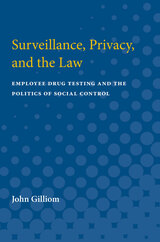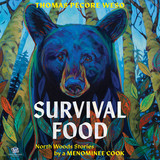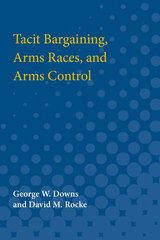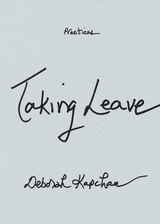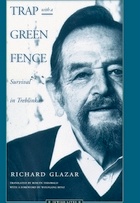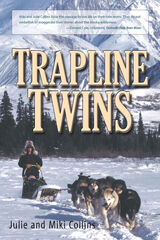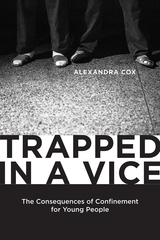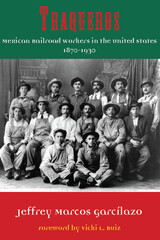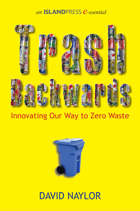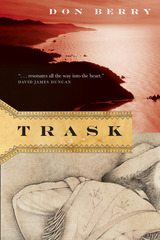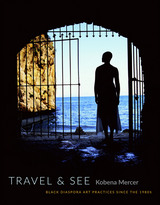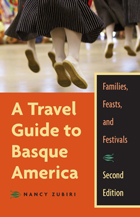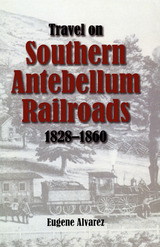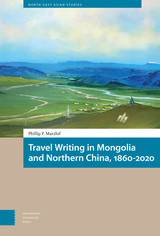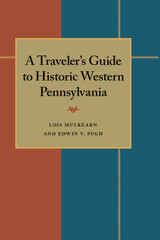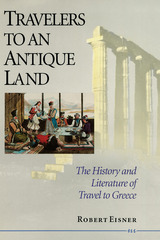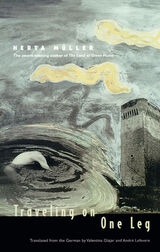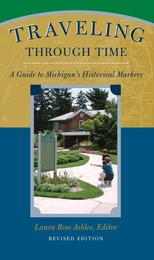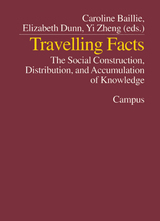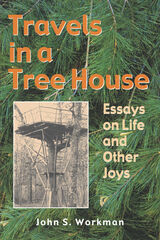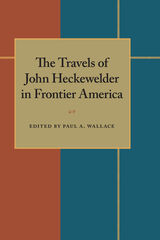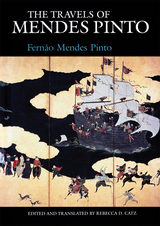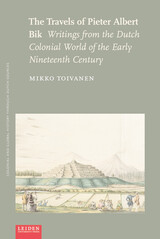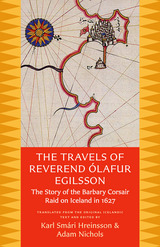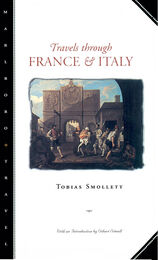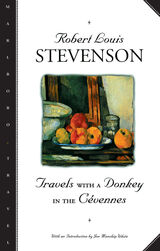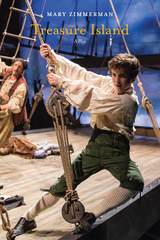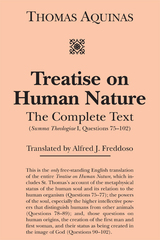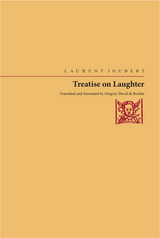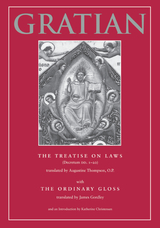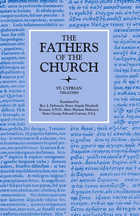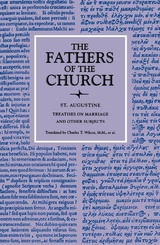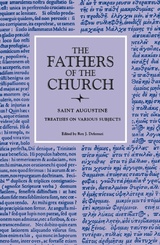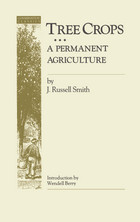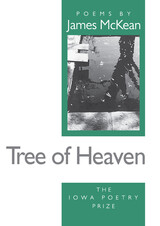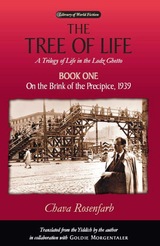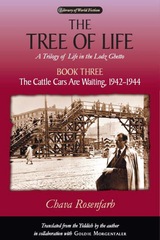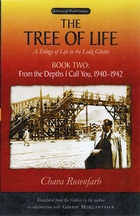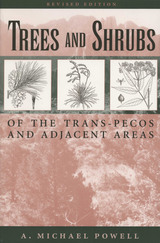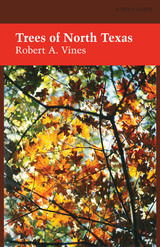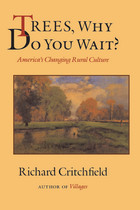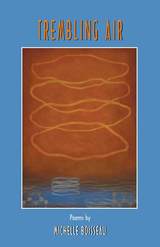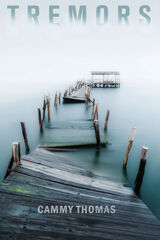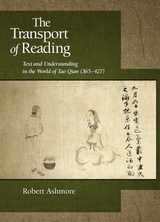 The Transport of Reading: Text and Understanding in the World of Tao Qian (365–427)
Robert Ashmore
Harvard University Press, 2010 For centuries, readers of Tao Qian have felt directly addressed by his poetic voice. This theme in the reception of Tao Qian, moreover, developed alongside an assumption that Tao was fundamentally misunderstood during his own age.
This book revisits Tao’s approach to his readers by attempting to situate it within the particular poetics of address that characterized the Six Dynasties classicist tradition. How would Tao Qian have anticipated that his readers would understand him? No definitive answer is knowable, but this direction of inquiry suggests closer examination of the cultures of reading and understanding of his period. From this inquiry, two interrelated groups of problems emerge as particularly pressing both for Tao Qian and for his contemporaries: first, problems relating to understanding authoritative texts, centered on the relation between meanings and the outward “traces” of those meanings’ expression; second, problems relating to understanding human character, centered on the unworldly scholar—the emblematic figure for the set of values often termed “eremitic.”
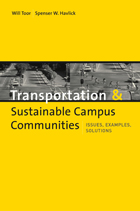 Transportation and Sustainable Campus Communities: Issues, Examples, Solutions
Will Toor and Spenser W. Havlick
Island Press, 2004 Colleges and universities across North America are facing difficult questions about automobile use and transportation. Lack of land for new parking lots and the desire to preserve air quality are but a few of the factors leading institutions toward a new vision based upon expanded transit access, better bicycle and pedestrian facilities, and incentives that encourage less driving. Transportation and Sustainable Campus Communities presents a comprehensive examination of techniques available to manage transportation in campus communities. Authors Will Toor and Spenser W. Havlick give readers the understanding they need to develop alternatives to single-occupancy vehicles, and sets forth a series of case studies that show how transportation demand management programs have worked in a variety of campus communities, ranging from small towns to large cities. The case studies in Transportation and Sustainable Campus Communities highlight what works and what doesn't, as well as describing the programmatic and financial aspects involved. No other book has surveyed the topic and produced viable options for reducing the parking, pollution, land use, and traffic problems that are created by an over-reliance on automobiles by students, faculty, and staff. Transportation and Sustainable Campus Communities is a unique source of information and ideas for anyone concerned with transportation planning and related issues.
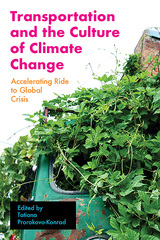 Transportation and the Culture of Climate Change: Accelerating Ride to Global Crisis
Tatiana Prorokova-Konrad
West Virginia University Press, 2020 This interdisciplinary collection of eleven original essays focuses on the environmental impact of transportation, which is, as Tatiana Prorokova-Konrad and Brian C. Black note in their introduction, responsible for 26 percent of global energy use. Approaching mobility not solely as a material, logistical question but as a phenomenon mediated by culture, the book interrogates popular assumptions deeply entangled with energy choices. Rethinking transportation, the contributors argue, necessarily involves fundamental understandings of consumption, freedom, and self.
The essays in Transportation and the Culture of Climate Change cover an eclectic range of subject matter, from the association of bicycles with childhood to the songs of Bruce Springsteen, but are united in a central conviction: “Transport is a considerable part of our culture that is as hard to transform as it is for us to stop using fossil fuels—but we do not have an alternative.”
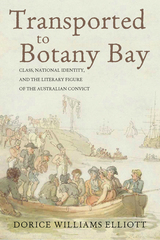 Transported to Botany Bay: Class, National Identity, and the Literary Figure of the Australian Convict
Dorice Williams Elliott
Ohio University Press, 2019 Literary representations of British convicts exiled to Australia were the most likely way that the typical English reader would learn about the new colonies there. In Transported to Botany Bay, Dorice Williams Elliott examines how writers—from canonical ones such as Dickens and Trollope to others who were themselves convicts—used the figure of the felon exiled to Australia to construct class, race, and national identity as intertwined. Even as England’s supposedly ancient social structure was preserved and venerated as the “true” England, the transportation of some 168,000 convicts facilitated the birth of a new nation with more fluid class relations for those who didn’t fit into the prevailing national image. In analyzing novels, broadsides, and first-person accounts, Elliott demonstrates how Britain linked class, race, and national identity at a key historical moment when it was still negotiating its relationship with its empire. The events and incidents depicted as taking place literally on the other side of the world, she argues, deeply affected people’s sense of their place in their own society, with transnational implications that are still relevant today.
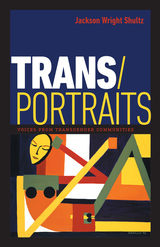 Trans/Portraits: Voices from Transgender Communities
Jackson Wright Shultz
Dartmouth College Press, 2015 Although transgender people are increasingly represented in academic studies and popular culture, they rarely have the opportunity to add their own voices to the conversation. In this remarkable book, Jackson Shultz records the stories of more than thirty Americans who identify as transgender. They range in age from fifteen to seventy-two; come from twenty-five different states and a wide array of racial, religious, and socioeconomic backgrounds; and identify across a vast spectrum of genders and sexualities. Giving voice to a diverse group of individuals, the book raises questions about gender, acceptance, and unconditional love. From historical descriptions of activism to personal stories of discrimination, love, and community, these touching accounts of gender transition shed light on the uncharted territories that lie beyond the gender binary. Despite encounters with familial rejection, drug addiction, and medical malpractice, each account is imbued with optimism and humor, providing a thoughtful look at the daily joys and struggles of transgender life. With an introduction and explanations from the author, this work will appeal to transgender individuals, their significant others, friends, family, and allies; health-care providers, educators, and legal professionals; and anyone questioning their own gender, considering transition, or setting out on their own transition journey.
 Transpsychoanalytics
Sheila L. Cavanagh, special issue editor
Duke University Press, 2017 While psychoanalysis has traditionally been at odds with transgender issues, a growing body of revisionist psychoanalytic theory and clinical practice has begun to tease out the trans-affirming potential of the field. This issue features essays that highlight this potential by simultaneously critiquing and working within the boundaries of psychoanalytic concepts and theories guiding clinical work. Featuring a range of clinicians and scholars, this issue centers on questions pertaining to trans* experience, desire, difference, otherness, identification, loss, mourning, and embodiment. The contributors explore these questions through topics like bathroom bans, ethics, popular culture, and the Freudian couch. By setting up this dialogue between psychosocial studies and trans* cultural studies, this revisionist work may radically transform psychoanalytic theory and practice.
Contributors. Sheila L. Cavanagh, Chris Coffman, Elena Dalla Torre, Kate Foord, Patricia Gherovici, Oren Gozlan, Griffin Hansbury, Jordon Osserman, Amy Ray Stewart, Simon van der Weele
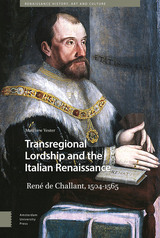 Transregional Lordship and the Italian Renaissance: René de Challant, 1504-1565
Matthew Vester
Amsterdam University Press, 2020 René de Challant, whose holdings ranged from northwestern Italy to the Alps and over the mountains into what is today western Switzerland and eastern France, was an Italian and transregional dynast. The spatially dispersed kind of lordship that he practiced and his lifetime of service to the house of Savoy, especially in the context of the Italian Wars, show how the Sabaudian lands, neighboring Alpine states, and even regions further afield were tied to the history of the Italian Renaissance. Situating René de Challant on the edge of the Italian Renaissance helps us to understand noble kin relations, political networks, finances, and lordship with more precision. A spatially inflected analysis of René’s life brings to light several themes related to transregional lordship that have been obscured due to the traditional tendencies of Renaissance studies. It uncovers an ‘Italy’ whose boundaries extend not just into the Mediterranean, but into regions beyond the Alps.
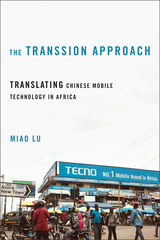 The Transsion Approach: Translating Chinese Mobile Technology in Africa
Miao Lu
University of Illinois Press, 2025 How do we explain China’s tech rise in Africa? As Africa’s top phone seller, the Shenzhen-based company Transsion has profoundly shaped the continent’s digital transformation by providing affordable yet feature-rich mobile phones for the economically disadvantaged. Miao Lu draws on rich fieldwork in China and Ghana to delve into the company’s operations and growing influence. Critiquing technology transfer, Lu focuses on design, marketing, and repair to illustrate the multi-layered technology translations between China and Ghana. Borrowing the metaphor of deep ploughing, Lu examines the rural-centric and lower-class–oriented approach of translating mobile technology. Transsion challenges the cultural imagination of big tech. But the company is also evolving into a regional power that’s adept at marginalizing small players and increasing local dependence. Lu’s analysis explores the complexity that Shenzhen can act as Silicon Valley’s “South” and Africa’s “North” simultaneously. The middle space created by Transsion bridges globalization from above and below, which opens the door to new possibilities and inequalities.
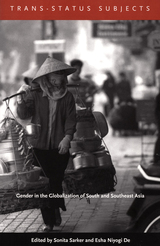 Trans-Status Subjects: Gender in the Globalization of South and Southeast Asia
Sonita Sarker and Esha Niyogi De, eds.
Duke University Press, 2002 A Thai foodseller on the streets of Bangkok, a cyclo driver in a Vietnamese village, a Pahari migrant laborer in the Himalayas, a Parsi-Christian professional social worker shuttling back and forth between London and Calcutta— Trans-Status Subjects examines how these and other South and Southeast Asians affect and are affected by globalization. While much work has focused on the changes wrought by globalization—describing how people maintain foundations or are permanently destabilized—this collection theorizes the complex ways individuals negotiate their identities and create alliances in the midst of both stability and instability, as what the editors call trans-status subjects. Using gender paradigms, historical time, and geographic space as driving analytic concerns, the essays gathered here consider the various ways South and Southeast Asians both perpetuate and resist various hierarchies despite unequal mobilities within economic, social, cultural, and political contexts. The contributors—including literary and film theorists, geographers, historians, sociologists, and anthropologists—show how the dominant colonial powers prefigured the ideologies of gender and sexuality that neocolonial nation-states have later refigured; investigate economic and artistic production; and explore labor, capital, and social change. The essays cover a range of locales—including Sri Lanka, Vietnam, Thailand, Singapore, Borneo, Indonesia, and the United States. In investigating issues of power, mobility, memory, and solidarity in recent eras of globalization, the contributors—scholars and activists from South Asia, Southeast Asia, England, Australia, Canada, and the United States—illuminate various facets of the new concept of trans-status subjects. Trans-Status Subjects carves out a new area of inquiry at the intersection of feminisim and critical geography, as well as globalization, postcolonial, and cultural studies. Contributors. Anannya Bhattacharjee, Esha Niyogi De, Karen Gaul, Ketu Katrak, Karen Leonard, Philippa Levine, Kathryn McMahon, Andrew McRae, Susan Morgan, Nihal Perera, Sonita Sarker, Jael Silliman, Sylvia Tiwon, Gisele Yasmeen
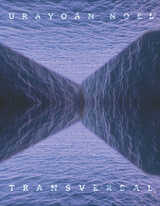 Transversal: Poems
Urayoán Noel
University of Arizona Press, 2021 Transversal takes a disruptive approach to poetic translation, opening up alternative ways of reading as poems get translated or transcreated into entirely new pieces. In this collection, Urayoán Noel masterfully examines his native Puerto Rico and the broader Caribbean as sites of transversal poetics and politics. Featuring Noel’s bilingual playfulness, intellect, and irreverent political imagination, Transversal contains personal reflections on love, desire, and loss filtered through a queer approach to form, expanding upon Noel’s experiments with self-translation in his celebrated collection Buzzing Hemisphere/Rumor Hemisférico. This collection explores walking poems improvised on a smartphone, as well as remixed classical and experimental forms. Poems are presented in interlocking bilingual versions that complicate the relationship between translation and original, and between English and Spanish as languages of empire and popular struggle. The book creatively examines translation and its simultaneous urgency and impossibility in a time of global crisis. Transversal seeks to disrupt standard English and Spanish, and it celebrates the nonequivalence between languages. Inspired by Caribbean poet and philosopher Édouard Glissant, the collection celebrates Caribbean practices of creolization as maximalist, people-centered, affect-loaded responses to the top-down violence of austerity politics. This groundbreaking, modular approach to poetic translation opens up alternative ways of reading in any language .
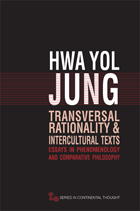 Transversal Rationality and Intercultural Texts: Essays in Phenomenology and Comparative Philosophy
Hwa Yol Jung
Ohio University Press, 2011 Transversality is the keyword that permeates the spirit of these thirteen essays spanning almost half a century, from 1965 to 2009. The essays are exploratory and experimental in nature and are meant to be a transversal linkage between phenomenology and East Asian philosophy. Transversality is the concept that dispels all ethnocentrisms, including Eurocentrism. In the globalizing world of multiculturalism, Eurocentric universalism falls far short of being universal but simply parochial at the expense of the non-Western world. Transversality is intercultural, interspecific, interdisciplinary, and intersensorial. Transversal Rationality and Intercultural Texts means to transform the very way of philosophizing itself by infusing or hybridizing multiple traditions in the history of the world. Like no other scholar, Jung bridges the gap between Asian and Western cultures. By engaging Western philosophers as diverse as Bacon, Descartes, Heidegger, Hegel, Merleau-Ponty, Derrida, Glissant, Barthes, Fenollosa, McLuhan, and Eastern philosophers such as Wang Yang-ming, Nishida Kitaro, Nishitani Keiji, Watsuji Tetsuro, Nhat Hanh, and Suzuki Daisetz Teitaro, this book marks an unparalleled contribution to comparative philosophy and the study of philosophy itself.
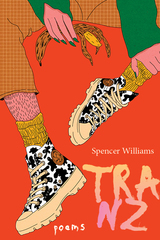 TRANZ
Spencer Williams
Four Way Books, 2024 In her debut collection, TRANZ, Spencer Williams writes equally riotous and vulnerable poems, penning a love letter to trans people and their audacity to exist in a world that constantly endangers them structurally and individually. Her blistering lyrics and acerbic wit never flatten her subjects but rather filet normative hypocrisy to reveal unspoken truths. Williams observes, “i am not dangerous until i’m made in the mouth / of someone who fears me,” and remembers receiving apologies whose “guilty resonance burns / like a wet willy from god.” She articulates a vast landscape of physical and ideological violence against trans people by illuminating this fundamental paradox: “i can’t fear u less until u fear me less—.” And yet the radical poetics of TRANZ is a celebratory self-becoming. Because of Williams’ subversive genius and lyrical grace, every indictment is also a declaration of triumph, a reminder that the ever-dynamic trans community continues to thrive despite, not through, its opposition to an antagonistic cultural discourse. In every place, in every time, trans people are enduring. Extant. “on the milk carton. on the public access / television. everywhere i go i am there so brutally.”
Trap with a Green Fence: Survival in Treblinka
Richard Glazar
Northwestern University Press, 1995 Trap with a Green Fence is Richard Glazar's memoir of deportation, escape, and survival. In economical prose, Glazar weaves a description of Treblinka and its operations into his evocation of himself and his fellow prisoners as denizens of an underworld. Glazar gives us compelling images of these horrors in a tone that remains thoughtful but sober, affecting but simple.
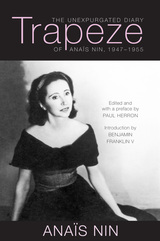 Trapeze: The Unexpurgated Diary of Anaïs Nin, 1947–1955
Anaïs Nin
Ohio University Press, 2017 Anaïs Nin made her reputation through publication of her edited diaries and the carefully constructed persona they presented. It was not until decades later, when the diaries were published in their unexpurgated form, that the world began to learn the full details of Nin’s fascinating life and the emotional and literary high-wire acts she committed both in documenting it and in defying the mores of 1950s America. Trapeze begins where the previous volume, Mirages, left off: when Nin met Rupert Pole, the young man who became not only her lover but later her husband in a bigamous marriage. It marks the start of what Nin came to call her “trapeze life,” swinging between her longtime husband, Hugh Guiler, in New York and her lover, Pole, in California, a perilous lifestyle she continued until her death in 1977. Today what Nin did seems impossible, and what she sought perhaps was impossible: to find harmony and completeness within a split existence. It is a story of daring and genius, love and pain, largely unknown until now.
Trapline Twins
Julie and Miki Collins
University of Alaska Press, 2005 Identical twins Miki and Julie Collins lead a subsistence life in a remote area north of the Alaska Range in Alaska’s wild interior. This dual autobiography of adventure shines with their love of the wilderness and of the sled dogs that are their loyal companions
Trapped in a Vice: The Consequences of Confinement for Young People
Cox, Alexandra
Rutgers University Press, 2018 Winner of the 2019 Outstanding Book Award - ASC DCCSJ
Trapped in a Vice explores the consequences of a juvenile justice system that is aimed at promoting change in the lives of young people, yet ultimately relies upon tools and strategies that enmesh them in a system that they struggle to move beyond. The system, rather than the crimes themselves, is the vice. Trapped in a Vice explores the lives of the young people and adults in the criminal justice system, revealing the ways that they struggle to manage the expectations of that system; these stories from the ground level of the justice system demonstrate the complex exchange of policy and practice.
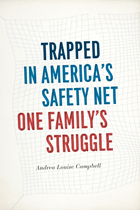 Trapped in America's Safety Net: One Family's Struggle
Andrea Louise Campbell
University of Chicago Press, 2014 When Andrea Louise Campbell’s sister-in-law, Marcella Wagner, was run off the freeway by a hit-and-run driver, she was seven-and-a-half months pregnant. She survived—and, miraculously, the baby was born healthy. But that’s where the good news ends. Marcella was left paralyzed from the chest down. This accident was much more than just a physical and emotional tragedy. Like so many Americans—50 million, or one-sixth of the country’s population—neither Marcella nor her husband, Dave, who works for a small business, had health insurance. On the day of the accident, she was on her way to class for the nursing program through which she hoped to secure one of the few remaining jobs in the area with the promise of employer-provided insurance. Instead, the accident plunged the young family into the tangled web of means-tested social assistance.
As a social policy scholar, Campbell thought she knew a lot about means-tested assistance programs. What she quickly learned was that missing from most government manuals and scholarly analyses was an understanding of how these programs actually affect the lives of the people who depend on them. Using Marcella and Dave’s situation as a case in point, she reveals their many shortcomings in Trapped in America’s Safety Net. Because American safety net programs are designed for the poor, Marcella and Dave first had to spend down their assets and drop their income to near-poverty level before qualifying for help. What’s more, to remain eligible, they will have to stay under these strictures for the rest of their lives, meaning they are barred from doing many of the things middle-class families are encouraged to do: Save for retirement. Develop an emergency fund. Take advantage of tax-free college savings. And, while Marcella and Dave’s story is tragic, the financial precariousness they endured even before the accident is all too common in America, where the prevalence of low-income work and unequal access to education have generated vast—and growing—economic inequality. The implementation of Obamacare has cut the number of uninsured and underinsured and reduced some of the disparities in coverage, but it continues to leave too many people open to tremendous risk.
Behind the statistics and beyond the ideological battles are human beings whose lives are stunted by policies that purport to help them. In showing how and why this happens, Trapped in America’s Safety Net offers a way to change it.
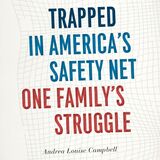 Trapped in America's Safety Net: One Family's Struggle
Andrea Louise Campbell
University of Chicago Press, 2014 This is an auto-narrated audiobook version of this book.
When Andrea Louise Campbell’s sister-in-law, Marcella Wagner, was run off the freeway by a hit-and-run driver, she was seven-and-a-half months pregnant. She survived—and, miraculously, the baby was born healthy. But that’s where the good news ends. Marcella was left paralyzed from the chest down. This accident was much more than just a physical and emotional tragedy. Like so many Americans—50 million, or one-sixth of the country’s population—neither Marcella nor her husband, Dave, who works for a small business, had health insurance. On the day of the accident, she was on her way to class for the nursing program through which she hoped to secure one of the few remaining jobs in the area with the promise of employer-provided insurance. Instead, the accident plunged the young family into the tangled web of means-tested social assistance.
As a social policy scholar, Campbell thought she knew a lot about means-tested assistance programs. What she quickly learned was that missing from most government manuals and scholarly analyses was an understanding of how these programs actually affect the lives of the people who depend on them. Using Marcella and Dave’s situation as a case in point, she reveals their many shortcomings in Trapped in America’s Safety Net. Because American safety net programs are designed for the poor, Marcella and Dave first had to spend down their assets and drop their income to near-poverty level before qualifying for help. What’s more, to remain eligible, they will have to stay under these strictures for the rest of their lives, meaning they are barred from doing many of the things middle-class families are encouraged to do: Save for retirement. Develop an emergency fund. Take advantage of tax-free college savings. And, while Marcella and Dave’s story is tragic, the financial precariousness they endured even before the accident is all too common in America, where the prevalence of low-income work and unequal access to education have generated vast—and growing—economic inequality. The implementation of Obamacare has cut the number of uninsured and underinsured and reduced some of the disparities in coverage, but it continues to leave too many people open to tremendous risk.
Behind the statistics and beyond the ideological battles are human beings whose lives are stunted by policies that purport to help them. In showing how and why this happens, Trapped in America’s Safety Net offers a way to change it.
 Trappings: Stories of Women, Power, and Clothing
Ludwig, Tiffany
Rutgers University Press, 2007 What do you wear that makes you feel powerful? How about the woman next to you at the bank? In line with you at the store? Think about your mother. What would she put on to reveal her power source to the world? These are the questions that inspired Tiffany Ludwig and Renee Piechocki to embark on an interview journey across the United States. Over a period of six years, they talked with more than 500 women and girls, ages four through ninety-two, who ranged from office workers to drag-kings, stay-at-home moms to attorneys, fashion industry executives to elected officials, students to cowgirls. It is these women’s sensitive, funny, and always revealing thoughts that are at the heart of Trappings—a book that although it begins with a question about clothing is not about fashion at all. Here, clothing is simply a vehicle to access a larger dialogue about a diverse range of issues women face related to power and identity, including what expectations and limitations are placed upon them by their affiliation with a specific gender, culture, race, class, or profession. A complex spectrum of responses include discussions about the importance of clothing’s comfort and practicality, how clothing can facilitate women’s movement through class and social strata, how sex is used strategically in business and social settings, and how clothing can be used to empower women by connecting them with cultural or personal history. Complimented by 148 color and black-and-white photographs, the visual and written portraits in this book reveal much more than the contents of women’s closets. Through the intimate lens of clothing, Ludwig and Piechocki expose the very personal ways that power is sought, experienced, and projected by women.
 Traps
Sondra Spatt Olsen
University of Iowa Press, 1991 Heroines in Sondra Spatt Olsen's compelling stories often find themselves in bad situations: a wife with an irresponsible husband, an older woman who wants to leave her younger lover, a suburban housewife who wants sex with her doctor, a teacher who falls in love with her student, a young girl haunted by her mother's judgments, a demanding career woman unsettled by her boyfriend's success, a young woman who finds that her friends, when drunk, are potential murderers. But just as Chekhov gives us pleasure from moments of pain, Olsen illuminates the universal humor and pathos of bad situations. Olsen brings bright wit, fresh empathy, and a generous dose of psychological insight to themes of abandonment and humiliation—her fiction offers a sort of transcendence from pain. These haunting, unsparing stories are not afraid to confront life's traps and pitfalls, but they do so with a celebration of the courage that rises amid the confusion all of us face.
The Traps
Louise Mathias
Four Way Books, 2013 Weaving together violence and beauty—“the beginning of war was also a blossom”—The Traps is a lyric collection that refuses a straight-forward narrative. Rather, each poem uses images to evoke an array of emotions: passion, terror, longing. These compact, yet intricate poems explore “traps” in the word’s many connotations; whether we are in “the narrowest spaces” or “tied to the rafters,” we are tempted, lured, and ambushed.
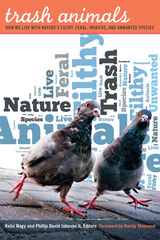 Trash Animals: How We Live with Nature’s Filthy, Feral, Invasive, and Unwanted Species
Kelsi Nagy
University of Minnesota Press, 2013
Why are some species admired or beloved while others are despised? An eagle or hawk circling overhead inspires awe while urban pigeons shuffling underfoot are kicked away in revulsion. Fly fishermen consider carp an unwelcome trash fish, even though the trout they hope to catch are often equally non-native. Wolves and coyotes are feared and hunted in numbers wildly disproportionate to the dangers they pose to humans and livestock.
In Trash Animals, a diverse group of environmental writers explores the natural history of wildlife species deemed filthy, unwanted, invasive, or worthless, highlighting the vexed relationship humans have with such creatures. Each essay focuses on a so-called trash species—gulls, coyotes, carp, cockroaches, magpies, prairie dogs, and lubber grasshoppers, among others—examining the biology and behavior of each in contrast to the assumptions widely held about them. Identifying such animals as trash tells us nothing about problematic wildlife but rather reveals more about human expectations of, and frustrations with, the natural world. By establishing the unique place that maligned species occupy in the contemporary landscape and in our imagination, the contributors challenge us to look closely at these animals, to reimagine our ethics of engagement with such wildlife, and to question the violence with which we treat them. Perhaps our attitudes reveal more about humans than they do about the animals. Contributors: Bruce Barcott; Charles Bergman, Pacific Lutheran U; James E. Bishop, Young Harris College; Andrew D. Blechman; Michael P. Branch, U of Nevada, Reno; Lisa Couturier; Carolyn Kraus, U of Michigan–Dearborn; Jeffrey A. Lockwood, U of Wyoming; Kyhl Lyndgaard, Marlboro College; Charles Mitchell, Elmira College; Kathleen D. Moore, Oregon State U; Catherine Puckett; Bernard Quetchenbach, Montana State U, Billings; Christina Robertson, U of Nevada, Reno; Gavan P. L. Watson, U of Guelph, Ontario, Canada.
Trash Backwards: Innovating Our Way to Zero Waste
David Naylor
Island Press, 2012 Trash Backwards: Innovating Our Way to Zero Waste examines the various kinds of trash Americans are producing in staggering quantities, and profiles a range of innovative processes, people, and companies who are thinking creatively about how to not just reduce pressure on landfills, but redefine what’s possible in the realm of recycling. This E-ssential offers insights into the motivations and inspirations of people working on cutting edge processes of waste management and land reclamation in America—from household trash to biowaste processing to reclaiming brownfields. We’re at a critical juncture with our waste production— and among all of the other problems on Earth (climate change, war, stagnant economies), this is the one that ingenuity, as well as a little old-fashioned conservation, can put a big dent in, if not solve.
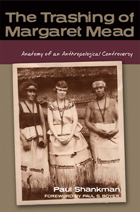 The Trashing of Margaret Mead: Anatomy of an Anthropological Controversy
Paul Shankman; Foreword by Paul S. Boyer
University of Wisconsin Press, 2009 In 1928 Margaret Mead published Coming of Age in Samoa, a fascinating study of the lives of adolescent girls that transformed Mead herself into an academic celebrity. In 1983 anthropologist Derek Freeman published a scathing critique of Mead’s Samoan research, badly damaging her reputation. Resonating beyond academic circles, his case against Mead tapped into important public concerns of the 1980s, including sexual permissiveness, cultural relativism, and the nature/nurture debate. In venues from the New York Times to the TV show Donahue, Freeman argued that Mead had been “hoaxed” by Samoans whose innocent lies she took at face value.
In The Trashing of Margaret Mead, Paul Shankman explores the many dimensions of the Mead-Freeman controversy as it developed publicly and as it played out privately, including the personal relationships, professional rivalries, and larger-than-life personalities that drove it. Providing a critical perspective on Freeman’s arguments, Shankman reviews key questions about Samoan sexuality, the alleged hoaxing of Mead, and the meaning of the controversy. Why were Freeman’s arguments so readily accepted by pundits outside the field of anthropology? What did Samoans themselves think? Can Mead’s reputation be salvaged from the quicksand of controversy? Written in an engaging, clear style and based on a careful review of the evidence, The Trashing of Margaret Mead illuminates questions of enduring significance to the academy and beyond. 2010 Distinguished Lecturer in Anthropology at the American Museum of Natural History “The Trashing of Margaret Mead reminds readers of the pitfalls of academia. It urges scholars to avoid personal attacks and to engage in healthy debate. The book redeems Mead while also redeeming the field of anthropology. By showing the uniqueness of the Mead-Freeman case, Shankman places his continued confidence in academia, scholars, and the field of anthropology.”—H-Net Reviews
Trask
Don Berry
Oregon State University Press, 2004 Set in 1848 on the wild edge of the continent, in the rainforests and rugged headlands of the Oregon coast, Trask follows a mountain man's quest for new opportunities and new land to settle. Elbridge Trask is a restless man, a gambler with God, nature, and life itself. Yearning for change, he sets out with Wakila, a young Clatsop Indian, and Charley Kehwa, a tamanawis man or spiritual leader of the tribe, on an extraordinary journey of discovery.
Trask is at once a gripping tale of adventure and a portrayal of one man's return to the naked simplicity of life. Inspired by his belief in the transcendent power of nature, his fascination with Eastern philosophy, and the lives of historical men and women, Don Berry created a story that is strongly imagined and powerfully rendered-a landmark work. This new edition of Berry's celebrated first novel includes an introduction by Jeff Baker, book critic for The Oregonian.
 Traslados/Translations: Essays on Latin America in Honour of Jason Wilson
Edited by Claire Lindsay
University of London Press, 2012 This volume is an investigation of some of the enduring preoccupations of one of the UK's foremost Latin Americanists. The essays, by a distinguished group of scholars including former students, colleagues, and intellectual interlocutors, reflect a number of Jason Wilson's many research interests. They continue conversations with Wilson and develop lines of enquiry fostered by his work in areas as diverse as travel, translation, cultural and intellectual history, and literary and visual culture.At the same time, the essays address a wide selection of important topics in Latin American studies and contribute to our understanding of the region's culture and history (for example, by engaging with recent historical re-evaluations of Alexander von Humboldt, amplifying the emerging scholarship on post conflict visual representations of Argentina, and enriching our knowledge of the works of writers such as Jorge Luis Borges and Alejandra Pizarnik.)
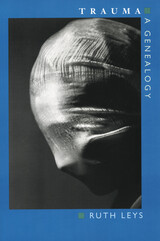 Trauma: A Genealogy
Ruth Leys
University of Chicago Press, 2000 Psychic trauma is one of the most frequently invoked ideas in the behavioral sciences and the humanities today. Yet bitter disputes have marked the discussion of trauma ever since it first became an issue in the 1870s, growing even more heated in recent years following official recognition of post-traumatic stress disorder (PTSD).
In a book that is bound to ignite controversy, Ruth Leys investigates the history of the concept of trauma. She explores the emergence of multiple personality disorder, Freud's approaches to trauma, medical responses to shellshock and combat fatigue, Sándor Ferenczi's revisions of psychoanalysis, and the mutually reinforcing, often problematic work of certain contemporary neurobiological and postmodernist theorists. Leys argues that the concept of trauma has always been fundamentally unstable, oscillating uncontrollably between two competing models, each of which tends at its limit to collapse into the other.
A powerfully argued work of intellectual history, Trauma will rewrite the terms of future discussion of its subject.
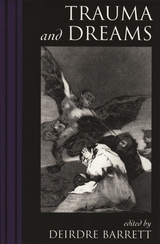 Trauma and Dreams
Deirdre Barrett
Harvard University Press, 1996 According to the poet Elias Canetti, “All the things one has forgotten / scream for help in dreams.” To the ancient Egyptians they were prophecies, and in world folklore they have often marked visitations from the dead. For Freud they were expressions of “wish fulfillment,” and for Jung, symbolic representations of mythical archetypes. Although there is still much disagreement about the significance and function of dreams, they seem to serve as a barometer of current mind and body states.
In this volume, Deirdre Barrett brings together the study of dreams and the psychology of trauma. She has called on a distinguished group of psychiatrists, psychologists, and social workers—among them Rosalind Cartwright, Robert J. Lifton, and Oliver Sacks—to consider how trauma shapes dreaming and what the dreaming mind might reveal about trauma. The book focuses on catastrophic events, such as combat, political torture, natural disasters, and rape. The lasting effects of childhood trauma, such as sexual abuse or severe burns, on personality formation, the nature of memories of early trauma, and the development of defenses related to amnesia and dissociation are all considered. The book also takes up trauma and adult dreams, including Vietnam veterans and Post-Traumatic Stress Disorder, Holocaust survivors and perpetrators, rape victims, and firestorm survivors. Finally, this volume concludes with a look at the potential “traumas of normal life,” such as divorce, bereavement, and life-threatening illness, and the role of dreams in working through normal grief and loss.
Taken together, these diverse perspectives illuminate the universal and the particular effects of traumatic experience. For physicians and clinicians, determining the etiology of nightmares offers valuable diagnostic and therapeutic insights for individual treatment. This book provides a way of juxtaposing the research in the separate fields of trauma and dreams, and learning from their discoveries.
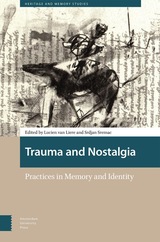 Trauma and Nostalgia: Practices in Memory and Identity
Lucien van Liere
Amsterdam University Press, 2024 This volume reflects on the significance of nostalgia in the construction of traumatic pasts, both on an individual and a collective level. By employing an interdisciplinary approach, the volume enhances our understanding of how the entanglements of trauma and nostalgia influence the construction and development of identity. Scholars from a range of academic disciplines and contexts explore the integration of nostalgic memories in discussions of trauma, attending to their interactions in public spaces, patriotic symbolism and rituals, popular culture, cinema, religion, museums, and memorials. The contributors emphasize the role of media and other mass-cultural technologies in disseminating images and narratives related to traumatic and nostalgic experiences. These essays ultimately bring to light the frequently overlooked role of nostalgic longing in shaping the discursive, visual, and material aspects of collective trauma.
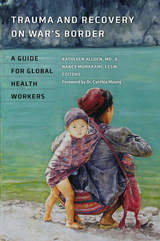 Trauma and Recovery on War's Border: A Guide for Global Health Workers
Edited by Kathleen Allden and Nancy Murakami
Dartmouth College Press, 2015 An increasing number of students and professionals are choosing to travel the globe to engage with the realities of trauma and human suffering through mental health aid. But in the field of global mental health, good intentions are not enough to ensure good training, development, and care. The risk of harm is real when outsiders deliver mental health aid in culturally inappropriate and otherwise naïve ways. This book, based on the experiences of the co-editors and their colleagues at Burma Border Projects (BBP), a nonprofit organization dedicated to the mental health and psychosocial well-being of the displaced people of Burma, sets out global mental health theory allied with local perspectives, experiences, real-life challenges, strengths, and best practices. Topics include assessment and intervention protocols, vulnerable groups and the special challenges they present, and supervision and evaluation programs. An introduction by the editors establishes the political and health contexts for the volume. Written in a style appropriate for academic audiences and lay readers, this book will serve as a fundamental text for clinicians, interns, volunteers, and researchers who work in regions of the world that have suffered the violence of war, forced displacement, human rights violations, poverty, and oppression.
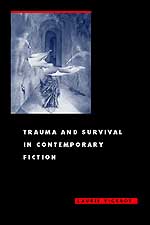 Trauma and Survival in Contemporary Fiction
Laurie Vickroy
University of Virginia Press, 2002 In an exploration of how contemporary fiction narratives represent trauma--that response to events so overwhelmingly intense that normal responses become impaired--Laurie Vickroy engages a wealth of the twentieth century's most striking literature. Toni Morrison's Beloved and Jazz, Marguerite Duras's The Lover, Dorothy Allison's Bastard out of Carolina, Jamaica Kincaid's The Autobiography of My Mother, and Larry Heinemann's Paco's Story, among others, are the source of Vickroy's study investigating the complex relationship between sociocultural influences and intimate personal relations portrayed in trauma fiction and how those portrayals direct this difficult material to readers.
Vickroy's study is unique in its use of trauma, postcolonial, and object relations theories to illuminate the cultural aspects of traumatic experience that shape relationships, identity formation, and the possibilities for symbolization. Vickroy argues that contemporary trauma narratives are indeed personalized responses to this century's emerging awareness of the catastrophic effects on the individual psyche of wars, poverty, colonization, and domestic abuse. She examines these texts as postcolonial attempts to rearticulate the lives and voices of marginalized people, to reject Western conceptions of the autonomous subject, and to recognize the complex negotiations of multicultural social relations.
Trauma is a compelling and evocative topic in the contemporary world and as reflected in its literature. In unraveling trauma's effects, the texts studied in Trauma and Survival in Contemporary Fiction reveal the intricacies of power and the relationship between society's demands and the individual's psychological well-being.
Reviews
"Vickroy's work offers a substantial contribution to the field of trauma studies, a burgeoning area of discourse that has captured the literary imagination of academic scholars in the past decade."
--Suzette Henke, author of Shattered Subjects: Trauma and Testimony in Women's Life-Writing
The Author
Laurie Vickroy is Associate Professor of English at Bradley University.
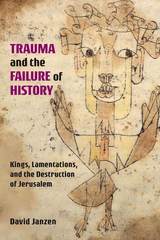 Trauma and the Failure of History: Kings, Lamentations, and the Destruction of Jerusalem
David Janzen
SBL Press, 2019 A theoretical and exegetical exploration of trauma in the Hebrew Bible
David Janzen discusses the concepts of history and trauma and contrasts the ways historians and trauma survivors grapple with traumatic events, a contrast embodied in the very different ways the books of Kings and Lamentations react to the destruction of Jerusalem. Janzen’s study warns that explanations in histories will tend to silence the voices of trauma survivors, and it challenges traditional approaches that sometimes portray the explanations of traumatic events in biblical literature as therapeutic for victims.
Features:
- Exploration of history as a narrative explanation that creates a past readers can recognize to be true
- Examination of how trauma results in a failure of victims to fully experience or remember traumatic events.
- A case for why the past is a construction of cultures and historians
 Trauma and Transcendence in Early Qing Literature
Wilt L. Idema
Harvard University Press, 2006 The collapse of the Ming dynasty and the Manchu conquest of China were traumatic experiences for Chinese intellectuals, not only because of the many decades of destructive warfare but also because of the adjustments necessary to life under a foreign regime. History became a defining subject in their writings, and it went on shaping literary production in succeeding generations as the Ming continued to be remembered, re-imagined, and refigured on new terms.
The twelve chapters in this volume and the introductory essays on early Qing poetry, prose, and drama understand the writings of this era wholly or in part as attempts to recover from or transcend the trauma of the transition years. By the end of the seventeenth century, the sense of trauma had diminished, and a mood of accommodation had taken hold. Varying shades of lament or reconciliation, critical or nostalgic retrospection on the Ming, and rejection or acceptance of the new order distinguish the many voices in these writings.
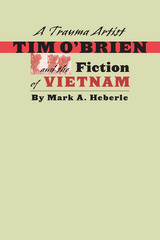 A Trauma Artist: Tim O'Brien and the Fiction of Vietnam
Mark A. Heberle
University of Iowa Press, 2001 A Trauma Artist examines how O'Brien's works variously rewrite his own traumatization during the war in Vietnam as a never-ending fiction that paradoxically "recovers" personal experience by both recapturing and (re)disguising it. Mark Heberle considers O'Brien's career as a writer through the prisms of post-traumatic stress disorder, postmodernist metafiction, and post-World War II American political uncertainties and public violence. Based on recent conversations with O'Brien, previously published interviews, and new readings of all his works through 1999, this book is the first study to concentrate on the role and representation of trauma as the central focus of all O'Brien's works, whether situated in Vietnam, in post-Vietnam America, or in the imagination of protagonists suspended between the two. By doing so, Heberle redefines O'Brien as a major U.S. writer of the late twentieth century whose representations of self-damaging experiences and narratives of recovery characterize not only the war in Vietnam but also relationships between fathers and sons and men and women in the post-traumatic culture of the contemporary United States.
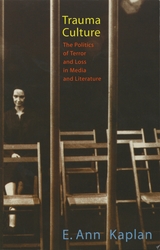 Trauma Culture: The Politics of Terror and Loss in Media and Literature
Kaplan, E. Ann
Rutgers University Press, 2005 It may be said that every trauma is two traumas or ten thousand-depending on the number of people involved. How one experiences and reacts to an event is unique and depends largely on one's direct or indirect positioning, personal psychic history, and individual memories. But equally important to the experience of trauma are the broader political and cultural contexts within which a catastrophe takes place and how it is "managed" by institutional forces, including the media.
In Trauma Culture, E. Ann Kaplan explores the relationship between the impact of trauma on individuals and on entire cultures and nations. Arguing that humans possess a compelling need to draw meaning from personal experience and to communicate what happens to others, she examines the artistic, literary, and cinematic forms that are often used to bridge the individual and collective experience. A number of case studies, including Sigmund Freud's Moses and Monotheism, Marguerite Duras' La Douleur, Sarah Kofman's Rue Ordener, Rue Labat, Alfred Hitchcock's Spellbound, and Tracey Moffatt's Night Cries, reveal how empathy can be fostered without the sensationalistic element that typifies the media.
From World War II to 9/11, this passionate study eloquently navigates the contentious debates surrounding trauma theory and persuasively advocates the responsible sharing and translating of catastrophe.
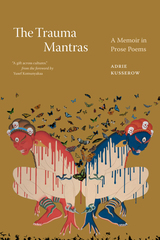 The Trauma Mantras: A Memoir in Prose Poems
Adrie Kusserow
Duke University Press, 2024 The Trauma Mantras is a memoir by medical anthropologist, teacher, and writer Adrie Kusserow, who has worked with refugees and humanitarian projects in Bhutan, Nepal, India, Uganda, South Sudan, and the United States. It is a memoir of witness and humility and, ultimately, a way to critique and gain a fresh perspective on Western approaches to the self, suffering, and healing. Kusserow interrogates the way American culture prizes a psychologized individualism, the supposed fragility of the self. In relentlessly questioning the Western tribe of individualism with a hunger to bust out of such narrow confines, she hints at the importance of widening the American self. As she delves into humanity’s numerous social and political ills, she does not let herself off the hook, reflecting rigorously on her own position and commitments. Kusserow travels the world in these poetic meditations, exploring the desperate fictions that “East” and “West” still cling to about each other, the stories we tell about ourselves and obsessively weave from the dominant cultural meanings that surround us.
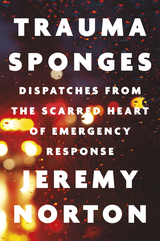 Trauma Sponges: Dispatches from the Scarred Heart of Emergency Response
Jeremy Norton
University of Minnesota Press, 2023 Beyond an adrenaline ride or a chronicle of bravura heroics, this unflinching view of a Minneapolis firefighter reveals the significant toll of emergency response
In this remarkable memoir, Jeremy Norton marshals twenty-two years of professional experience to offer, with compassion and critique, an extraordinary portrayal of emergency responders. Trauma Sponges captures in arresting detail the personal and social toll the job exacts, as well as the unique perspective afforded by sustained direct encounters with the sick, the dying, and the dead. From his first days as a rookie firefighter and emergency medical technician to his command of a company as a twenty-year veteran, Norton documents the life of an emergency responder in Minneapolis: the harrowing, heartbreaking calls, from helping the sick and hurt, to reassuring the scared and nervous, to attempting desperate measures and providing final words. In the midst of the uncertainty, fear, and loss caused by the Covid pandemic, Norton and his crew responded to the scene of George Floyd’s murder. The social unrest and racial injustice Norton had observed for years exploded on the streets of Minneapolis, and he and his fellow firefighters faced the fires, the injured, and the anguish in the days and months that followed. Norton brings brutally honest insight and grave social conscience to his account, presenting a rare insider’s perspective on the insidious role of sexism and machismo in his profession, as well as an intimate observer’s view of individuals trapped in dire circumstances and a society ill equipped to confront trauma and death. His thought-provoking, behind-the-scenes depiction of the work of first response and last resort starkly reveals the realities of humanity at its finest and its worst.
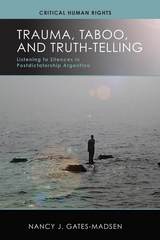 Trauma, Taboo, and Truth-Telling: Listening to Silences in Postdictatorship Argentina
Nancy J. Gates-Madsen
University of Wisconsin Press, 2018 Argentina’s repressive 1976–83 dictatorship, during which an estimated thirty thousand people were “disappeared,” prompted the postauthoritarian administrations and human rights groups to encourage public exposure of past crimes and traumas. Truth commissions, trials, and other efforts have aimed to break the silence and give voice to the voiceless. Yet despite these many reckonings, there are still silences, taboos, and unanswerable questions.
Nancy J. Gates-Madsen reads between the lines of Argentine cultural texts (fiction, drama, testimonial narrative, telenovela, documentary film) to explore the fundamental role of silence—the unsaid—in the expression of trauma. Her careful examination of the interplay between textual and contextual silences illuminates public debate about the meaning of memory in Argentina—which stories are being told and, more important, which are being silenced. The imposition of silence is not limited to the military domain or its apologists, she shows; the human rights community also perpetuates and creates taboos.
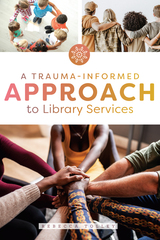 A Trauma-Informed Approach to Library Services
Rebecca Tolley
American Library Association, 2014 We are only now coming to terms with how common trauma really is; a landmark Kaiser study that surveyed patients receiving physicals found that almost two-thirds had experienced at least one form of abuse, neglect, or other trauma as a child. Though originating in the fields of health and social services, trauma-informed care is a framework that holds great promise for application to library work. Empathetic service, positive patron encounters, and a more trusting workplace are only a few of the benefits that this approach offers. In this important book Tolley, experienced in both academic and public libraries, brings these ideas into the library context. Library administrators, directors, and reference and user services staff will all benefit from learning - the six key principles of trauma-informed care;
- characteristics of a trusting and transparent library organization, plus discussion questions to promote a sense of psychological safety among library workers;
- how certain language and labels can undermine mutuality, with suggested phrases that will help library staff demonstrate neutrality to patron ideas and views during information requests;
- delivery models that empower patrons;
- advice on balancing free speech on campus with students’ need for safety;
- how appropriate furniture arrangement can help people suffering from PTSD feel safe;
- guidance on creating safe zones for LGBTQIA+ children, teens, and adults; and
- self-assessment tools to support change toward trauma-responsive library services.
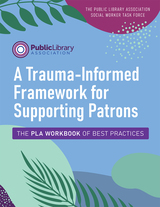 A Trauma-Informed Framework for Supporting Patrons: The PLA Workbook of Best Practices
The Public Library Association Social Worker Task Force
American Library Association, 2022 Whether it’s navigating a crisis or witnessing a community member struggling with tough times, coming face to face with trauma and adversity can be uncomfortable. But in striving to learn more about challenging behaviors, and how we can better interact with library patrons and our coworkers, we can come to see that people are complex and not simply “problems.” This workbook from the PLA Social Worker Task Force (SWTF) provides a collection of powerful tools to add to your customer service toolbox. It’s filled with prompts, exercises, and best practices that shed light on how trauma can affect people, helping you build confidence in your ability to support your library’s patrons. You will - delve into what trauma is and how it impacts library work;
- be introduced to a framework for utilizing a trauma-informed lens in your interactions;
- practice exercises to spur personal reflection on common concerns bound up with library work and the policies relating to these issues; and
- gain hand-on tools and techniques, including strategies for de-escalation and guidance on the impacts of involving law-enforcement and banning patrons.
You will also explore various scenarios which provide the opportunity to integrate what you’ve learned and practice responding through a trauma-informed lens, including - Mental Health Challenges
- Sleeping at the Library
- Strong Personal Odor
- Personal Belongings
- Suspected Intoxication/Under the Influence
- Substance Use
- Threatening Verbal and Nonverbal Behavior
- Unsheltered Teens
- Adult Self-Neglect
- Child Abuse or Assault
- Solicitation or Panhandling
- Stealing
- Child Unattended After Closing
 Traumatic Encounters in Italian Film: Locating the Cinematic Unconscious
Fabio Vighi
Intellect Books, 2006 'Traumatic Encounters' addresses the question of the relationship between psychoanalysis and film in a thoroughly original way, bringing together Lacanian theory and Italian cinema as a means to unravel the deepest kernel of repressed knowledge around which film narratives are constructed. The primary theoretical reference of the book is the Real, the most under-represented of the three Lacanian categories (Symbolic, Imaginary and Real), which designates the traumatic dimension of reality that cannot be integrated in the order of language and communication. Exploring the relationship between film and its unconscious underside, the author argues that only by locating the elusive “traces of the cinematic Real” can a given film narrative be reconstructed in its entirety. Like the Lacanian subject, film here appears as fundamentally split between a traumatic dimension beyond signification (the Real), and awareness of its fragile symbolic status.
Always stylistically innovative, thematically defiant and driven by a strong political agenda, Italian cinema lends itself particularly well to a critical investigation aimed at radicalising the impact of psychoanalysis on film. In doing exactly that, the book deliberately avoids the standard cultural and historical approaches to film. Instead, it moves freely amongst some of the most widely celebrated – as well as lesser-known – Italian films of the post-war period, discussing the ways in which they tackle such themes as desire, fantasy, sexuality, violence and the law, to mention but a few. The main focus is on the work of those directors who most effectively engage with the divisive nature of the moving image: Antonioni, Pasolini and Rossellini. In addition, the book provides ample and insightful references to films by Visconti, Bertolucci, Bellocchio, Moretti, Petri, Fellini, Ferreri, and many more.
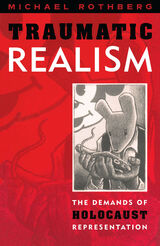 Traumatic Realism: The Demands of Holocaust Representation
Michael Rothberg
University of Minnesota Press, 2000 Analyzes the impact of historical trauma on contemporary culture. How to approach the Holocaust and its relationship to late twentieth-century society? While some stress the impossibility of comprehending this event, others attempt representations in forms as different as the nonfiction novel (and Hollywood blockbuster) Schindler’s List, the documentary Shoah, and the comic book Maus. This problem is at the center of Michael Rothberg’s book, a focused account of the psychic, intellectual, and cultural aftermath of the Holocaust. Drawing on a wide range of texts, Michael Rothberg puts forth an overarching framework for understanding representations of the Holocaust. Through close readings of such writers and thinkers as Theodor Adorno, Maurice Blanchot, Ruth Klüger, Charlotte Delbo, Art Spiegelman, and Philip Roth and an examination of films by Steven Spielberg and Claude Lanzmann, Rothberg demonstrates how the Holocaust as a traumatic event makes three fundamental demands on representation: a demand for documentation, a demand for reflection on the limits of representation, and a demand for engagement with the public sphere and commodity culture. As it establishes new grounding for Holocaust studies, his book provides a new understanding of realism, modernism, and postmodernism as responses to the demands of history.
 The Traumatic Screen: The Films of Christopher Nolan
Stuart Joy
Intellect Books, 2020 Christopher Nolan occupies a rare realm within the Hollywood mainstream, creating complex, original films that achieve both critical acclaim and commercial success. In The Traumatic Screen, Stuart Joy builds on contemporary applications of psychoanalytic film theory to consider the function and presentation of trauma across Nolan’s work, arguing that the complexity, thematic consistency, and fragmentary nature of his films mimic the structural operation of trauma.
From 1997’s Doodlebug to 2017’s Dunkirk, Nolan’s films highlight cinema’s ability to probe the nature of human consciousness while commenting on the relationship between spectator and screen. Joy examines Nolan’s treatment of trauma—both individual and collective—through the formal construction, mise-en-scène, and repeated themes of his films. The argument presented is based on close textual analysis and a methodological framework that incorporates the works of Sigmund Freud and Jacques Lacan. The first in-depth, overtly psychoanalytic understanding of trauma in the context of the director’s filmography, this book builds on and challenges existing scholarship in a bold new interpretation of the Nolan canon.
 Traumatic States: Gendered Violence, Suffering, and Care in Chile
Nia Parson
Vanderbilt University Press, 2013 The end of the Pinochet regime in Chile saw the emergence of an organized feminist movement that influenced legal and social responses to gender-based violence, and with it new laws and avenues for reporting violence that never before existed. What emerged were grassroots women's rights organizations, challenging and engaging the government and NGOs to confront long-ignored problems in responding to marginalized victims.
In Traumatic States, anthropologist Nia Parson explores the development of methods of care and recovery from domestic violence. She interviews and contextualizes the lives of numerous individuals who have confronted these acts, as victims, authorities, and activists. Ultimately, Traumatic States argues that facing the challenges of healing both body and mind, and addressing the fundamental inequalities that make those challenges even more formidable, are part of the same battle.
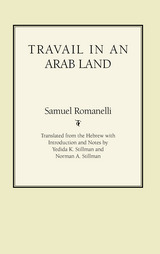 Travail In An Arab Land
Samuel Romanelli
University of Alabama Press, 1989 Samuel Romanelli was a free spirit, a son of the Enlightenment, who spend most of his life travelling in search of adventure, knowledge, and patrons for his literary endeavors. By the early 1780s, Romanelli had travelled from his homeland to England and established himself among the Maskilim, or Jews of the Enlightenment, and patrons of Hebrew culture. Fluent in ten languages, he was a poet and translator of classical and contemporary literature into Hebrew, and apparently he earned a good living.
During a return voyage to Italy in 1786, he became stranded in Gibraltar for an extended time which depleted his funds, and his economic circumstances forced him to join a merchant travelling to Morocco. Through misadventure in Morocco, he lost his passport and was retained in that country for four years, the story of which forms Travail in an Arab Land, first published in 1792 in Berlin. The book is a firsthand account of the author’s adventures during the four years he was stranded in Sharifan Morocco between 1787 and 1790.
 The Travails of Conscience: The Arnauld Family and the Ancien Régime
Alexander Sedgwick
Harvard University Press, 1998 Like the Bouthilliers, the Colberts, the Fouquets, and the Letelliers, the Arnauld family rose to prominence at the end of the sixteenth century by attaching themselves to the king. Their power and influence depended upon absolute loyalty and obedience to the sovereign whose own power they sought to enhance. Dictates of conscience, however, brought all that to an end and put them in conflict with both king and pope. As a result of the religious conversion of Angélique Arnauld early in the seventeenth century, the family eventually adopted a set of religious principles that appeared Calvinist to some ecclesiastical authorities. These "Jansenist" principles were condemned by the papacy and Louis XIV.
The travails of conscience experienced by the Arnauld family, and the resulting religious schism that separated different branches, divided husbands from wives and parents from children. However, neither the historic achievements of individual family members nor the differences of opinion between them could obscure the sense of family solidarity.
The dramatic appeal of this book is underscored by a tumultuous period in French history which coincides with and punctuates the Arnauld family's struggle with the world. We see how this extraordinary family reacted to momentous political and religious developments, as well as the ways in which individual members, by means of their own convictions, helped shape the history of their time.
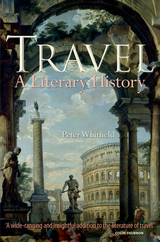 Travel: A Literary History
Peter Whitfield
Bodleian Library Publishing, 2011 Taking the form of fact-filled travelogues, stunt-writing spectaculars, or genre-blurring imaginative works, travel writing has never been more popular than it is today. But beyond the self-conscious literary artistry of today’s narratives lies a rich and well-documented history of travel writing, stretching back over several thousand years and incorporating the work of mariners and missionaries, diplomats and dilettantes alike.
From the ancient world to the present, Peter Whitfield offers the first broad survey to range over the whole history of travel writing, highlighting more than one hundred texts, including works by Marco Polo, T. E. Lawrence, Christopher Columbus, Daniel Defoe, Joseph Conrad, and Captain Cook. Whether their travels were merely for pleasure or the result of exploration, military occupation, or trade, the writers discussed here all sought to reimagine their surroundings and, through their writings, reinterpret them for the reader. Because of that personal, interpretive approach, Whitfield shows, their work inhabits a strange borderland between fact and fiction. Over time, as our travel objectives have changed, so too has the tone of travel writing, eschewing the traditional stance of cultural superiority in favor of a deeper sensitivity to other peoples and places. The book is rounded out by numerous illustrations from manuscripts and books of travel in the collection of the Bodleian Library.
A world-class examination of a little-explored genre, Travel: A Literary History offers an accessible look at the history of travel writing that will make a great addition to any carry-on.
Travel & See: Black Diaspora Art Practices since the 1980s
Kobena Mercer
Duke University Press, 2016 Over the years, Kobena Mercer has critically illuminated the visual innovations of African American and black British artists. In Travel & See he presents a diasporic model of criticism that gives close attention to aesthetic strategies while tracing the shifting political and cultural contexts in which black visual art circulates. In eighteen essays, which cover the period from 1992 to 2012 and discuss such leading artists as Isaac Julien, Renée Green, Kerry James Marshall, and Yinka Shonibare, Mercer provides nothing less than a counternarrative of global contemporary art that reveals how the “dialogical principle” of cross-cultural interaction not only has transformed commonplace perceptions of blackness today but challenges us to rethink the entangled history of modernism as well.
Travel Behaviour Reconsidered in an Era of Decarbonisation
David Metz
University College London, 2024 Makes the case for investment in transport systems in an age of great climate change concern.
Transport systems are central to daily life, but simultaneously have a salient impact on our environment. However, this perspective has little influence on conventional economic analysis and transport investments, creating dissonance between traditional investment goals and the need to reduce carbon emissions to net zero by 2050. For fifty years, public road and railway expenditures were justified by claims to improve travel time. On the contrary, the average time of travel never changed. Travel Behaviour Reconsidered in an Era of Decarbonisation argues that this outdated economic analysis is misconceived and that fresh perspectives on transport networks are imperative.
A Travel Guide To Basque America: Families, Feasts, and Festivals, 2nd Edition
Nancy Zubiri
University of Nevada Press, 2006 A Travel Guide to Basque America—the first-ever guide to America’s Basque-American communities, their history, culture, and festivals—has been a best-seller since it first appeared in 1998. This new edition lists dozens of new restaurants, Basque cultural clubs and cultural events, and hundreds of Basque-related Internet sites that have appeared since 1998. It also includes new information about recent events in the Basque Country, their impact on Basque-Americans, and new cultural and community efforts to preserve Basque culture in America. This is the essential guide for Basque-Americans seeking links to their ancient culture and its homeland and their counterparts in the U.S., as well as for any traveler interested in exploring one of this country’s most vibrant and fascinating ethnic minorities.
 Travel In The Middle Ages
Jean Verdon
University of Notre Dame Press, 2003 As a companion to his previous volume Night in the Middles Ages, Jean Verdon offers insight into the pitfalls and perils of traveling during medieval times. Travel in the Middle Ages is filled with the stories and adventures of those who hazarded hostile landscapes, elements, and people-out of want or necessity-to get from place to place. Verdon contends that a journey in the current sense, suggesting both "the movement of a person who travels to a fairly distant place" and philosophical ideas of distraction and flight from self, did not exist in the Middle Ages. Indeed, he says, "nothing either in the means of communication or in the landscape encouraged travel." And yet, Verdon points out, the world of the Middle Ages was one of unceasing movement.
While most journeys involved very short distances (home to market or village to village), longer trips were not uncommon in the Middle Ages. Clergy were frequently called upon to act as ambassadors, messengers, and overseers to the various monasteries and churches within their jurisdiction. Merchants, agents of the king, and pilgrims were also frequently required to travel. While sharing the fascinating stories of these ordinary wayfarers, Verdon also relates colorful tales of the journeys of notable historical figures such as Marco Polo and Columbus.
Part I of Travel in the Middle Ages addresses the means by which people traveled. This section contains interesting descriptions of modes of conveyance, road systems, sea lanes, tolls, taxes, and even pirates. Knowing the risks involved, why did people brave the uncertainty of travel? Part II of the book addresses this question by identifying five main motivational categories of medieval travel. Part III deals with travel myths, monsters, fictitious journeys of medieval fantasy writers, and ghosts. Verdon concludes with a pithy critique of travel in the modern world.
Appearing for the first time in an English translation, Travel in the Middle Ages will delight anyone with an interest in medieval culture or travel books.
JEAN VERDON is professor emeritus of literature and humanities at Limoges University. He is the author of Night in the Middle Ages, published by the University of Notre Dame Press.
----------
"An original and scholarly work by Jean Verdon … and ably translated into English by George Holoch. An expertly researched history and thoroughly reader friendly descriptive text offers the students and non-specialist general reader alike, a rare and informative insight into life and times of Europeans several centuries past. Travel in the Middle Ages is seminal and enormously important contribution to Medieval Studies reference collections and reading lists." --Midwest Book Review
"[E]ngrossing…. Through Verdon's extensive and skillful use of historic accounts ... the reader learns how travelers coped." --ForeWord's Top Ten: Year 2003
"Verdon has written a fascinating and informative book that is generously interspersed with examples of medieval travel from a constellation of medieval sources…." --History: Reviews of New Books
"General readers, eager to be led on an armchair voyage through medieval times and terrain …[will] find it broadening." --Choice
Travel On Southern Antebellum Railroads, 1828–1860
Eugene Alvarez
University of Alabama Press, 2007 The matter-of-fact descriptive title of this interesting little volume on railroading in the pre–Civil War South does not do justice to Alvarez’s coverage of the subject. Along with his full account of trains and train accommodations, he manages to encompass a number of social, political, and even ideological subjects.
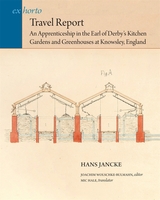 Travel Report: An Apprenticeship in the Earl of Derby’s Kitchen Gardens and Greenhouses at Knowsley, England
Hans Jancke
Harvard University Press, 2013 For centuries, travel was an important part of a gardener's initial and continuing professional training. Educational journeys to parks and gardens at home and abroad were consistently recorded in lengthy reports and articles for professional journals. The travel report by Hans Jancke (1850-1920), a court gardener who served the Prussian kings in Potsdam, Germany, is typical of this genre. Jancke's manuscript, which until now remained unpublished, describes his 1874-1875 apprenticeship at Knowsley, the seat of the Earl of Derby near Liverpool, England. Containing extensive plant lists and detailed descriptions of the horticultural regimens observed in the estate's kitchen gardens and greenhouses, the text is augmented by several measured drawings executed by Jancke. These illustrations include the hothouses used for fruit forcing, vegetable production, and exotic ornamentals, as well as a site plan based on Jancke's own survey data. Professionally focused travel journals of gardeners and garden artists were for a long time ignored as sources to be taken seriously in historical research. But Jancke's eyewitness account, especially as it documents an intense scientific curiosity, demonstrates the potential of these texts for illuminating the more technical and practical aspects of the history of the garden arts.
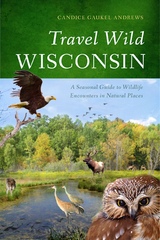 Travel Wild Wisconsin: A Seasonal Guide to Wildlife Encounters in Natural Places
Candice Gaukel Andrews
University of Wisconsin Press, 2013 Have you ever heard a wolf howl in Wisconsin's Northwoods, watched thousands of ancient sturgeon roil the waters of one of the largest inland lakes in the United States, or tagged a monarch butterfly before it begins one of the world's great migrations to its winter habitat in Mexico? Travel Wild Wisconsin is your seasonal guide to genuine wildlife encounters with an amazing array of birds, mammals, fish, and insects in Wisconsin's most beautiful natural settings: state wildlife areas, rivers, lakes, flowages, and preserves as well as national wildlife refuges and forests. Wisconsin native Candice Gaukel Andrews shares natural history and lore, accounts of her own experiences with Wisconsin wildlife, and insights from biologists, environmental educators, and citizen scientists, so that you can seek a wildlife encounter of your own. So come spy on the spring courtship dance of the greater prairie chicken, search for elusive and elegant white-tailed deer in summer, touch a tiny saw-whet owl on one special day in autumn, and thrill to the sound of thousands of tundra swans as they migrate through the Mississippi Flyway just before the first snow falls. Make this the year you Travel Wild Wisconsin.
Travel Writing in Mongolia and Northern China, 1860-2020
Phillip Marzluf
Amsterdam University Press, 2023 1860–2020 invites readers to explore Mongolia as an important cultural space for Western travelers and their audiences over three historical eras. Travelers have framed their experiences and observations through imaginative geographies and Orientalizing discourses, fixing Mongolia as a peripheral, timeless, primitive, and parochial place. Readers can examine the travelers’ literary and rhetorical strategies as they make themselves more credible and authoritative and as they identify themselves with Mongolians and Mongolian culture or, conversely, distance themselves. In this book, readers can also approach travel writing from the perspective of women travelers, Mongolian socialist intellectuals, twenty-first-century travelers, and a Han Chinese writer, Jiang Rong, who promotes cultural harmony yet anticipates the disappearance of Mongolian culture in China.
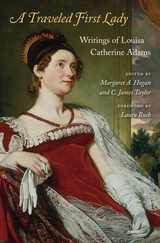 A Traveled First Lady: Writings of Louisa Catherine Adams
Louisa Catherine AdamsEdited by Margaret A. Hogan and C. James Taylor
Harvard University Press, 2014 Congress adjourned on 18 May 1852 for Louisa Catherine Adams’s funeral, according her an honor never before offered a first lady. But her life and influence merited this extraordinary tribute. She had been first the daughter-in-law and then the wife of a president. She had assisted her husband as a diplomat at three of the major capitals of Europe. She had served as a leading hostess and significant figure in Washington for three decades. And yet, a century and a half later, she is barely remembered. A Traveled First Lady: Writings of Louisa Catherine Adams seeks to correct that oversight by sharing Adams’s remarkable experiences in her own words.
These excerpts from diaries and memoirs recount her early years in London and Paris (to this day she is the only foreign-born first lady), her courtship and marriage to John Quincy Adams, her time in the lavish courts of Berlin and St. Petersburg as a diplomat’s wife, and her years aiding John Quincy’s political career in Washington. Emotional, critical, witty, and, in the Adams tradition, always frank, her writings draw sharp portraits of people from every station, both servants and members of the imperial court, and deliver clear, well-informed opinions about the major issues of her day.
Telling the story of her own life, juxtaposed with rich descriptions of European courts, Washington political maneuvers, and the continuing Adams family drama, Louisa Catherine Adams demonstrates why she was once considered one of the preeminent women of the nineteenth century.
 Traveler, Scholar, Political Adventurer: A Transylvanian Baron at the Birth of Albanian Independence: The memoirs of Franz Nopcsa
Robert Elsie
Central European University Press, 2014 The Austro-Hungarian aristocrat of Transylvanian origin, Baron Franz Nopcsa (1877-1933), was one of the most adventuresome travelers and scholars of Southeast Europe in the early decades of the twentieth century. He was also a paleontologist of renown and a noted geologist of the Balkan Peninsula : many of his assumptions have been confirmed by science. The Memoirs of this fascinating figure deal mainly with his travels in the Balkans, and specifically in the remote and wild mountains of northern Albania, in the years from 1903 to 1914. They thus cover the period of Ottoman Rule, the Balkan Wars and the outbreak of the First World War. Nopcsa was a keen adventurer who hiked through regions of northern Albania. With time, he became a leading expert in Albanian studies. He was also deeply involved in the politics of the period. In 1913, Nopcsa even offered himself as a candidate for the vacant Albanian throne. The Introduction also tells of Nopcsa's tragic death: he shot his Albanian secretary and partner before killing himself. The memoirs themselves reveal some references to his homosexuality for those who can read between the lines.
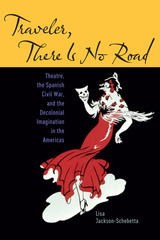 Traveler, There Is No Road: Theatre, the Spanish Civil War, and the Decolonial Imagination in the Americas
Lisa Jackson-Schebetta
University of Iowa Press, 2017 Traveler, There Is No Road offers a compelling and complex vision of the decolonial imagination in the United States from 1931 to 1943 and beyond. By examining the ways in which the war of interpretation that accompanied the Spanish Civil War (1936–1939) circulated through Spanish and English language theatre and performance in the United States, Lisa Jackson-Schebetta demonstrates that these works offered alternative histories that challenged the racial, gender, and national orthodoxies of modernity and coloniality. Jackson-Schebetta shows how performance in the US used histories of American empires, Islamic legacies, and African and Atlantic trades to fight against not only fascism and imperialism in the 1930s and 1940s, but modernity and coloniality itself.
This book offers a unique perspective on 1930s theatre and performance, encompassing the theatrical work of the Cuban, Puerto Rican, and Spanish diasporas in the United States, as well as the better-known Anglophone communities. Jackson-Schebetta situates well-known figures, such as Langston Hughes and Clifford Odets, alongside lesser-known ones, such as Erasmo Vando, Franca de Armiño, and Manuel Aparicio. The milicianas, female soldiers of the Spanish Republic, stride on stage alongside the male fighters of the Lincoln Brigade. They and many others used the multiple visions of Spain forged during the civil war to foment decolonial practices across the pasts, presents, and futures of the Americas. Traveler conclusively demonstrates that theatre and performance scholars must position US performances within the Americas writ broadly, and in doing so they must recognize the centrality of the hemisphere’s longest-lived colonial power, Spain.
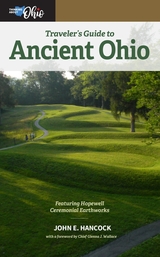 Traveler's Guide to Ancient Ohio
John E. Hancock
Ohio University Press Featuring Hopewell Ceremonial Earthworks Traveler’s Guide to Ancient Ohio is a compact, richly illustrated, and in-depth travel guide to the Indigenous earthwork wonders of southern Ohio—some of the most extraordinary ancient monuments in North America. Featuring the eight newly inscribed UNESCO World Heritage sites, this is the first publication to present these places from a traveler’s perspective, offering deeply informative site descriptions alongside curated routes to historical, scenic, and natural treasures across the region. Southern Ohio’s landscape is layered with millennia of human history. At its heart are the monumental Adena and Hopewell earthworks—vast ceremonial constructions that reflect the ingenuity and spiritual life of ancient Indigenous cultures. This guide helps readers understand these sites as rewarding architectural experiences, enriched by archaeological, historical, and Indigenous knowledge gathered over three decades of collaborative work. Organized into eight scenic driving routes—including the World Heritage Route and seven tributary paths—the book connects earthworks with nearby historic towns, nature preserves, waterways, and cultural landmarks. Each route emphasizes two-lane roads and includes road-tested site addresses, with links to local tourism resources for updated travel information. Introductory sections provide essential context on regional geography, Indigenous cultures, archaeological terminology, and travel logistics. The guide’s focus on on-site appreciation is rare among existing resources, making it invaluable for both pre-visit planning and on-the-ground exploration. Detailed route and trail descriptions are coordinated with all-new maps, plans, and photographs. The book links to multimedia assets, including animated flyovers that help visualize the earthworks and interview excerpts that deepen interpretive storytelling through Indigenous and interdisciplinary voices. For first-time visitors and seasoned explorers, Traveler’s Guide to Ancient Ohio offers a fresh, immersive way to experience the region’s ancient wonders and the landscapes that continue to tell their story.
A Traveler's Guide to Historic Western Pennsylvania
Lois Mulkearn
University of Pittsburgh Press, 1953 This book presents a county-by-county guide to historic landmarks in western Pennsylvania, and how to reach them. Twenty-seven counties are included, along with maps of each. Along the way, travelers will find historic forts, residences of leading citizens, old iron furnaces, grist mills, churches, inns, taverns, tanneries, and many other intriguing places. Historians Lois Mulkearn and Edwin V. Pugh personally visited each site, and provide background vignettes on them, offering interesting facts and highlights gathered from archival documents.
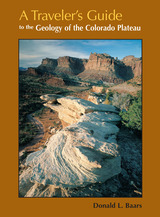 Travelers Guide: To The Geology Of Colorado Plateau
Donald L Baars
University of Utah Press, 2002 Driving across I-70 in southern Utah one can’t help but wonder about the magnificent upturned rocks of the San Rafael Reef. With A Travelers Guide to the Geology of the Colorado Plateau in hand, you’ll soon discover that you were driving through Page and Navajo Sandstone formations, sharply folded into a monocline along one of the "Basin and Range" fault lines. Nearing Flagstaff, Arizona, on Highway 89, you will learn that Mt. Humphry of the San Francisco Peaks, a Navajo Sacred Mountain, was once an active volcano. Keep reading and you’ll find many things worth a slight detour.
A Traveler's Guide to the Geology of the Colorado Plateau will enrich and enliven all of your trips through the varied landscapes of the Colorado Plateau as you learn about the geological forces that have shaped its natural features. The mile-by-mile road logs will take you from Vernal, Utah, in the north to the southernmost reaches of the Plateau in Sedona, Arizona; from the red rocks of Cedar Breaks National Monument near Cedar City, Utah, to the edges of the soaring peaks of the San Juan Mountains near Durango, Colorado. The most comprehensive geological guide to the Colorado Plateau
 Travelers, Immigrants, Inmates: Essays in Estrangement
Frances Bartkowski
University of Minnesota Press, 1995
Travelers, Immigrants, Inmates was first published in 1995. Minnesota Archive Editions uses digital technology to make long-unavailable books once again accessible, and are published unaltered from the original University of Minnesota Press editions.
Identities are always mistaken; yet they are as necessary as air to sustain life in and among communities. Frances Bartkowski uses travel writings, U.S. immigrant autobiographies, and concentration camp memoirs to illustrate how tales of dislocation present readers with a picture of the complex issues surrounding mistaken identities. In turn, we learn much about the intimate relation between language and power.
Combining psychoanalytic and political modes of analysis, Bartkowski explores the intertwining of place and the construction of identities. The numerous writings she considers include André Gide's Voyage to the Congo, Eva Hoffman's Lost in Translation, Sandra Cisneros's House on Mango Street, Zora Neale Hurston's Dust Tracks on a Road and Tell My Horse, and Primo Levi's Survival in Auschwitz.
Elegantly written and incisive, Travelers, Immigrants, Inmates stands at the crossroads of contemporary discussions about ethnicity, race, gender, nationalism, and the politics and poetics of identity. It has much to offer readers interested in questions of identity and cultural differences.
Frances Bartkowski is associate professor of English and director of women's studies at Rutgers University in Newark. She is the author of Feminist Utopias (1989).
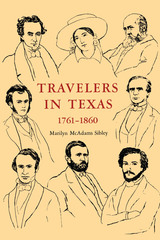 Travelers In Texas, 1761-1860
By Marilyn McAdams Sibley
University of Texas Press, 1967 History passed in review along the highways of Texas in the century 1761–1860. This was the century of exploration and settlement for the big new land, and many thousands of people traveled its trails: traders, revolutionaries, missionaries, warriors, government agents, adventurers, refugees, gold seekers, prospective settlers, land speculators, army wives, and filibusters. Their reasons for coming were many and varied, and the travelers viewed the land and its people with a wide variety of reactions. Political and industrial revolution, famine, and depression drove settlers from many of the countries of Europe and many of the states of the United States. Some were displeased with what they found in Texas, but for many it was a haven, a land of renewed hope. So large was the migration of people to Texas that the land that was virtually unoccupied in 1761 numbered its population at 600,000 a century later. Several hundred of these travelers left published accounts of their impressions and adventures. Collectively the accounts tell a panoramic story of the land as its boundaries were drawn and its institutions formed. Spain gave way to Mexico, Mexico to the Republic of Texas, the Republic to statehood in the United States, and statehood in the Union was giving way to statehood in the Confederate states by 1860. The travelers’ accounts reflect these changes; but, more important, they tell the story of the receding frontier. In Travelers in Texas, 1761–1860, the author examines the Texas seen by the traveler-writer. Opening with a chapter about travel conditions in general (roads or trails, accommodations, food), she also presents at some length the travelers’ impressions of the country and its people. She then proceeds to examine particular aspects of Texas life: the Indians, slavery, immigration, law enforcement, and the individualistic character of the people, all as seen through the eyes of the travelers. The discussion concludes with a “Critical Essay on Sources,” containing bibliographic discussions of over two hundred of the more important travel accounts.
 The Travelers' World: Europe to the Pacific
Harry Liebersohn
Harvard University Press, 2006 In a beautifully crafted narrative that transports the reader from the salons of Europe to the shores of Tahiti, Harry Liebersohn examines the transformation of global knowledge during the great age of scientific exploration. He moves beyond the traditional focus on British and French travelers to include Germans, Russians, and some Americans, as well as the Tahitian, Hawaiian, and other Pacific islanders they encountered. Germany gets special attention because its travelers epitomized the era’s cosmopolitanism and its philosophers engaged most fully in a multicultural understanding of humanity.
Famous adventurers like Captain Cook make appearances, but it’s the observations of such naturalists as Philibert Commerson, George Forster, and Adelbert von Chamisso that helped most to generate a new understanding of these far-flung societies. These European travelers saw non-Europeans neither as “savages” nor as projections of colonial fantasies. Instead the explorers accumulated a rich storehouse of perceptions through negotiations with patrons at home, collaborators abroad, salon philosophers, and missionary rivals.
Liebersohn illuminates the transformative nature of human connections. He examines the expectations these servants of empire brought to the peoples they encountered, and acknowledges the effects of Oceanian behaviors, including unexpected notions of sexuality, on the Europeans. Equally important, he details the reception of these travelers upon their return home.
An unforgettable voyage filled with delightful characters, dramatic encounters, and rich cultural details, The Travelers’ World heralds a moment of intellectual preparation for the modern global era. We now travel effortlessly to distant places, but the questions about perception, truth, and knowledge that these intercontinental mediators faced still resonate.
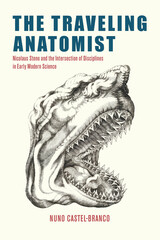 The Traveling Anatomist: Nicolaus Steno and the Intersection of Disciplines in Early Modern Science
Nuno Castel-Branco
University of Chicago Press, 2025 Reevaluates Nicolaus Steno’s contributions to anatomy and early modern science, examining his interdisciplinary interests in their historical context.
Nicolaus Steno (1638–1686) was a renowned anatomist in his lifetime. He reformed the anatomical understanding of glands, argued that the heart was a muscle, renamed the so-called female testicles as ovaries, and developed a mathematical model for understanding muscle contraction—discoveries that were fundamental to the fields of anatomy and physiology. However, other aspects of Steno’s life have come to define him: his claim that mountains’ strata reveal the history of the Earth and his conversion to Catholicism as a practicing scientist. This excessive attention to his geological discoveries and to asking whether science and religion are compatible, Nuno Castel-Branco argues, has obscured his significant accomplishments as an anatomist. The Traveling Anatomist thus restores Steno to his rightful place as a crucial figure in early modern science.
Using Steno’s extensive travels as a framework, this book depicts him as an active participant in the Republic of Letters. Castel-Branco traverses Leiden, Paris, Copenhagen, Florence, and Rome as he follows Steno in his sojourns through different scientific academies, courts, and artisanal workshops. There he developed new friends, some of whom were women, with whom he researched and exchanged ideas. Drawing on Steno’s books, correspondence, and novel archival material, Castel-Branco invites us to approach Steno and his accomplishments in anatomy, mathematics, and geology through the eyes of his contemporaries. Doing so, Castel-Branco reconstructs the rich and overlapping worlds of scientific disciplines that shaped Steno’s work, revealing the richness of interdisciplinary research in early modern intellectual life. And through Steno, he illustrates larger developments and new networks of significance in mid-seventeenth-century science. By focusing on ideas, scientific genres, institutions, and friendships, Castel-Branco offers a way others might also productively study science from the early modern period until today.
 Traveling Black: A Story of Race and Resistance
Mia Bay
Harvard University Press, 2021 Winner of the Bancroft Prize
Winner of the David J. Langum Prize
Winner of the Lillian Smith Book Award
Winner of the Order of the Coif Book Award
Winner of the OAH Liberty Legacy Foundation Award
A New York Times Critics’ Top Book of the Year
“This extraordinary book is a powerful addition to the history of travel segregation…Mia Bay shows that Black mobility has always been a struggle.”
—Ibram X. Kendi, author of How to Be an Antiracist
“In Mia Bay’s superb history of mobility and resistance, the question of literal movement becomes a way to understand the civil rights movement writ large.”
—Jennifer Szalai, New York Times
“Traveling Black is well worth the fare. Indeed, it is certain to become the new standard on this important, and too often forgotten, history.”
—Henry Louis Gates, Jr., author of Stony the Road
From Plessy v. Ferguson to #DrivingWhileBlack, African Americans have fought to move freely around the United States. But why this focus on Black mobility? From stagecoaches and trains to buses, cars, and planes, Traveling Black explores when, how, and why racial restrictions took shape in America and brilliantly portrays what it was like to live with them.
Mia Bay rescues forgotten stories of passengers who made it home despite being insulted, stranded, re-routed, or ignored. She shows that Black travelers never stopped challenging these humiliations, documenting a sustained fight for redress that falls outside the traditional boundaries of the civil rights movement. A riveting, character-rich account of the rise and fall of racial segregation, it reveals just how central travel restrictions were to the creation of Jim Crow laws—and why free movement has been at the heart of the quest for racial justice ever since.
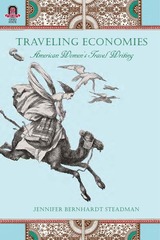 Traveling Economies: American Women's Travel Writing
Jennifer Bernhardt Steadman
Ohio State University Press, 2007 The black and white women travel writers whom Jennifer Bernhardt Steadman investigates in Traveling Economies astonish modern readers with their daring, stamina, and courage. That these women traveled at all is surprising: Nancy Prince spent nearly a decade as an African American member of the Russian Imperial Court; Amy Morris Bradley went to Costa Rica as a governess in hopes of saving her health and finances after years as an impoverished teacher in Maine; and Julia Archibald Holmes carried the banner of dress reform to the heights of Pikes Peak and to the pages of a feminist periodical. Developing the concept of the “ragged edge,” Steadman highlights these women’s shared experiences of penury, work, and independence. Genteel poverty, black skin, outspoken feminism, or sometimes all three impacted the material conditions of their ragged-edge travel (early muckraking journalist Anne Royall walked until her feet were a bloody mass of blisters). Being on the ragged edge also affected the way they represented themselves and their travels (Mary Ann Shadd Cary presented her outspoken advocacy of black emigration to Canada as appropriately feminine). Frances Wright used her travel writing to imagine the new nation as a potential utopia for women citizens; she paid a high price for daring to try to change the social terrain she crossed. Steadman’s interdisciplinary work with archives, newspapers, memoirs, and letters and her thoughtful close readings of the resulting evidence recover these important women’s travels and writing and invite us to rethink where and how women went and what they wrote in antebellum America.
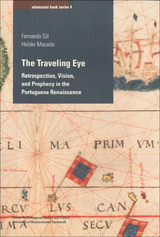 The Traveling Eye: Retrospection, Vision, and Prophecy in the Portuguese Renaissance
Fernando Gil
Tagus Press, 2009 The idea for The Traveling Eye came as a new departure in an old dialogue between the two authors, one a literary scholar, the other a philosopher. Our focus was initially centered on a philosophical hypothesis concerning evidence, with specific reference to the prophetic writings of Father António Vieira, but it occurred to us that this perspective could be applied to literary works, particularly those of the Portuguese Renaissance. The studies that one of us had dedicated to the initiatory aspects of The Lusiads and to the codification of esoteric meanings in the work of Bernardim Ribeiro suggested a possible convergence of our two lines of research. But there are other issues raised by the Portuguese Renaissance: voyages, the new, the encounter with difference and how to understand it. The most obvious and direct expression of these issues is found in the chronicles of voyage and empire, whose importance is duly noted in the study by Luís de Sousa Rebelo included in Chapter III of this book. The literary treatment of this material seems to us no less revealing. Seeing ("seeing clearly seen" as Camões says in The Lusiads) poses the problem of simultaneously seeing "what is there" and of how what is there could be seen. This questioning from the outside by "the traveling eye" went hand in hand with new ways of relating to oneself and to others. Three key Renaissance authors, Luís de Camões (1525?-1580), Francisco de Sá de Miranda (1481?-1558?) and Bernardim Ribeiro (b.1480s?), address the human subject's relationship as a perplexing issue. Their works transform the feeling of love into a multifaceted investigation that questions the identity of the individual. A recurring theme in this book is the metamorphoses of the self brought about by love.
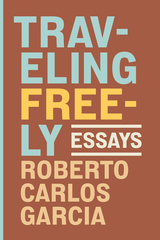 Traveling Freely: Essays
Roberto Carlos Garcia
Northwestern University Press, 2025 A poet’s debut essay collection exploring American faults through the eyes of a Dominican American In Traveling Freely: Essays, Roberto Carlos Garcia explores intersecting topics such as race, identity, American socioeconomic inequality, police violence, our inability to partake in our culture as innocents, and our complicity as Americans in all that’s wrong with the United States from the author’s specific vantage point as a Black Dominican American man. The voice in these essays is both clear and nuanced, and as readers move through the collection, the various themes cohere into a multilayered investigation of institutional racism and the inherent exploitations of capitalism. In essays that are uniquely straightforward and accessible, Garcia insists that in order to resist state-sanctioned violence against marginalized bodies and populations, we must understand our shared history of oppression—so that we can rise against it effectively and find new paths forward.
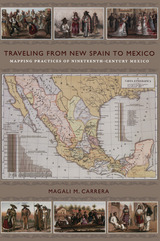 Traveling from New Spain to Mexico: Mapping Practices of Nineteenth-Century Mexico
Magali M. Carrera
Duke University Press, 2011 Antonio García Cubas’s Carta general of 1857, the first published map of the independent Mexican nation-state, represented the country’s geographic coordinates in precise detail. The respected geographer and cartographer made mapping Mexico his life’s work. Combining insights from the history of cartography and visual culture studies, Magali M. Carrera explains how García Cubas fabricated credible and inspiring nationalist visual narratives for a rising sovereign nation by linking old and new visual strategies. From the sixteenth century until the early nineteenth, Europeans had envisioned New Spain (colonial Mexico) in texts, maps, and other images. In the first decades of the 1800s, ideas about Mexican, rather than Spanish, national character and identity began to cohere in written and illustrated narratives produced by foreign travelers. During the nineteenth century, technologies and processes of visual reproduction expanded to include lithography, daguerreotype, and photography. New methods of display—such as albums, museums, exhibitions, and world fairs—signaled new ideas about spectatorship. García Cubas participated in this emerging visual culture as he reconfigured geographic and cultural imagery culled from previous mapping practices and travel writing. In works such as the Atlas geográfico (1858) and the Atlas pintoresco é historico (1885), he presented independent Mexico to Mexican citizens and the world.
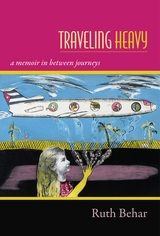 Traveling Heavy: A Memoir in between Journeys
Ruth Behar
Duke University Press, 2013 Traveling Heavy is a deeply moving, unconventional memoir by the master storyteller and cultural anthropologist Ruth Behar. Through evocative stories, she portrays her life as an immigrant child and later, as an adult woman who loves to travel but is terrified of boarding a plane. With an open heart, she writes about her Yiddish-Sephardic-Cuban-American family, as well as the strangers who show her kindness as she makes her way through the world. Compassionate, curious, and unafraid to reveal her failings, Behar embraces the unexpected insights and adventures of travel, whether those be learning that she longed to become a mother after being accused of giving the evil eye to a baby in rural Mexico, or going on a zany pilgrimage to the Behar World Summit in the Spanish town of Béjar. Behar calls herself an anthropologist who specializes in homesickness. Repeatedly returning to her homeland of Cuba, unwilling to utter her last goodbye, she is obsessed by the question of why we leave home to find home. For those of us who travel heavy with our own baggage, Behar is an indispensable guide, full of grace and hope, in the perpetual search for connection that defines our humanity.
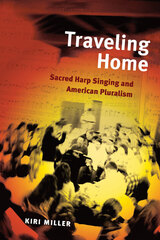 Traveling Home: Sacred Harp Singing and American Pluralism
Kiri Miller
University of Illinois Press, 2010 A compelling account of contemporary Sacred Harp singing, Traveling Home describes how this vibrant musical tradition brings together Americans of widely divergent religious and political beliefs. Named after the most popular of the nineteenth-century shape-note tunebooks--which employed an innovative notation system to teach singers to read music--Sacred Harp singing has been part of rural Southern life for more than 150 years. In the wake of the folk revival of the 1950s and '60s, this participatory musical tradition attracted new singers from all over America. All-day "singings" from The Sacred Harp now take place across the country, creating a diverse and far-flung musical community. Meanwhile, the advent of internet discussion boards and increasing circulation of singer-produced recordings have changed the nature of traditional transmission and sharpened debates about Sacred Harp as an "authentic" form of southern musical expression. Blending historical scholarship with wide-ranging fieldwork, Kiri Miller presents an engagingly written study of a musical movement that some have christened "a quintessential expression of American democracy."
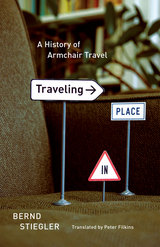 Traveling in Place: A History of Armchair Travel
Bernd Stiegler
University of Chicago Press, 2013 Armchair travel may seem like an oxymoron. Doesn’t travel require us to leave the house? And yet, anyone who has lost herself for hours in the descriptive pages of a novel or the absorbing images of a film knows the very real feeling of having explored and experienced a different place or time without ever leaving her seat. No passport, no currency, no security screening required—the luxury of armchair travel is accessible to us all. In Traveling in Place, Bernd Stiegler celebrates this convenient, magical means of transport in all its many forms.
Organized into twenty-one “legs”—or short chapters—Traveling in Place begins with a consideration of Xavier de Maistre’s 1794 Voyage autour de ma chambre, an account of the forty-two-day “journey around his room” Maistre undertook as a way to entertain himself while under house arrest. Stiegler is fascinated by the notion of exploring the familiar as though it were completely new and strange. He engages writers as diverse as Roussel, Beckett, Perec, Robbe-Grillet, Cortázar, Kierkegaard, and Borges, all of whom show how the everyday can be brilliantly transformed. Like the best guidebooks, Traveling in Place is more interested in the idea of travel as a state of mind than as a physical activity, and Stiegler reflects on the different ways that traveling at home have manifested themselves in the modern era, from literature and film to the virtual possibilities of the Internet, blogs, and contemporary art.
Reminiscent of the pictorial meditations of Sebald, but possessed of the intellectual playfulness of Calvino, Traveling in Place offers an entertaining and creative Baedeker to journeying at home.
 Traveling Light: COLLECTED AND NEW POEMS
David Wagoner
University of Illinois Press, 1999 David Wagoner has won the acclaim of his peers and been compared with some of the most gifted poets in the English language: Emily Dickinson, James Wright, Robert Frost, Theodore Roethke. The Antioch Review has ascribed to him a"profoundly earthbound sanity," while Publishers Weekly credits him with a "plainspoken formal virtuosity" and a "consistent, pragmatic clarity of perception." His collections have garnered Poetry's Levinson and Union League Prizes, the Ruth Lilly Prize, and nominations for the American Book Award and the National Book Award. For his most recent collection, Walt Whitman Bathing, Wagoner was honored with the Ohioana Book Award in the category of poetry.
Witty, eloquent, and insightful, Traveling Light offers new and familiar treasures from a master observer of both the natural and the human worlds. In a style by turns direct and intricate, Wagoner distills the essential emotions from people's encounters with each other, with nature, and with themselves. Through his compassionate but unblinking eyes, we see ourselves and the world that surrounds us more sharply delineated.
Traveling on One Leg
Herta Muller
Northwestern University Press, 2010 Winner, 2009 Nobel Prize in Literature Irene is a fragile woman born to a German family in Romania, who has recently emigrated from her native country to West Germany. Politically and socially isolated, Irene moves within the orbit of three troubled men, while simultaneously embarking on an inner exploration of exile, homeland, and identity.
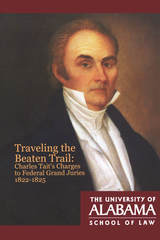 Traveling the Beaten Trail: Charles Tait's Charges to Federal Grand Juries, 1822–1825
Paul M. Pruitt Jr., David I. Durham, and Sally E. Hadden
University of Alabama Press, 2013 In Traveling the Beaten Trail: Charles Tait’s Charges to Federal Grand Juries 1822–1825, a concise and essential addition to the Occasional Publications of the Bounds Law Library, authors Paul M. Pruitt Jr., David I. Durham, and Sally E. Hadden capture the life, achievements, and legacy of federal judge Charles Tait. Throughout his colorful career, Tait left an unmistakable impression on Alabama politics. He had a major influence over the federal bar and its practice, and he also made it his personal responsibility to educate the public. Traveling the Beaten Trail offers a brief biographical account of Charles Tait’s life, highlighting various noteworthy events, such as the array of professions he undertook—from professor, to planter, to lawyer, to senator. The remainder of the text focuses on in-depth analyses of Tait's grand jury charges for 1822, 1824, and 1825.
About Occasional Publications of the Bounds Law Library
This collection offers a series of edited documents that contribute to an understanding of the development of legal history, culture, or doctrine. Series editors Paul M. Pruitt Jr. and David I. Durham have selected a variety of materials—a lecture, diaries, letters, speeches, a ledger, commonplace books, a code of ethics, court reports—to illustrate unique examples of legal life and thought.
 Traveling the High Way Home: Ralph Stanley and the World of Traditional Bluegrass Music
John Wright
University of Illinois Press, 1993 John Wright's collection of interviews and stories about Ralph Stanley puts readers around a campfire at a bluegrass festival while old-timers weave yarns far into the night. Told by those who create, produce, stage, love, and virtually live for old-time mountain music, these tales come from the longtime coworkers, sidemen, promoters, friends, and others in the orbit of the music legend. The storytellers include a scholar who knew Stanley from the early days, the housewife who ran the Stanley Brothers Fan Club, and a souvenir seller for whom the discovery of Stanley's music was almost a religious experience. Wright also uses these invaluable oral histories as a foundation to describe and evaluate Stanley's long career with the Clinch Mountain Boys and the development of his music after the death of his brother Carter. An appendix covers Ralph's prolific recording activity through the mid-1990s, including a breathtaking forty-five albums compromising more than 550 songs and tunes.
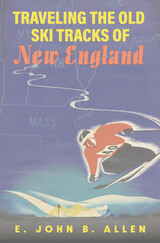 Traveling the Old Ski Tracks of New England
E. John B. Allen
University of Massachusetts Press, 2022 For over a century New Englanders have taken to the slopes in search of ways to enjoy the coldest months, and skiing has deep roots in the region. In the late nineteenth century Scandinavian immigrants worked to educate snowbound locals on how to ski, make equipment, and prepare trails. Soon thereafter, colleges across the Northeast built world-class ski programs, massive jumps were constructed in Brattleboro and Berlin, and dozens of ski areas—big and small—cropped up from the 1930s through the 1960s. Traveling the Old Ski Tracks of New England offers a fascinating history of downhill, cross-country, and backcountry skiing across the region and its leading personalities. Moving from popular destinations like Stowe, Cannon, Bromley, and Mount Washington to the less intimidating hills surrounding Boston, Rhode Island, and Connecticut, E. John B. Allen also recovers the forgotten stories of ski areas that have been abandoned in the face of changing tastes and a warming climate.
Traveling Through Time: A Guide to Michigan's Historical Markers
Laura Rose Ashlee, Editor
University of Michigan Press, 2005 Traveling Through Time is the definitive illustrated guide to nearly 1,500 historic Michigan sites. With this book, travelers can journey through the state to discover the historical markers in Michigan's neighborhoods, along its highways, and in city centers.
Since 1955 the state of Michigan has erected historical markers throughout the state. In this revised edition of Traveling Through Time, Laura Rose Ashlee collects the histories that appear on these markers together into one handy guidebook---a great desk reference for researchers and armchair historians alike.
Some of the book's special features include:
o Location and full text of each marker
o Arranged alphabetically within county chapters
o More than 85 historic and color photographs
o Special section on Michigan historical markers placed outside Michigan
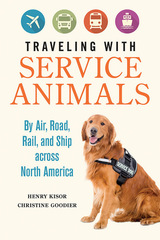 Traveling with Service Animals: By Air, Road, Rail, and Ship across North America
Henry Kisor and Christine Goodier
University of Illinois Press, 2019 The boom in trained service animal use and access has transformed the lives of travelers with disabilities. As a result, tens of thousands of people in the United States and Canada enjoy travel options that were difficult or impossible just a few years ago.Henry Kisor and Christine Goodier provide a narrative guidebook full of essential information and salted with personal, hands-on stories of life on the road with service dogs and miniature horses. As the travel-savvy human companions of Trooper (Kisor's miniature schnauzer/poodle cross) and Raylene (Goodier's black Labrador), the authors share experiences from packing for your animal partner to widely varying legal protections to the animal-friendly rides at Disneyland. Chapters cover the specifics of air, rail, road, and cruise ship travel, while appendixes offer checklists, primers on import regulations and corporate policies, advice for emergencies, and a route-by-route guide to finding relief walks during North American train trips. Practical and long overdue, Traveling with Service Animals provides any human-animal partnership with a horizon-to-horizon handbook for exploring the world.
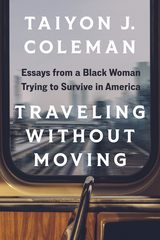 Traveling without Moving: Essays from a Black Woman Trying to Survive in America
Taiyon J. Coleman
University of Minnesota Press, 2024 A stunning lyrical commentary on the constructions of race, gender, and class in the fraught nexus of a Black woman’s personal experience and cultural history The Fair Housing Act passed in 1968, and more than fifty years later, yours seems to be the only Black family on your block in Minneapolis. You and your Black African husband, both college graduates, make less money than some White people with a felony record and no high school diploma. You’re the only Black student in your graduate program. You just aren’t working hard enough. You’re too sensitive. Sandra Bland? George Floyd? Don't take everything so personally. Amid the White smiles of Minnesota Nice and the Minnesota Paradox—the insidious racism of an ostensibly inclusive place to live—what do you do? If you’re Taiyon J. Coleman, you write. In Traveling without Moving, Coleman shares intimate essays from her life: her childhood in Chicago—growing up in poverty with four siblings and a single mother—and the empowering decision to leave her first marriage. She writes about being the only Black student in a prestigious and predominantly White creative writing program, about institutional racism and implicit bias in writing instruction, about the violent legacies of racism in the U.S. housing market, about the maternal health disparities seen across the country and their implication in her own miscarriage. She explores what it means to write her story and that of her family—an act at once a responsibility and a privilege—bringing forth the inherent contradictions between American ideals and Black reality. Using a powerful blend of perspectives that move between a first-person lens of lived experience and a wider-ranging critique of U.S. culture, policy, and academia, Coleman’s writing evinces how a Black woman in America is always on the run, always Harriet Tubman, traveling with her babies in tow, seeking safety, desperate to survive, thrive, and finally find freedom. Retail e-book files for this title are screen-reader friendly.
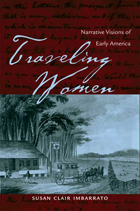 Traveling Women: Narrative Visions of Early America
Susan Clair Imbarrato
Ohio University Press, 2006 Women’s travel narratives recording journeys north and south along the eastern seaboard and west onto the Ohio frontier enhance our historical understanding of early America. Drawing extensively from primary sources, Traveling Women documents women’s role in westward settlement and emphasizes travel as a culture-building event.
Susan Clair Imbarrato closely examines women’s accounts of their journeys from 1700 to 1830, including Sarah Kemble Knight’s well-known journal of her trip from Boston to New York in 1704 and many lesser-known accounts, such as Sarah Beavis’s 1779 journal of her travel to Ohio via Kentucky and Susan Edwards Johnson’s account or her 1801–2 journey from Connecticut to North Carolina.
In the women’s keen observations and entertaining wit, readers will find bravado mixed with hesitation, as women set forth on business, to relocate, and for pleasure. These travelers wrote compellingly of crossing rivers and mountains, facing hunger, encountering native Americans, sleeping in taverns, and confronting slavery, expressing themselves in voices that differed in sensibility from male explorers and travelers.
These accounts, as Imbarrato shows, challenge assumptions that such travel was predominately a male enterprise. In addition, Traveling Women provides a more balanced portrait of westward settlement by affirming women’s importance in the settling of early America.
Travelling Facts: The Social Construction, Distribution, and Accumulation of Knowledge
Edited by Caroline Baillie, Elizabeth Dunn, and Yi Zheng
Campus Verlag, 2004 Travelling Facts explores the production and distribution of facts : their life cycles as well as the material networks through which they travel. Acknowledging that facts are fallible and originate primarily in isolated laboratories and field sites, the volume includes discussions about how facts are reassembled into practical knowledge, how they translate locally, and what lessons may be learned from those who attempt to regulate fact production and circulation in the face of the marked acceleration and expansion of digital technologies worldwide.
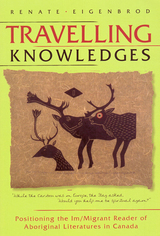 Travelling Knowledges: Positioning the Im/Migrant Reader of Aboriginal Literatures in Canada
Renate Eigenbrod
University of Manitoba Press, 2005 In the context of de/colonization, the boundary between an Aboriginal text and the analysis by a non-Aboriginal outsider poses particular challenges often constructed as unbridgeable. Eigenbrod argues that politically correct silence is not the answer but instead does a disservice to the literature that, like all literature, depends on being read, taught, and disseminated in various ways. In Travelling Knowledges, Eigenbrod suggests decolonizing strategies when approaching Aboriginal texts as an outsider and challenges conventional notions of expertise. She concludes that literatures of colonized peoples have to be read ethically, not only without colonial impositions of labels but also with the responsibility to read beyond the text or, in Lee Maracle's words, to become "the architect of great social transformation."
Features the works of: Jeannette Armstrong (Okanagan), Louise Halfe (Cree), Margo Kane (Saulteaux/Cree), Maurice Kenny (Mohawk), Thomas King (Cherokee, living in Canada), Emma LaRocque (Cree/Metis), Lee Maracle (Sto:lo/Metis), Ruby Slipperjack (Anishnaabe), Lorne Simon (Miíkmaq), Richard Wagamese (Anishnaabe), and Emma Lee Warrior (Peigan).
 Travelling Passions: The Hidden Life of Vilhjalmur Stefansson
Gisli Palsson
University of Manitoba Press, 2005 Vilhjalmur Stefansson has long been known for his groundbreaking work as an anthropologist and expert on Arctic peoples. His three expeditions to the Canadian Arctic in the early 1900s, as well as his expertise in northern anthropology, helped create his public image as an heroic, Hemingway-esque figure in the annals of twentieth-century exploration. But the emotional and private life of Stefansson the man have remained hidden, until now.
New evidence of this other life has recently been discovered: a collection of love letters between Stefansson and his fiance Orpha Cecil Smith were found in a New Hampshire flea market; Stefansson's field diaries have revealed elegant essays and insightful commentary on Inupiat society; baptismal records have revealed that Stefansson had a son, Alex, with his informant and guide, Fanny Pannigabluk; and through Web searches and a private detective, Palsson found and conducted interviews with the descendents of both Cecil Smith and Alex Stefansson.
Travelling Passions sheds new light on Stefanssonís life and work, focussing on the tension between his private life and the theories that brought his name to the halls of fame. Palsson draws a clear, vivid, and in many ways unexpected picture of the mythical figure of Stefansson.
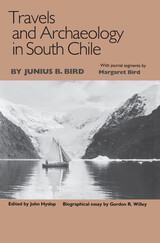 Travels and Archaeology in South Chile
Bird, Junius B.
University of Iowa Press, 1988 "This is a remarkable book by one of the true geniuses in the field of anthropology during this century and one who provided valuable data for specialists in other disciplines as well."--H. M. Wormington
"An engaging manuscript that should charm a broad audience."--Thomas F. Lynch
"The field notes of Junius, and Peggy's diary, are valuable records of the excavations, artifacts, and interpretations of the best archaeologists to work in the southern tip of South America."--James G. Griffin
Junius Bird's three great archaeological field achievements--at the Strait of Magellan in Chilean Patagonia, in the Atacama Desert of northern Chile, and at the sites of early coastal dwellers in northern Peru--made his reputation as a New World prehistorian. His work in south Chile is especially important, since it established the great antiquity of human populations in South America. Until now, most of Bird's Chilean data remained unpublished, but this rich collection of field notebooks from his 1936 and 1937 excavations makes this primary information available for the first time.
Included in this volume are new data from Bird's excavations at Palli Aike, Fell's Cave, and Cañadon Leona as well as Cerro Sota and Mylodon caves. Excerpts from his published articles plus contributions by Juliet Clutton-Brock and Vera Markgraf reinforce the book with major new information about these truly pioneering investigations. Complementing the technical data are excerpts from the field journal kept by Margaret (Peggy) Bird. Witty, charming, and personable, her writings convey the more human aspects of Bird's research while interpreting his theoretical ideas. Finally, the many photographs taken by the Birds add a striking visual dimension to this volume.
The Birds' fieldwork took place under conditions, and with a spirit, vastly different from those of most researchers today. The texts and teamwork revealed in Travels and Archaeology in South Chilewill appeal to everyone concerned with the heavily debated question of earliest peopling in the Americas, with South American anthropology and archaeology, and with the days when archaeology truly meant exploration.
TABLE OF CONTENTS
1. Background and Departure
Overview
South Chile and the Canoe Indians
Daily Life Sailing the Channels
2. Chronological Synthesis and Dating
The Periods
The Radiocarbon Dates
3. Canadon Leona
General Description
Excavation Information
The Artifacts
Faunal Remains
Possible Age of Deposit
Burials
Summary
Daily Life
4. Palli Aike
General Description
Excavation in Two Phases
Excavation Information
The Artifacts
Possible Age of Deposit
Faunal Remains
Human Remains
Daily Life
5. Fell's Cave
General Description
Excavation Information, 1936-1937
The Artifacts
Faunal Remains
Daily Life
Excavations by John Fell and the French Mission
Excavations, 1969-1970
The Carnivore Remains Excavated at
Fell's Cave in 1970. By Juliet Clutton-Brock
Fell's Cave: 11,000 Years of Changes in Paleoenvironments,
Fauna, and Human Occupation. By Vera Markgraf
6. Cerro Sota Cave
General Description
Excavation Information
The Artifacts
Faunal Remains
A Group Burial
Probable Dating of the Deposit
Daily Life
7. Mylodon Cave
Background
Structure of the Floor Deposit
Results and Conclusions
Human Remains
Sloth Skin
Broken or "Cut" Bone
Domestication of the Sloth
Summary of Evidence
Age of Remains
Two Additional Specimens
Travels and Traditions of Waterfowl
H. Albert Hochbaum
University of Minnesota Press, 1967 Travels and Traditions of Waterfowl was first published in 1967. Minnesota Archive Editions uses digital technology to make long-unavailable books once again accessible, and are published unaltered from the original University of Minnesota Press editions. With the combined talents of naturalist, writer, and artist, H. Albert Hochbaum captures the varying moods of earth and sky and spirit of flight. For many years as director of the Delta Waterfowl Research Station in Manitoba, Canada, he has observed the ways of the waterfowl. In this book he portrays and discusses the flights and habits of the birds he has watched in the vast marsh country—the wild ducks, geese, and swans of North America. This book is the winner of a publication award of the Wildlife Society. It is recommended by the American Association for the Advancement of Science in its AAAS Science Book List for Young Artists.
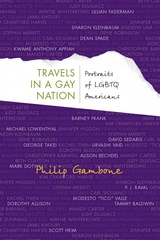 Travels in a Gay Nation: Portraits of LGBTQ Americans
Philip Gambone
University of Wisconsin Press, 2010 For two years, Philip Gambone traveled the length and breadth of the United States, talking candidly with LGBTQ people about their lives. In addition to interviews from David Sedaris, George Takei, Barney Frank, and Tammy Baldwin, Travels in a Gay Nation brings us lesser-known voices—a retired Naval officer, a transgender scholar and “drag king,” a Princeton philosopher, two opera sopranos who happen to be lovers, an indie rock musician, the founder of a gay frat house, and a pair of Vermont garden designers.
In this age when contemporary gay America is still coming under attack, Gambone captures the humanity of each individual. For some, their identity as a sexual minority is crucial to their life’s work; for others, it has been less so, perhaps even irrelevant. But, whether splashy or quiet, center-stage or behind the scenes, Gambone’s subjects have managed—despite facing ignorance, fear, hatred, intolerance, injustice, violence, ridicule, or just plain indifference—to construct passionate, inspiring lives.
Finalist, Foreword Magazine’s Anthology of the Year Outstanding Book in the High School Category, selected by the American Association of School Libraries Best Book in Special Interest Category, selected by the Public Library Association
Travels in a Tree House: Essays on Life and Other Joys
John Workman
University of Arkansas Press, 2001 In a collection of separate, mostly unrelated essays written for his newspaper column over many years, Workman charms with his grace, comforts with his wisdom and makes us smile with his wit. Like his previous collections of inspirational columns, Open Windows and Fireflies in a Fruitjar, this is a book to be read and given as a gift to those we love.
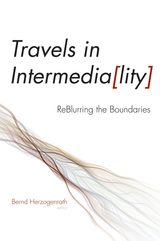 Travels in Intermediality: ReBlurring the Boundaries
Edited by Bernd Herzogenrath
Dartmouth College Press, 2012 How do fiction, film, music, the Internet, and plastic, performative, and fine arts negotiate their shapes, formats, and contents in our contemporary world? More important, how does their interaction shape their techniques of representation, strategies of communication, and forms of reception? In the light of these ongoing interactive (and intermedial) processes, the fields of cultural studies and American studies are challenged to restructure and reorganize themselves. Less interested in the mere fact of traditional art forms meeting new media such as film, video, and digital arts, this collection concentrates on the ways in which the fundamental theoretical constructs of the media have forever changed. This book offers the latest in global intermedial studies, including discussions of digital photography, comics and graphic novels, performance art, techno, hypertext, and video games.
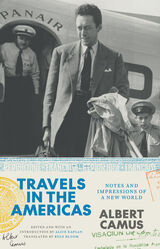 Travels in the Americas: Notes and Impressions of a New World
Albert Camus
University of Chicago Press, 2023 Albert Camus’s lively journals from his eventful visits to the United States and South America in the 1940s, available again in a new translation.
In March 1946, the young Albert Camus crossed from Le Havre to New York. Though he was virtually unknown to American audiences at the time, all that was about to change—The Stranger, his first book translated into English, would soon make him a literary star. By 1949, when he set out on a tour of South America, Camus was an international celebrity. Camus’s journals offer an intimate glimpse into his daily life during these eventful years and showcase his thinking at its most personal—a form of observational writing that the French call choses vues (things seen).
Camus’s journals from these travels record his impressions, frustrations, joys, and longings. Here are his unguarded first impressions of his surroundings and his encounters with publishers, critics, and members of the New York intelligentsia. Long unavailable in English, the journals have now been expertly retranslated by Ryan Bloom, with a new introduction by Alice Kaplan. Bloom’s translation captures the informal, sketch-like quality of Camus’s observations—by turns ironic, bitter, cutting, and melancholy—and the quick notes he must have taken after exhausting days of travel and lecturing. Bloom and Kaplan’s notes and annotations allow readers to walk beside the existentialist thinker as he experiences changes in his own life and the world around him, all in his inimitable style.
 Travels in the Genetically Modified Zone
Mark L. Winston
Harvard University Press, 2002 With genetically modified crops we have entered uncharted territory—where visions of the triumph of biotechnology in agriculture vie with dire views of medical and environmental disaster. For two years Mark L. Winston traveled this fraught territory at home and abroad, listening to farmers, industry spokespeople, regulators, and researchers, canvassing high-security laboratories, environmentalist enclaves, and cyberspace, making a thorough survey of the facts, opinions, and practices deployed by opponents and proponents of transgenic crops.
Through his sympathetic portrayal of the passions on all sides, Winston brings a clear, unbiased perspective to this bewildering landscape. Traveling with Winston, we see the excitement and curiosity that pervade laboratories developing genetically modified crops, as well as the panic and outrage among dedicated opponents of agricultural biotechnology; the desperation of conventional farmers as they look to science for solutions to the problems driving them from their farms, as well as the deeply held values of organic farmers who dread the incursion of genetically modified crops into their expanding enterprise. And, Winston shows us, these contrasting attitudes transcend national borders, with troubling counterparts and consequences in the developing world.
As he seeks a middle ground where concerns about genetic engineering can be rationally discussed and resolved, Winston gives us, at long last, a full and balanced view of the forces at play in the chaotic debate over agricultural biotechnology.
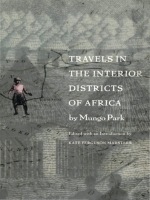 Travels in the Interior Districts of Africa
Mungo Park
Duke University Press, 2000 Mungo Park’s Travels in the Interior Districts of Africa has long been regarded as a classic of African travel literature. In fulfilling his mission to find the Niger River and in documenting its potential as an inland waterway for trade, Park was significant in opening Africa to European economic interests. His modest, low-key heroism made it possible for the British public to imagine themselves as a welcomed force in Africa. As a tale of adventure and survival, it has inspired the imaginations of readers since its first publication in 1799 and writers from Wordsworth and Melville to Conrad, Hemingway, and T. Coreghessan Boyle have acknowledged the influence of Park’s narrative on their work.
Unlike the large expeditions that followed him, Park traveled only with native guides or alone. Without much of an idea of where he was going, he relied entirely on local people for food, shelter, and directions throughout his eventful eighteen month journey. While his warm reaction to the people he met made him famous as a sentimental traveler, his chronicle also provides a rare written record of the lives of ordinary people in West Africa before European intervention. His accounts of war, politics, and the spread of Islam, as well as his constant confrontations with slavery as practiced in eighteenth-century West Africa, are as valuable today as they were in 1799. In preparing this new edition, editor Kate Ferguson Marsters presents the complete text and includes reproductions of all the original maps and illustrations.
Park’s narrative serves as a crucial text in relation to scholarship on the history of slavery, colonial enterprise, and nineteenth-century imperialism. The availability of this full edition will give a new generation of readers access to a travel narrative that has inspired other readers and writers over two centuries and will enliven scholarly discussion in many fields.
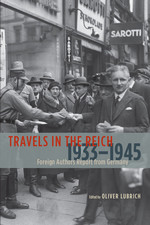 Travels in the Reich, 1933-1945: Foreign Authors Report from Germany
Edited by Oliver Lubrich
University of Chicago Press, 2010 “Even now,” wrote Christopher Isherwood in his Berlin Diary of 1933, “I can’t altogether believe that any of this has really happened.” Three years later, W. E. B. DuBois described Germany as “silent, nervous, suppressed; it speaks in whispers.” In contrast, a young John F. Kennedy, in the journal he kept on a German tour in 1937, wrote, “The Germans really are too good—it makes people gang against them for protection.”
Drawing on such published and unpublished accounts from writers and public figures visiting Germany, Travels in the Reich creates a chilling composite portrait of the reality of life under Hitler. Written in the moment by writers such as Virginia Woolf, Isak Dinesen, Samuel Beckett, Jean-Paul Sartre, William Shirer, Georges Simenon, and Albert Camus, the essays, letters, and articles gathered here offer fascinating insight into the range of responses to Nazi Germany. While some accounts betray a distressing naivete, overall what is striking is just how clearly many of the travelers understood the true situation—and the terrors to come.
Through the eyes of these visitors, Travels in the Reich offers a new perspective on the quotidian—yet so often horrifying—details of German life under Nazism, in accounts as gripping and well-written as a novel, but bearing all the weight of historical witness.
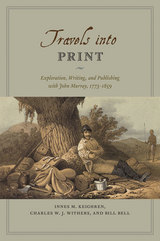 Travels into Print: Exploration, Writing, and Publishing with John Murray, 1773-1859
Innes M. Keighren, Charles W. J. Withers, and Bill Bell
University of Chicago Press, 2015 In eighteenth- and nineteenth-century Britain, books of travel and exploration were much more than simply the printed experiences of intrepid authors. They were works of both artistry and industry—products of the complex, and often contested, relationships between authors and editors, publishers and printers. These books captivated the reading public and played a vital role in creating new geographical truths. In an age of global wonder and of expanding empires, there was no publisher more renowned for its travel books than the House of John Murray.
Drawing on detailed examination of the John Murray Archive of manuscripts, images, and the firm’s correspondence with its many authors—a list that included such illustrious explorers and scientists as Charles Darwin and Charles Lyell, and literary giants like Jane Austen, Lord Byron, and Sir Walter Scott—Travels into Print considers how journeys of exploration became published accounts and how travelers sought to demonstrate the faithfulness of their written testimony and to secure their personal credibility. This fascinating study in historical geography and book history takes modern readers on a journey into the nature of exploration, the production of authority in published travel narratives, and the creation of geographical authorship—a journey bound together by the unifying force of a world-leading publisher.
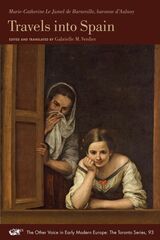 Travels into Spain
Marie-Catherine Le Jumel de Barneville, baronne d'Aulnoy
Iter Press, 2022 A masterpiece of ethnographic observation on seventeenth-century Spain.
While mysteries remain in her biography, Madame d’Aulnoy’s tremendous literary talent is finally being rediscovered. Marie-Catherine Le Jumel de Barneville, baronne d’Aulnoy (1652–1705) was the first Frenchwoman to write, publicize, and publish the account of her travels into Spain as an independent woman. Considered the authority on Spain for nearly two centuries until historiographers labeled them as disreputable, Travels into Spain can now be appreciated for its ironic gaze on realities concealed from male travelers and Madame d’Aulnoy’s unabashedly female and often playful voice. Her writing casts a unique light on gender relations, the condition of women, cultural biases, national rivalries, and religious superstitions at a critical time in early modern cultural and literary history. The first modern translation of Travels into Spain, this book situates Madame d’Aulnoy’s account in its historical context. Travels into Spain is a masterpiece of ethnographic observation, expressing a woman’s view on gender relations, marriage, religion, fashion, food, bullfights, and the Inquisition.
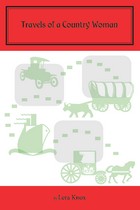 Travels of a Country Woman
Lera Knox
University of Tennessee Press, 2009 Readers were introduced to Lera Knox and her quaint country tales in Goodness Gracious, Miss Agnes, the first book published by Newfound Press, the University of Tennessee digital press. The former Lera Margaret Ussery, born in post-Victorian Tennessee, began her colorful adventures in 1896 on her grandparents' farm in Columbia, Tennessee. After a stint teaching school, Knox married and began to raise her family on a farm. Travels ef a Country Woman begins with the Knox family's emergence from the Great Depression, initially by way of a trip to the Chicago World's Fair in 1933. Traveling by "Elizabeth T," the family Model T Ford, Knox sent dispatches to the Nashville Banner recounting her family's adventures. Those articles marked the beginning of Knox's career as a columnist-a career that she pursued for the rest of her life. She wrote articles about her travels from Hollywood to Copenhagen, from having tea with Eleanor Roosevelt to attending the Coronation of Elizabeth II.
 The Travels of Increase Joseph: A Historical Novel about a Pioneer Preacher
Jerry Apps
University of Wisconsin Press, 2010 Plum Falls, New York, 1840s: Dismissed from Harvard Divinity School for his liberal views, Increase Joseph Link arrives home with a heavy heart. He gives up his dream of becoming a minister to settle for life on the farm, until the day he is struck by lightning and hears a voice telling him to rise and speak. Heeding that voice, Increase becomes a preacher, advocating for environmental protection and the end of slavery and war. His growing band of followers calls itself the Standalone Fellowship, and they accompany him on his move west to Wisconsin, to a place of better land and opportunity.
Link Lake, Wisconsin, 1852: Preacher Increase Link and the Standalone Fellowship settle near a lake that they name in his honor. Increase’s gifted tongue calls people to his mission to protect the land: “Unless we take care of the land we shall all perish.” To finance the fellowship activities, Increase sells his special cure-all tonic—fifty cents per bottle!
Inspired by actual events that took place in upstate New York and Wisconsin in the mid-nineteenth century, The Travels of Increase Joseph is the first in Jerry Apps’s series set in fictional Ames County, Wisconsin. The four novels in the series—which also includes In a Pickle, Blue Shadows Farm, and the forthcoming Cranberry Red—all take place around Link Lake at different points in history. They convey Apps’s deep knowledge of rural life and his own concern for land stewardship.
The Travels of John Heckewelder in Frontier America
Paul A. Wallace
University of Pittsburgh Press, 1985 Paul A. Wallace gathers the diaries and journals of John Heckewelder to prepare this engrossing account of a man who traveled extensively in the Western frontier in the service of the Moravian Church and the United States government, and recorded a great deal of early American history along the way. Heckewelder also lived among the Indians for nearly sixty years, learning their languages, sharing their activities, and wrote vividly of his life with them. Between 1762 and 1813 he crossed the Allegheny Mountains thirty times and made numerous trips down the Ohio River as far south as Kentucky, and along the Great Lakes to Detroit. Heckewelder tells of the first great migration of whites into the West, and also wrote of the early settlements in many important cities, including Detroit, Louisville, Cincinnati, Pittsburgh, Harrisburg, Schenectady and Albany.
Travels of Marco
Mark Levine
Four Way Books, 2016 The poems in Travels of Marco speak with a heightened awareness of the incipience of personhood and of its tatters. Exploring a friction between living and surviving, the poems are preoccupied with employment—physical and spiritual—and unemployment, flight and immobility, ethereal selves and animal selves, absurdity and actuality. Here is work that raises the questions of whether the person who has lost language continues to dream and of whether the most remote memories of love and care might provide sustenance. The story these poems are telling in their shifting tones and identities is one of the restorative power of imaginative transport—travels in language—at the mind’s limit.
The Travels of Mendes Pinto
Fernão Mendes Pinto
University of Chicago Press, 1989 This text, ostensibly the autobiography of Portugese explorer Fernão Mendes Pinto, came second only to Marco Polo's work in exciting Europe's imagination of the Orient. Chronicling adventures from Ethiopia to Japan, Travels covers twenty years of Mendes Pinto's odyssey as a soldier, a merchant, a diplomat, a slave, a pirate, and a missionary, and continues to overwhelm questions about its source with the sheer enjoyment of its narrative.
"[T]here is plenty here for the modern reader. . . . The vivid descriptions of swashbuckling military campaigns and exotic locations make this a great adventure story. . . . Mendes Pinto may have been a sensitive eyewitness, or a great liar, or a brilliant satirist, but he was certainly more than a simple storyteller."—Stuart Schwartz, The New York Times
The Travels of Pieter Albert Bik: Writings from the Dutch Colonial World of the Early Nineteenth Century
Mikko Toivanen
Leiden University Press, 2017 Pieter Albert Bik (1798–1855) was a Dutch colonial official whose work took him all over the world, including travels throughout Europe, the Dutch East Indies, and Japan. This book presents for the first time in English his autobiographical writings about those travels, which Bik never published in his lifetime. Presented here with annotations to set his observations in context, Bik’s accounts offer a unique glimpse of the wide horizons of the world of Dutch colonialism in the first half of the nineteenth century, while editor Mikko Toivanen also draws interesting parallels between Bik’s travels and the contemporary emergence of tourist travel in Europe.
The Travels of Reverend Olafur Egilsson
Karl Smari Hreinsson
Catholic University of America Press, 2016 The combination of Reverend Olafur's narrative, the letters, and the material in the Appendices provides a first-hand, in-depth view of early seventeenth-century Europe and the Maghreb equaled by few other works dealing with the period. We are pleased to offer it to the wider audience that an English edition allows.
The Travels of the Infante Dom Pedro of Portugal
Francis M. Rogers
Harvard University Press The Infante Dom Pedro (1392–1449), prince of Portugal, warrior, traveler, regent, was hero and victim of a legend. In the Book of the Infante Dom Pedro, an early-sixteenth-century Spanish fantasy by Gómez de Santisteban, Pedro’s journeys may dimly reflect the Infante’s actual wanderings in Europe but also involve Amazons and Giants in a medieval world that includes the goals of Prester John’s court and Apostle Thomas’s shrine in the Indies.
Here is a full translation of the Book, with a detailed discussion of the real travels, their transformation into legend, the tale’s influence, and the Spanish author’s true purpose.
Travels Through France and Italy
Tobias Smollett
Northwestern University Press, 1997 "Traduced by malice, persecuted by fiction, abandoned by false patrons, and overwhelmed by the sense of a domestic calamity," Tobias Smollett set off on a journey through France and Italy to relieve his despair. While there, he wrote regularly to his friends, and the result is this fascinating, wholeheartedly personal account of places and he encountered.
Travels through France and Italy is a landmark work in travel literature. Full of prejudice, grousing, sharp observation, and caustic satire, it is the first travel book in modern literature to go beyond the simple conveyance of information to reflect the writer's state of mind.
Travels with a Donkey in the Cevennes
Robert Louis Stevenson
Northwestern University Press, 1996 In 1878 Robert Louis Stevenson set out on a walking tour of the Cévennes behind Modestine, the donkey that carried his baggage. The one hundred twenty-mile trip was through difficult country, and Modestine proved to be less than agreeable, too. Although Stevenson's adventure lasted only twelve days, his account suggests a much longer journey, with all sorts of backward glances, detours, and retracing of steps, both on the terrain and in spirit.
Stevenson's third book, Travels with a Donkey was originally intended as a lighthearted sketch, a companion-piece to his recent Inland Voyage. Although he would not be recognized as a major author until the publication of Treasure Island and Dr. Jekyll and Mr. Hyde, one can see his voice developing. Full of charm and instruction, Travels with a Donkey serves as a guide to alternatives to the restless and distracted standard of contemporary travel.
 Travels with Tocqueville Beyond America
Jeremy Jennings
Harvard University Press, 2023 A revelatory intellectual biography of Tocqueville, told through his wide-ranging travels—most of them, aside from his journey to America, barely known.
It might be the most famous journey in the history of political thought: in 1831, Alexis de Tocqueville sailed from France to the United States, spent nine months touring and observing the political culture of the fledgling republic, and produced the classic Democracy in America.
But the United States was just one of the many places documented by the inveterate traveler. Jeremy Jennings follows Tocqueville’s voyages—by sailing ship, stagecoach, horseback, train, and foot—across Europe, North Africa, and of course North America. Along the way, Jennings reveals underappreciated aspects of Tocqueville’s character and sheds new light on the depth and range of his political and cultural commentary.
Despite recurrent ill health and ever-growing political responsibilities, Tocqueville never stopped moving or learning. He wanted to understand what made political communities tick, what elite and popular mores they rested on, and how they were adjusting to rapid social and economic change—the rise of democracy and the Industrial Revolution, to be sure, but also the expansion of empire and the emergence of socialism. He lauded the orderly, Catholic-dominated society of Quebec; presciently diagnosed the boisterous but dangerously chauvinistic politics of Germany; considered England the freest and most unequal place on Earth; deplored the poverty he saw in Ireland; and championed French colonial settlement in Algeria.
Drawing on correspondence, published writings, speeches, and the recollections of contemporaries, Travels with Tocqueville Beyond America is a panoramic combination of biography, history, and political theory that fully reflects the complex, restless mind at its center.
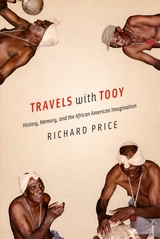 Travels with Tooy: History, Memory, and the African American Imagination
Richard Price
University of Chicago Press, 2007 Thirty-five years into his research among the descendants of rebel slaves living in the South American rain forest, anthropologist Richard Price encountered Tooy, a priest, philosopher, and healer living in a rough shantytown on the outskirts of Cayenne, French Guiana. Tooy is a time traveler who crosses boundaries between centuries, continents, the worlds of the living and the dead, and the visible and invisible. With an innovative blend of storytelling and scholarship, Travels with Tooy recounts the mutually enlightening and mind-expanding journeys of these two intellectuals.
Included on the itinerary for this hallucinatory expedition: forays into the eighteenth century to talk with slaves newly arrived from Africa; leaps into the midst of battles against colonial armies; close encounters with double agents and femme fatale forest spirits; and trips underwater to speak to the comely sea gods who control the world’s money supply. This enchanting book draws on Price’s long-term ethnographic and archival research, but above all on Tooy’s teachings, songs, stories, and secret languages to explore how Africans in the Americas have created marvelous new worlds of the imagination.
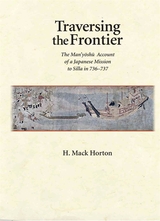 Traversing the Frontier: The Man'yōshū Account of a Japanese Mission to Silla in 736–737
H. Mack Horton
Harvard University Press, 2012 In the sixth month of 736, a Japanese diplomatic mission set out for the kingdom of Silla, on the Korean peninsula. The envoys undertook the mission during a period of strained relations with the country of their destination, met with adverse winds and disease during the voyage, and returned empty-handed. The futile journey proved fruitful in one respect: its literary representation—a collection of 145 Japanese poems and their Sino-Japanese (kanbun) headnotes and footnotes—made its way into the eighth-century poetic anthology Man’yōshū, becoming the longest poetic sequence in the collection and one of the earliest Japanese literary travel narratives.
Featuring deft translations and incisive analysis, this study investigates the poetics and thematics of the Silla sequence, uncovering what is known about the actual historical event and the assumptions and concerns that guided its re-creation as a literary artifact and then helped shape its reception among contemporary readers. H. Mack Horton provides an opportunity for literary archaeology of some of the most exciting dialectics in early Japanese literary history.
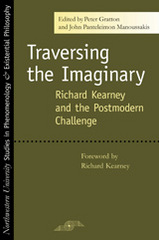 Traversing the Imaginary: Richard Kearney and the Postmodern Challenge
Edited by Peter Gratton and John Panteleimon Manoussakis; Foreword by Richard Kearney
Northwestern University Press, 2007 In recent years, Richard Kearney has emerged as a leading figure in the field of continental philosophy, widely recognized for his work in the areas of philosophical and religious hermeneutics, theory and practice of the imagination, and political thought. This much-anticipated—and long overdue—study is the first to reflect the full range and impact of Kearney's extensive contributions to contemporary philosophy.
The book opens with Kearney's own "prelude" in which he traces his intellectual itinerary as it traverses the three imaginaries explored in the volume: the dialogical, the political, and the narrative. The interviews that follow the first section allow readers to listen in on conversations between Kearney and some of the most interesting and respected thinkers of our time—Noam Chomsky, Charles Taylor, Jacques Derrida, Paul Ricouer, and Martha Nussbaum—as they reveal new and unexpected aspects of their thought on stories and mourning, ethics and narrative, terror and religion, intellectuals and ideology. The next section, on the political imaginary, looks at Kearney's distinctive contribution to the political situation in Ireland and in Europe more generally; and in the last, on narrative, writers including David Wood, Terry Eagleton, and Mark Dooley focus on Kearney's novels as instances of narrative theory put into literary practice. Concluding with Kearney's postscript, an essay on "Traversals and Epiphanies in Joyce and Proust," the volume comes full circle, encompassing the full extent of Richard Kearney's engagement and offerings as a philosopher,
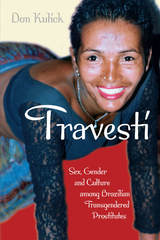 Travesti: Sex, Gender, and Culture among Brazilian Transgendered Prostitutes
Don Kulick
University of Chicago Press, 1998 In this dramatic and compelling narrative, anthropologist Don Kulick follows the lives of a group of transgendered prostitutes (called travestis in Portuguese) in the Brazilian city Salvador. Travestis are males who, often beginning at ages as young as ten, adopt female names, clothing styles, hairstyles, and linguistic pronouns. More dramatically, they ingest massive doses of female hormones and inject up to twenty liters of industrial silicone into their bodies to create breasts, wide hips, and large thighs and buttocks. Despite such irreversible physiological changes, virtually no travesti identifies herself as a woman. Moreover, travestis regard any male who does so as mentally disturbed.
Kulick analyzes the various ways travestis modify their bodies, explores the motivations that lead them to choose this particular gendered identity, and examines the complex relationships that they maintain with one another, their boyfriends, and their families. Kulick also looks at how travestis earn their living through prostitution and discusses the reasons prostitution, for most travestis, is a positive and affirmative experience.
Arguing that transgenderism never occurs in a "natural" or arbitrary form, Kulick shows how it is created in specific social contexts and assumes specific social forms. Furthermore, Kulick suggests that travestis—far from deviating from normative gendered expectations—may in fact distill and perfect the messages that give meaning to gender throughout Brazilian society and possibly throughout much of Latin America.
Through Kulick's engaging voice and sharp analysis, this elegantly rendered account is not only a landmark study in its discipline but also a fascinating read for anyone interested in sexuality and gender.
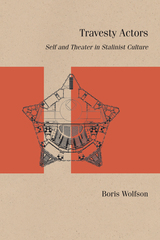 Travesty Actors: Self and Theater in Stalinist Culture
Boris Wolfson, edited by Simon Morrison
Northwestern University Press, 2026 Examining theatrical performance under Stalinist cultural mandates
Talk of Joseph Stalin’s “show trials,” the public prosecutions in Moscow’s Hall of Columns in the late 1930s, is so familiar as to obscure the relationship between actual shows—in the Soviet Union’s major theaters—and politics. Travesty Actors: Self and Theater in Stalinist Culture examines theatrical performance within the context of the Soviet cultural establishment’s fashioning of a “genuine Soviet person.” Boris Wolfson focuses on prominent and controversial plays by artists including Aleksandr Afinogenov, Mikhail Bulgakov, Yuri Olesha, and Natalia Sats and the efforts of theater companies, like the Moscow Arts Theater, the Meyerhold Theater, and the Central Children’s Theater, to adhere to this cultural mandate while grappling with repression, censorship, and conflicting interpretations of its aims. Drawing on archival materials, diaries and memoirs and eyewitness accounts, Wolfson greatly illuminates the achievements of Soviet theater during this harsh period and the cultural significance of artistic theories and practices for articulating and enacting ideological programs.
 Travesty: The Trial of Slobodan Milosevic and the Corruption of International Justice
John Laughland
Pluto Press, 2007 In 2006, Slobodan Milosevic died in prison in the Hague during a four-year marathon trial for war crimes. John Laughland was one of the last Western journalists to meet with him. Laughland had followed the trial from its beginning and wrote extensively on it in the Guardian and the Spectator, challenging the legitimacy of the Yugoslav Tribunal and the hypocrisy of "international justice."
In this short book, Laughland gives a full account of the trial---the longest trial in history---from the moment the indictment was issued at the height of NATO's attack on Yugoslavia to the day of Milosevic's mysterious death in custody. "International justice" is supposed to hold war criminals to account, but---as the trials of both Milosevic and Saddam Hussein show---the indictments are politically motivated and the judicial procedures are irredeemably corrupt. Laughland argues that international justice is an impossible dream and that such show trials are little more than propaganda exercises designed to distract attention from the war crimes committed by Western states.
"Study this story. . . . The truth is hard to find, but in John Laughland we are fortunate to have a man blessed with the desire to find the truth."
---Ramsey Clark, from the Foreword
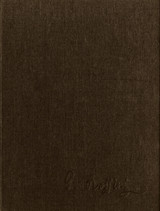 Tre cantate napoletane
Gioachino Rossini
University of Chicago Press, 2000 These three festive cantatas were composed for celebrations at the Neapolitan court of King Ferdinand IV between 1816 and 1819: Giunone (poetry by Angelo Maria Ricci) for the king's birthday, Omaggio umiliato a Sua Maestà (poetry by Antonio Niccolini) for his recovery from serious illness, and Cantata per Francesco I, Imperatore di Austria (poetry by Giulio Genoino) for an imperial visit. Calling for all the forces of the royal opera theater, these occasions exploited fine solo singers, large orchestra and mixed chorus, and dancers. Although the cantatas share the stylistic splendor of Rossini's operas from this period (among them Il barbiere di Siviglia,La Cenerentola, and Armida), they are ideal for concert performance because they are shorter and require only one, two, or three soloists.
This volume makes conveniently available the chorus and ballet music shared by the two later cantatas, present in only one of the autographs. A block of missing music has been reconstructed and the entire number adapted by the editors according to Rossini's written instructions in the manuscripts.
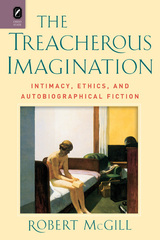 The Treacherous Imagination: Intimacy, Ethics, and Autobiographical Fiction
Robert McGill
Ohio State University Press, 2013 Many authors have been accused of betraying their loved ones by turning them into fictional characters. In The Treacherous Imagination, Robert McGill examines the ethics of writing such stories. He argues that while fiction has long appealed to readers with its narratives of private life, contemporary autobiographical fiction channels a widespread ambivalence about the value of telling all in a confessional age—an age in which fiction has an unprecedented power to leave people feeling libeled or exposed when they recognize themselves in it. Observing that the interests of authors and their loved ones in such cases are often less divergent than they appear, McGill assess strategies by which both parties might use fiction not to hurt each other but to revise and revitalize intimacy. Discussing authors such as Philip Roth, Alice Munro, A. S. Byatt, and Hanif Kureishi, McGill questions whether people should always require exclusivity of each other with regard to the stories they tell about private life. Instead, authors and their intimates might jointly embrace fiction’s playful, transgressive qualities, even while reexamining the significance of that fiction’s intimations. In treating autobiographical fiction as both a willful public indiscretion and a mediator of intimate relations, The Treacherous Imagination provides a comprehensive account of the various potentials that fiction holds to harm and to help those who write it, those who read it, and those who see themselves in it.
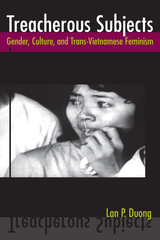 Treacherous Subjects: Gender, Culture, and Trans-Vietnamese Feminism
Lan P Duong
Temple University Press, 2012 Treacherous Subjects is a provocative and thoughtful examination of Vietnamese films and literature viewed through a feminist lens. Lan Duong investigates the postwar cultural productions of writers and filmmakers, including Tony Bui, Trinh T. Minh-ha, and Tran Anh Hung.
Taking her cue from the double meaning of "collaborator," Duong shows how history has shaped the loyalties and shifting alliances of the Vietnamese, many of whom are caught between opposing/constricting forces of nationalism, patriarchy, and communism. Working at home and in France and the United States, the artists profiled in Treacherous Subjects have grappled with the political and historic meanings of collaboration. These themes, which probe into controversial issues of family and betrayal, figure heavily in fictions such as the films The Scent of Green Papaya and Surname Viet Given Name Nam.
As writers and filmmakers collaborate, Duong suggests that they lay the groundwork for both transnational feminist politics and queer critiques of patriarchy.
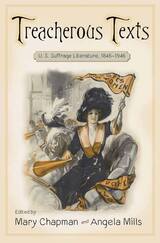 Treacherous Texts: An Anthology of U.S. Suffrage Literature, 1846-1946
Chapman, Mary
Rutgers University Press, 2011 Treacherous Texts collects more than sixty literary texts written by smart, savvy writers who experimented with genre, aesthetics, humor, and sex appeal in an effort to persuade American readers to support woman suffrage. Although the suffrage campaign is often associated in popular memory with oratory, this anthology affirms that suffragists recognized early on that literature could also exert a power to move readers to imagine new roles for women in the public sphere.
Uncovering startling affinities between popular literature and propaganda, Treacherous Texts samples a rich, decades-long tradition of suffrage literature created by writers from diverse racial, class, and regional backgrounds. Beginning with sentimental fiction and polemic, progressing through modernist and middlebrow experiments, and concluding with post-ratification memoirs and tributes, this anthology showcases lost and neglected fiction, poetry, drama, literary journalism, and autobiography; it also samples innovative print cultural forms devised for the campaign, such as valentines, banners, and cartoons. Featured writers include canonical figures as well as writers popular in their day but, until now, lost to ours. Includes writings by:
• Sojourner Truth
• Elizabeth Cady Stanton
• Frederick Douglass
• Fanny Fern
• Harriet Beecher Stowe
• Djuna Barnes
• Charlotte Perkins Gilman
• Marianne Moore
• Sui Sin Far
• Edna St. Vincent Millay
• Gertrude Stein
And many others.
The Treadmill Affect: Marxism, Subjectivity, and the Present
Benjamin Lee
Prickly Paradigm Press, 2025 A critical synthesis of the work of Lauren Berlant, Moishe Postone, and Michael Silverstein.
The Treadmill Affect draws upon the work of three University of Chicago professors, each a former program director at the Center for Transcultural Studies: literary and cultural critic Lauren Berlant, historian and social theorist Moishe Postone, and linguist Michael Silverstein. Through this intellectual synthesis, Benjamin Lee demonstrates the critical possibilities of uniting a revived linguistic turn with Marxist accounts of affect and subjectivity, adding new dimensions to the "treadmill" affective structure of cruel optimism.
Treadwell Gold: An Alaska Saga of Riches and Ruin
Sheila Kelly
University of Alaska Press, 2010 A century ago, Treadwell, Alaska, was a featured stop on steamship cruises, a rich, up-to-date town that was the most prominent and proud in all Alaska. Its wealth, however, was founded on the remarkably productive gold mines on Douglas Island, and when those caved in and flooded in the early decades of the twentieth century, Treadwell sank into relative obscurity.
Treadwell Gold presents first-person accounts from the sons and daughters of the miners, machinists, hoist operators, and superintendents who together dug and blasted the gold that made Treadwell rich. Alongside these stories are vintage photos that capture both the industrial vigor of the mines and the daily lives that made up Treadwell society. The book will fascinate anyone interested in Alaskan history or the romance of gold mining’s past.
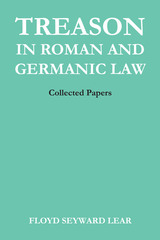 Treason in Roman and Germanic Law: Collected Papers
By Floyd Seyward Lear
University of Texas Press, 1965 "Treason" is a word with many connotations, a word applied to a host of varied offenses throughout the history of humanity. These essays by Floyd Seyward Lear analyze the development of the political theory of treason from its beginning in Roman Law to its transformation in the Germanic custom of the early Middle Ages. The author has presented treason as a political idea, possessing historical continuity, though varying from age to age as it follows the evolution of political authority itself. These studies trace the shifting emphasis in crimes against the state from acts directed against a central absolutist authority to acts involving the personal relationship of a pledged troth and individual fealty. This is a shift from the concept of majesty in Roman law to the concept of fidelity in Germanic law with the corollary shift from allegiance as an act of deference to allegiance as a token of mutual fidelity. These ideas are examined chronologically across an interval extending from archaic Roman law to incipiently feudal forms, from which modern theories of treason, allegiance, and sovereignty derive. Contemporary concepts in these political areas can hardly be understood apart from their historical origins. Broadly considered, this work is intended as a contribution to intellectual history. Further, this collection represents the synthesis of material widely scattered in the primary sources and relevant secondary works. The two concluding bibliographical essays are intended as a general survey of the literature relevant to these studies in Roman and Germanic public law. Descriptive and interpretive works which deal with treason and its allied aspects of political and legal theory are not numerous in the English language.
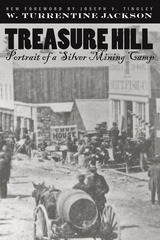 Treasure Hill: Portrait Of A Silver Mining Camp
W. Turrentine Jackson
University of Nevada Press, 2000 In 1868, the discovery of an exceptionally rich silver ore on Treasure Hill in eastern Nevada led to an intense but short-lived boom. The White Pine Mining District was quickly organized, and in time a new Nevada county was created with that name. The boom lasted only two seasons, but dogged investors, mostly British, spent more than twenty years pursuing the dream of making White Pine a prosperous mining district before they withdrew and left behind only disappointment and ghost towns. W. Turrentine Jackson’s study of Treasure Hill, first published in 1963, has endured as a classic case study of a typical mining district in the western United States. Much more than events at the Comstock Lode in Virginia City, the rush to White Pine, its brief season of glory and excitement followed by sudden decline, typifies the pattern of development in the majority of mining districts in the West. Far more than a tale of sudden wealth and lawlessness—although both were abundant—Treasure Hill encompasses the impact of growing international capitalism and labor movements on the mining West, the bitter politics surrounding the creation of towns and counties, and the human costs of boom and bust. Available again in a new paperback edition, with a foreword by mining historian Joseph V. Tingley,Treasure Hill offers readers a lively, thoroughly researched account of one of Nevada’s richest and briefest mining booms.
Treasure Island: A Play
Mary Zimmerman
Northwestern University Press, 2019 “Zimmerman has powerfully captured the joy, danger, and fantasy of Stevenson’s novel. . . Pure fun, a potent coming-of-age story, and a rollicking swashbuckler.”—San Francisco Chronicle
In Treasure Island, Tony Award winner and inventive adapter-director Mary Zimmerman has penned a spirited, energetic adaptation of Robert Louis Stevenson’s most beloved novel, proving again that “a strong story full of larger-than-life characters and the quest for filthy lucre has no age barrier” (Chicago Sun-Times).
Enlivened by rum, mutiny, and buried treasure, Treasure Island is the classic pirates’ tale, widely regarded as the forerunner of this genre. After discovering a treasure map, young Jim Hawkins sets off to sea as cabin boy aboard the Hispaniola, where he encounters one of the most unforgettable characters in literary history—peg-legged buccaneer Long John Silver, a malicious mutineer and charismatic father figure.
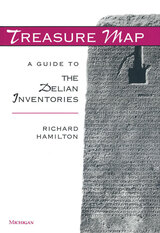 Treasure Map: A Guide to the Delian Inventories
Richard Hamilton
University of Michigan Press, 2015 In the fourth century BC, the Athenians introduced to the sacred isle of Delos the habit of making marble inscriptions that noted inventories of goods in religious precincts. These inscriptions are now quite damaged and badly preserved, but they offer a trove of information about religious practice on this most unusual island. Richard Hamilton has tackled the difficult task of examining and analyzing these inscriptions and provides a wealth of information about the inventories and the island of Delos. Hamilton offers detailed insight into the workings of one of the most important Greek sanctuaries, bringing together information that is otherwise widely scattered in a number of modern and ancient languages. He offers English translations of the inventories and presents extensive notes on objects recorded, on how the inventories were listed and weighed, and on aspects of Delian life and politics. Treasure Map is a major resource for scholars and students of Greek religion and history, epigraphy, ancient economics, and politics.
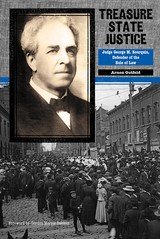 Treasure State Justice: Judge George M. Bourquin, Defender of the Rule of Law
Arnon Gutfeld
Texas Tech University Press, 2013 Few works reveal anything about the role of federal judges in the early twentieth-century American West. Arnon Gutfeld fills that void by analyzing the major issues and dilemmas those judges faced as the West moved rapidly from frontier justice to twentieth-century legal realities. George M. Bourquin served as Federal District judge in Montana from 1912 to 1934. He dared to issue rulings that captured national attention and aroused the ire of the Department of Justice. During the mass fear and hysteria of World War I and the Red Scare, he was one of very few judges to defend individual liberty. His decision in the Ves Hall Case elicited a knee-jerk reaction from Washington--the notorious Anti-Sedition Act of 1918.
A Jeffersonian conservative-libertarian—in the tradition of Edmund Burke—Bourquin believed the Constitution to be the sole barrier between civilization and barbarism. Especially important were his decisions in labor, Native American, and immigration issues.
Coinciding with the federal government’s largest role over the destiny of the American West, Bourquin’s judicial career provides a unique opportunity to examine the great impact that the legal system and a very unusual judge had in the post-territorial frontier period.
 Treasure Tales of the Rockies
Perry Eberhart
Ohio University Press, 1990 Here is a whopping collection of tales of lost mines and buried treasure to stir the blood of any adventurous spirit and to satisfy the most lively imagination. Maps and photos galore accompany the stories.
Perry Eberhart gathered and researched almost 150 treasure tales and tells them with the same thoroughness, engaging style, and lively anecdotes that distinguish his other major contribution to Colorado lore and history: Guide to the Colorado Ghost Towns and Mining Camps.
Treasure Tales not only tells the original story of a lost mine or a buried treasure, but also fills in the pieces of the puzzle as they have come to light over the years. Many tales become more and more intriguing — but still remain a puzzle. In some cases the puzzle is solved, often accidentally. Eberhart also collects the fascinating tales of lost treasures found. This latest edition of Treasure Tales brings all of this information up to date.
Forty-three maps by Sandy Eberhart and forty-eight well-chosen photographs round out Treasure Tales. This is a book for both armchair excitement and for the adventurer who wants to search out what nature, time, and man's ingenuity have hidden from us — and what nature, time, and man's ingenuity also often help us find. Good luck!
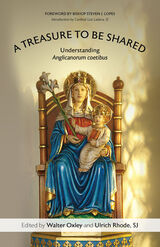 A Treasure to be Shared: Understanding Anglicanorum coetibus
Walter Oxley
Catholic University of America Press, 2022 A Treasure to Be Shared is intended to promote a more widespread knowledge of the Apostolic Constitution Anglicanorum coetibus, promulgated by Pope Benedict XVI in 2009. The Apostolic Constitution provided for Personal Ordinariates for Anglicans entering into full communion with the Catholic Church. On the occasion of the 10th anniversary of the Apostolic Constitution, an academic symposium in the year 2019 sponsored by the Pontifical Gregorian University and the Congregation for the Doctrine of the Faith, provided historical, liturgical, canonical and ecumenical perspectives on the fruits of the Apostolic Constitution for the wider Church. The hope is that the reader will see the Personal Ordinariates of The Chair of Saint Peter in the United States and Canada, Our Lady of Walsingham in Great Britain and Our Lady of the Southern Cross in Australia as a gift to the Church, and a treasure to be shared by all.
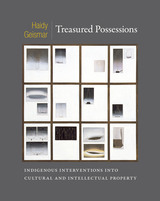 Treasured Possessions: Indigenous Interventions into Cultural and Intellectual Property
Haidy Geismar
Duke University Press, 2013 What happens when ritual practitioners from a small Pacific nation make an intellectual property claim to bungee jumping? When a German company successfully sues to defend its trademark of a Māori name? Or when UNESCO deems ephemeral sand drawings to be "intangible cultural heritage"? In Treasured Possessions, Haidy Geismar examines how global forms of cultural and intellectual property are being redefined by everyday people and policymakers in two markedly different Pacific nations. The New Hebrides, a small archipelago in Melanesia managed jointly by Britain and France until 1980, is now the independent nation-state of Vanuatu, with a population that is more than 95 percent indigenous. New Zealand, by contrast, is a settler state and former British colony that engages with its entangled Polynesian and British heritage through an ethos of "biculturalism" that is meant to involve an indigenous population of just 15 percent. Alternative notions of property, resources, and heritage—informed by distinct national histories—are emerging in both countries. These property claims are advanced in national and international settings, but they emanate from specific communities and cultural landscapes, and they are grounded in an awareness of ancestral power and inheritance. They reveal intellectual and cultural property to be not only legal constructs but also powerful ways of asserting indigenous identities and sovereignties.
The Treasurers of Athena
William Scott Ferguson
Harvard University Press Designed primarily for specialists in Ancient History, this monograph contains a history of the Athenian temples, of the properties entrusted to their care, and of the accounts and inventories which they inscribed on tablets and set up on the Acropolis. The author has been able to enlarge and strengthen knowledge of the general history of Athens in several directions, among these being the range of the so-called “secretary cycles,” the chronology of the last five years of the Peloponnesian War, and the administrative activities of Androtion and Lycurgus. The concluding chapter is an account of Athenian war finance from 434 B.C., to 295 B.C., the limits of the study.
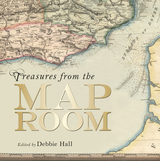 Treasures from the Map Room: A Journey through the Bodleian Collections
Edited by Debbie Hall
Bodleian Library Publishing, 2016 The Bodleian Library is home to one of the world’s largest and oldest collections of maps, with atlases, maps, and books on cartography dating back to the fourteenth century, including many that are among the most rare and historically significant.
Treasures from the Map Room publishes seventy-five extraordinary examples from this collection, housed in the Map Room at the newly renovated Weston Library. The maps reproduced in Treasures range from the fourteenth to the twenty-first century. Among them are the fourteenth-century Gough Map, the earliest road map of Great Britain that achieved a remarkable level of accuracy and detail for its time; fifteenth-century portolan charts intended for maritime navigation; the Selden Map of China, the earliest Chinese map to show shipping routes; and an important early map from the medieval Islamic Book of Curiosities. The book also includes a great many recent examples, including J. R. R. Tolkien’s map of Middle Earth and C. S. Lewis’s map of Narnia. Debbie Hall takes readers back in time to uncover the fascinating story of each treasure, from a map plotting outbreaks of cholera to a jigsaw map of India from the 1850s and silk escape maps carried by pilots flying missions over occupied Europe during World War II.
With lavish full-color photography and descriptions of each map’s provenance, purpose, and creation, Treasures from the Map Room is a beautiful and informative catalog of this remarkable collection.
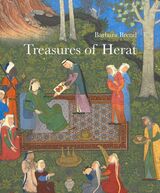 Treasures of Herat: Two Manuscripts of the Khamsah of Nizami in the British Library
Barbara Brend
Gingko, 2021 An illustrated reference book for students and scholars of Persian art, poetry, and literature.
With this book, Barbara Brend provides thorough consideration of two celebrated Persian manuscripts housed in the British Library. These two copies of the Khamsah (Quintet) a set of five narrative poems by twelfth-century poet Nizami, a master of allegorical poetry in Persian literature, were produced in Herat in the fifteenth century, one of the greatest periods of Persian painting. Although well known, the manuscripts have never before been written about in relation to each other. Brend tells the story of each poem and the painting that illustrates it, and she formally analyzes the images, placing them in their historical and artistic context.
The images from both highly prized manuscripts are beautifully reproduced in color, and the ownership history of one of the manuscripts—recorded in the form of seal impressions and inscriptions— is also included. Ursula Sims-Williams provides a translation and commentary of these important marks of ownership which identify the Mughal rulers Akbar, Jahangir, Shah Jahan, and Aurangzeb, among many others.
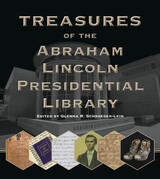 Treasures of the Abraham Lincoln Presidential Library
Edited by Glenna R. Schroeder-Lein
Southern Illinois University Press, 2014 Illinois State Historical Society Superior Achievement Award 2015
The Abraham Lincoln Presidential Library in Springfield, Illinois, houses a trove of invaluable historical resources concerning all aspects of the Prairie State’s past. Treasures of the Abraham Lincoln Presidential Library commemorates the institution’s 125-year history, as well as its contributions to scholarship and education by highlighting a selection of eighty-five treasures from among more than twelve million items in the library’s collections. After opening with a historical overview and extensive chronology of the Library, the volume organizes the treasures by various topics, including items that illustrate various locations and materials relating to business, the mid-nineteenth century and the Civil War, World Wars I and II, the oldest items, unusual treasures, ethnicity, and art. From the Gettysburg Address, Abraham and Mary Lincoln’s letters, and Governor Dan Walker’s boots to a Deering Harvester Company catalog, WPA publications, and an Adlai Stevenson I campaign hat, each entry includes a thorough description of the item, one or more images, and a discussion of its history and how the library acquired it, if known. Other treasures include the Thomas Yates General Store daybook, Dubin Pullman car materials, Civil War newspapers, a Lincoln coffin photograph, the Mary Lincoln insanity verdict, the Directory of Sangamon County’s Colored Citizens, andLincoln’s stovepipe hat. To highlight the academic importance of the Library, nineteen researchers share how study in the Library’s collections proved essential to their projects. Although these treasures only scrape the surface of the vast holdings of the Abraham Lincoln Presidential Library, together they epitomize the rich, varied, and sometimes quirky resources available to both serious scholars and curious tourists alike at this valuable cultural institution.
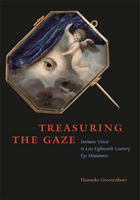 Treasuring the Gaze: Intimate Vision in Late Eighteenth-Century Eye Miniatures
Hanneke Grootenboer
University of Chicago Press, 2013 The end of the eighteenth century saw the start of a new craze in Europe: tiny portraits of single eyes that were exchanged by lovers or family members. Worn as brooches or pendants, these minuscule eyes served the same emotional need as more conventional mementoes, such as lockets containing a coil of a loved one’s hair. The fashion lasted only a few decades, and by the early 1800s eye miniatures had faded into oblivion. Unearthing these portraits in Treasuring the Gaze, Hanneke Grootenboer proposes that the rage for eye miniatures—and their abrupt disappearance—reveals a knot in the unfolding of the history of vision. Drawing on Alois Riegl, Jean-Luc Nancy, Marcia Pointon, Melanie Klein, and others, Grootenboer unravels this knot, discovering previously unseen patterns of looking and strategies for showing. She shows that eye miniatures portray the subject’s gaze rather than his or her eye, making the recipient of the keepsake an exclusive beholder who is perpetually watched. These treasured portraits always return the looks they receive and, as such, they create a reciprocal mode of viewing that Grootenboer calls intimate vision. Recounting stories about eye miniatures—including the role one played in the scandalous affair of Mrs. Fitzherbert and the Prince of Wales, a portrait of the mesmerizing eye of Lord Byron, and the loss and longing incorporated in crying eye miniatures—Grootenboer shows that intimate vision brings the gaze of another deep into the heart of private experience. With a host of fascinating imagery from this eccentric and mostly forgotten yet deeply private keepsake, Treasuring the Gaze provides new insights into the art of miniature painting and the genre of portraiture.
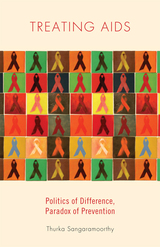 Treating AIDS: Politics of Difference, Paradox of Prevention
Sangaramoorthy, Thurka
Rutgers University Press, 2014 There is an inherently powerful and complex paradox underlying HIV/AIDS prevention—between the focus on collective advocacy mobilized to combat global HIV/AIDS and the staggeringly disproportionate rates of HIV/AIDS in many places. In Treating AIDS, Thurka Sangaramoorthy examines the everyday practices of HIV/AIDS prevention in the United States from the perspective of AIDS experts and Haitian immigrants in South Florida. Although there is worldwide emphasis on the universality of HIV/AIDS as a social, political, economic, and biomedical problem, developments in HIV/AIDS prevention are rooted in and focused exclusively on disparities in HIV/AIDS morbidity and mortality framed through the rubric of race, ethnicity, and nationality. Everyone is at equal risk for contracting HIV/AIDS, Sangaramoorthy notes, but the ways in which people experience and manage that risk—and the disease itself—is highly dependent on race, ethnic identity, sexuality, gender, immigration status, and other notions of “difference.”
Sangaramoorthy documents in detail the work of AIDS prevention programs and their effect on the health and well-being of Haitians, a transnational community long plagued by the stigma of being stereotyped in public discourse as disease carriers. By tracing the ways in which public knowledge of AIDS prevention science circulates from sites of surveillance and regulation, to various clinics and hospitals, to the social worlds embraced by this immigrant community, she ultimately demonstrates the ways in which AIDS prevention programs help to reinforce categories of individual and collective difference, and how they continue to sustain the persistent and pernicious idea of race and ethnicity as risk factors for the disease.
 Treating the Brain: What the Best Doctors Know
Walter G. Bradley DM FRCP
Dana Press, 2009
Even in this information age, it is a daunting task to find clear, concise, and credible sources for essential medical facts. And for those dealing with the symptoms of often serious neurological disorders, finding trustworthy and straightforward information is gravely important.
Treating the Brain is precisely what has been missing for non-specialists. Focusing on the most common neurological conditions, it provides accurate, reliable information to patients, caregivers, and health practitioners from the neurologist whose professional text informs neurologists worldwide.. Walter G. Bradley, one of the nation’s foremost neurologists and the editor of the leading neurology textbook Neurology in Clinical Practice, navigates the complexities of the brain in highly accessible language. Treating the Brain is the definitive resource for patients, offering a coherent and up-to-date understanding of what physicians know about the brain. In the United States alone, one-quarter of all new consultations between patients and their family physician is a result of a neurological problem. Using case histories as examples, Treating the Brain explains the neurological examinations and tests and clinical features, causes, and treatments available for Alzheimer’s disease, migraines, stroke, epilepsy, Parkinson’s and other frequently diagnosed neurological disorders.
For anyone who has ever had a neurological symptom, from a headache to tingling hands, and for anyone with a personal interest in how the brain works in health and disease, Treating the Brain will prove to be a valuable, easy-to-read source of a wide-range of information.
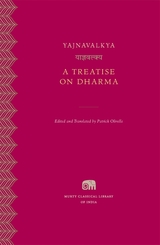 A Treatise on Dharma
Yajnavalkya
Harvard University Press, 2019 A new English translation of the most influential legal text in medieval India.
A Treatise on Dharma, written in the fourth or fifth century, is the finest example of the genre of dharmaśāstra—texts on religious, civil, and criminal law and the duties of rulers—that informed Indian life for a thousand years. It illuminates major cultural innovations, such as the prominence of documents in commercial and legal proceedings, the use of ordeals in resolving disputes, and the growing importance of yoga in spiritual practices.
Composed by an anonymous author during the reign of the imperial Guptas, the Treatise is ascribed to the Upanishadic philosopher Yajnavalkya, whose instruction of a group of sages serves as the frame narrative for the work. It became the most influential legal text in medieval India, and a twelfth-century interpretation came to be considered “the law of the land” under British rule.
This translation of A Treatise on Dharma, based on a new critical edition and presented alongside the Sanskrit original in the Devanagari script, opens the classical age of ancient Indian law to modern readers.
 Treatise on Divine Predestination
John Scottus Eriugena
University of Notre Dame Press, 1998 Treatise on Divine Predestination is one of the early writings of the author of the great philosophical work, Periphyseon (On the Division of Nature), Johannes Scottus (the Irishman), known as Eriugena (died c. 877 A.D.). It contributes to the age-old debate on the question of human destiny in the present world and in afterlife.
Eriugena's treatise was commissioned by two senior prelates in the Frankish kingdom of Charles II, grandson of Charlemagne. The Irishman was a teacher of the Liberal Arts at the Court of Charles during the Carolingian Renaissance in the mid-ninth century. The monastic and ecclesiastical authorities of the kingdom had become troubled by the potentially harmful effects of the preaching of the monk Gottschalk on the doctrine of Predestination.
Claiming to base his conclusions on some works of St. Augustine, Gottschalk was making a case for a dual or twin (gemina) predestination, discounting the operation of Free Will. When called upon to provide a refutation, Eriugena derived his counter-arguments from an interpretation of Augustinian writings based on Logic and Dialectic. The originality of his exposition, which stressed the impropriety of regarding God within a context of Time, and which formulated a benign view of eternal damnation, caused immediate confusion for his sponsors, followed by disappointment and rejection, as well as a measure of condemnation from other senior churchmen.
The debate produced some forceful writings in the decade between 850 and 860 but Eriugena's treatise appears to have received no further consideration in his lifetime. The work survives in a single manuscript of which editions were published in 1650 and 1853. It has been most recently edited in 1978. The present translation was made from that edition. Modern scholars are able to discern in this early work strong intimations of Eriugena's later major writings.
Mary Brennan was for eighteen years researcher and archivist at the Society for the Promotion of Eriugenian Studies, located at that time at University College Dublin. Her publications in this field since 1977 include Guide des Etudes Erigeniennes, A Bibliography of Publications in the Field of Eriugenian Studies 1800-1975, and Materials for the Biography of Johannes Scottus Eriugena.
----------
"The De divina praedestinatione liber was written in 850-51 at the request of two prelates while John the Scot resided at the court of Charles II, grandson of Charlemagne. It is his earliest attested work, a refutation of the heretical teaching of Gottschalk on double predestination. Both John and Gottschalk claimed to base their interpretation on St. Augustine, and both continued to be subjects of controversy during the decade between 850 and 860." --Theology Digest
"The book is elegantly produced and a delight to read and handle." --The Medieval Review,/i>, February 2001
Treatise On Laughter
Laurent Joubert, Translated by Gregory David de Rocher
University of Alabama Press, 1980 Laurent Joubert (b. 1529) was an important figure in the medical world of the French Renaissance. His monumental Treatise on Laughter provides categories and examples of the laughable. The work describes laughter, its causes and effects, its types and differences. His subdivisions and categories, along with their examples, furnish today's critic and reader with a Renaissance vision of comic commonplaces. It is this vision that may prove to be of great value in analyzing comic literature of the Renaissance.
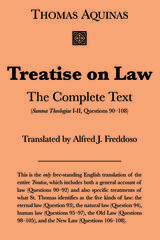 Treatise on Law: The Complete Text
Thomas Aquinas
St. Augustine's Press, 2009 This is a new English translation of St. Thomas Aquinas’s Treatise on Law, found in Questions 90–108 of the First Part of the Second Part of the Summa Theologiae. In fact, it is the only free-standing English translation of the entire Treatise, which includes both a general account of law (Questions 90–92) and also specific treatments of what St. Thomas identifies as the five kinds of law: the eternal law (Question 93), the natural law (Question 94), human law (Questions 95–97), the Old Law (Questions 98–105), and the New Law (Questions 106–108). All other extant editions of Treatise on Law stop with the human law, and are thus approximately one-third the size of the full Treatise.
St. Thomas’s account of law is firmly embedded within a general moral theory that begins with a rich conception of human flourishing, i.e., the good for human beings (Questions 1–5). This good consists, first and foremost, in our ultimate and intimate union with the Persons of the Blessed Trinity – a union that in our present state we can grasp intellectively and pursue affectively only with God’s supernatural assistance. It is within this framework that we order our loves and pursue the more proximate goals they open up to us as human beings in this life. Given the appropriate goals, the next question is how we can get from where we are, in the grips of the consequences of Original Sin, to where we want to be. The answer is: by means of (a) human actions that are good, i.e., rightly ordered toward our ultimate end and (b) the habits that these actions either engender or flow from. In analyzing human actions (Questions 6–21) and their relation to the passions (Questions 22–48), St. Thomas gives a general account of what he calls the ‘intrinsic principles’ of human actions and their associated habits – both virtues (Questions 49–70) and vices (Questions 71–89). It is only then that he turns to what he calls the ‘extrinsic principles’ of good human actions, viz., law (Questions 90–108) and grace (Questions 109–114).
According to St. Thomas, law, far from supplanting virtue as a basic principle of action, serves as an independent principle of action that complements virtue and is itself capable of being factored into practical deliberation. The reason is that all of God’s
precepts, prohibitions, and punishments are aimed at promoting the good of the whole universe and, more particularly, the good for human beings, both individually and within the various forms of social life. Because of this, law serves as both a restraint on bad actions and a spur to good action, i.e., a restraint on actions that take us away from virtue and genuine human flourishing and a spur to actions that promote virtue and flourishing.
There are many benefits of having the whole treatise rather than just the first few questions, as has been the standard practice in previous editions of the Treatise on Law. To mention just a few of these benefits, the question on the moral precepts of the Old Law (question 100) helps to illuminate in many different ways the earlier questions on natural law and human law (questions 94–97). Again, the questions on the ceremonial and judicial precepts of the Old Law (questions 101–105) demon-strate in depth the symbiotic relationship that St. Thomas takes to obtain between the Old Testament and the New Testament. The questions on the New Law provide an introduction to the Christian way of life that will be described in incomparable detail in the Second Part of the Second Part, the bulk of which is structured around the treatment of the three theological virtues and the four cardinal virtues.
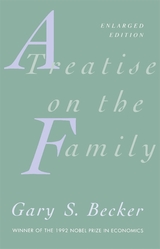 A Treatise on the Family: Enlarged Edition
Gary S. Becker
Harvard University Press, 1991 Imagine each family as a kind of little factory—a multiperson unit producing meals, health, skills, children, and self-esteem from market goods and the time, skills, and knowledge of its members. This is only one of the remarkable concepts explored by Gary S. Becker in his landmark work on the family. Becker applies economic theory to the most sensitive and fateful personal decisions, such as choosing a spouse or having children. He uses the basic economic assumptions of maximizing behavior, stable preferences, arid equilibria in explicit or implicit markets to analyze the allocation of time to child care as well as to careers, to marriage and divorce in polygynous as well as monogamous societies, to the increase and decrease of wealth from one generation to another.
The consideration of the family from this perspective has profound theoretical and practical implications. For example, Becker’s analysis of assortative mating can be used to study matching processes generally. Becker extends the powerful tools of economic analysis to problems once considered the province of the sociologist, the anthropologist, and the historian. The obligation of these scholars to take account of his work thus constitutes an important step in the unification of the social sciences.
A Treatise on the Family will have an impact on public policy as well. Becker shows that social welfare programs have significant effects on the allocation of resources within families. For example, social security taxes tend to reduce the amount of resources children give to their aged parents. The implications of these findings are obvious and far-reaching. With the publication of this extraordinary book, the family moves to the forefront of the research agenda in the social sciences.
 A Treatise on the Guaraní System of Government in Comparison with Plato’s Republic (1793)
Josep Manuel Peramàs
Harvard University Press, 2024 The Guaraní-Jesuit communities of greater Paraguay, in existence from 1609 until 1767, represent a unique collaboration between Indigenous and European peoples in the history of the Americas. Reports of these communities were met with fascination in Europe, as readers saw in them an opportunity to build a new political system from the ground up, one unencumbered by the entrenched norms that stymied reform in Europe. European intellectuals mythologized these communities, employing ancient Greek paradigms to characterize—and caricature—them within the context of a broader ideological conflation of antiquity and the Americas.
Josep Manuel Peramàs’s De Administratione Guaranica Comparate ad Rempublicam Platonis Commentarius (A Commentary on the Guaraní System of Government in Comparison with Plato’s Republic, 1793) emerges as a response to this European intellectual tradition. Written by a leading humanist scholar who lived among the Guaraní, the treatise offers a systems-level analysis of how the Guaraní-Jesuit communities were structured, interrogating formative aspects of the civic experience, such as weddings, public festivals, clothing, and political offices. In making this fascinating Latin treatise available in English for the first time, this bilingual edition offers new perspectives on the Guaraní and new avenues for exploring the complex legacy of classical literature in the Americas.
Treatises
Saint Cyprian
Catholic University of America Press, 1958 This volume presents several treatises of St. Cyprian (200/10?-258) in translation.
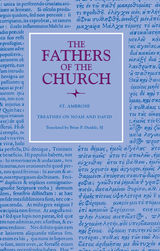 Treatises on Noah and David
St. Ambrose
Catholic University of America Press, 2020 These sermons by Ambrose of Milan (340–397 AD) provide a window into the preaching and scriptural exegesis of the legendary bishop, whose exposition of the Old Testament was instrumental in the conversion of Augustine of Hippo and in the development of Latin theology. In his treatise On Noah and his two Defenses for David, Ambrose borrows from influential Greek theologians, including Philo of Alexandria, Origen, and Didymus the Blind, while developing his own commentary on the exemplary patriarchs. Ambrose’s exegesis typifies both his attention to the letter of Scripture as well as his spiritual and allegorical reading of the holy figures or “saints” who lived before Christ.
The first treatise presents Noah as a model just man, as Ambrose pairs the literal and the higher or spiritual meaning of the Genesis flood narrative to address topics ranging from the Genesis narrative to Stoic ethics to the Incarnation. In his defense of David to the emperor Theodosius, Ambrose ties David’s sin and repentance to his own close reading of Psalm 51(50), David’s plea for himself in his famous “Miserere.” While the authenticity of the third treatise included in the volume, the Second Apology of David, has long been challenged, recent scholarship suggests that it transmits Ambrose’s own preaching, which applies the lessons of David’s life to the situation of gentile unbelievers, Jews, and the church; even if it is the work of a later imitator, the Second Apology is a compelling and systematic treatment of the David’s sin and repentance as relevant to Christian morality and doctrine.
The three treatises, previously unavailable in English translation, broaden our understanding of exegesis in the Latin West and our interpretation of Ambrose as preacher and exegete.
Treatises on Various Subjects
Saint Augustine
Catholic University of America Press, 1952 The present volume consists of a collection of minor writings of St. Augustine often classified under the general title of 'Works of Moral and Practical Theology.'
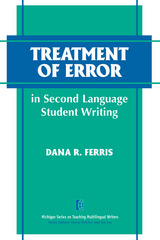 Treatment of Error in Second Language Student Writing
Dana R. Ferris
University of Michigan Press, 2002 Treatment of Error in Second Language Student Writing is the book many writing teachers have long been looking for: a highly accessible and principled approach to the theory and practice of error treatment that can guide pedagogical decision-making.
Unlike a teachers' manual or a handbook that purports to give all the answers needed, Ferris's research-based volume offers a solid scholarly foundation for the practical ideas presented together with an abundance of illustrative sample texts. This book will be a rich resource in language teaching methodology courses, but experienced teachers too will no doubt benefit from the depth and breadth of Ferris's coverage of various error response techniques as well as of the research that motivates those techniques.
Ferris offers a realistic, well-reasoned account of what second language (L2) writing teacher--or teachers with L2 students in their classes--need to know about error and how to put what they know to use. She persuasively addresses the fundamental error treatment questions that plague novice and expert writing specialists alike: What types of errors should teachers respond to? When should we respond to them? What are the most efficacious ways of responding to them? And ultimately, what role should error treatment play in the teaching of the process of writing?
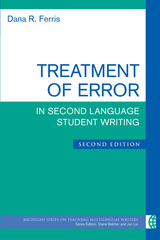 Treatment of Error in Second Language Student Writing, Second Edition
Dana R. Ferris
University of Michigan Press, 2011 Treatment of Error offers a realistic, well-reasoned account of what teachers of multilingual writers need to know about error and how to put what they know to use. As in the first edition, Ferris again persuasively addresses the fundamental error treatment questions that plague novice and expert writing specialists alike: What types of errors should teachers respond to? When should we respond to them? What are the most efficacious ways of responding to them? And ultimately, what role should error treatment play in the teaching of the process of writing? The second edition improves upon the first by exploring changes in the field since 2002, such as the growing diversity in what is called “L2 writers,” the blurring boundaries between “native” and “non-native” speakers of English, the influence of genre studies and corpus linguistics on the teaching of writing, and the need the move beyond “error” to “second language development” in terms of approaching students and their texts. It also explores what teacher preparation programs need to do to train teachers to treat student error. The second edition features
* an updating of the literature in all chapters
* a new chapter on academic language development
* a postscript on how to integrate error treatment/language development suggestions in Chapters 4-6 into a writing class syllabus
* the addition of discussion/analysis questions at the end of each chapter, plus suggested readings, to make the book more useful in pedagogy or teacher development workshops
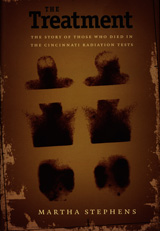 The Treatment: The Story of Those Who Died in the Cincinnati Radiation Tests
Martha Stephens
Duke University Press, 2002 The Treatment is the story of one tragedy of medical research that stretched over eleven years and affected the lives of hundreds of people in an Ohio city. Thirty years ago the author, then an assistant professor of English, acquired a large set of little-known medical papers at her university. These documents told a grotesque story. Cancer patients coming to the public hospital on her campus were being swept into secret experiments for the U.S. military; they were being irradiated over their whole bodies as if they were soldiers in nuclear war. Of the ninety women and men exposed to this treatment, twenty-one died within a month of their radiations.
Martha Stephens’s report on these deaths led to the halting of the tests, but local papers did not print her charges, and for many years people in Cincinnati had no way of knowing that lethal experiments had taken place there. In 1994 other military tests were brought to light, and a yellowed copy of Stephens’s original report was delivered to a television newsroom. In Ohio, major publicity ensued—at long last—and reached around the world. Stephens uncovered the names of the victims, and a legal action was filed against thirteen researchers and their institutions. A federal judge compared the deeds of the doctors to the medical crimes of the Nazis during World War II and refused to dismiss the researchers from the suit. After many bitter disputes in court, they agreed to settle the case with the families of those they had afflicted. In 1999 a memorial plaque was raised in a yard of the hospital.
Who were these doctors and why had they done as they did? Who were the people whose lives they took? Who was the reporter who could not forget the story, the young attorney who first developed the case, the judge who issued the historic ruling against the doctors? This is Stephens’s moving account of all that transpired in these lives and her own during this epic battle between medicine and human rights.
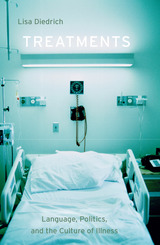 Treatments: Language, Politics, and the Culture of Illness
Lisa Diedrich
University of Minnesota Press, 2007 Creative expression inspired by disease has been criticized as a celebration of victimhood, unmediated personal experience, or just simply bad art. Despite debate, however, memoirs written about illness—particularly AIDS or cancer—have proliferated since the late twentieth century and occupy a highly influential place on the cultural landscape today. In Treatments, Lisa Diedrich considers illness narratives, demonstrating that these texts not only recount and interpret symptoms but also describe illness as an event that reflects wider cultural contexts, including race, gender, class, and sexuality. Diedrich begins this theoretically rigorous analysis by offering examples of midcentury memoirs of tuberculosis. She then looks at Susan Sontag’s Illness As Metaphor, Audre Lorde’s The Cancer Journals, and Eve Kosofsky Sedgwick’s “White Glasses,” showing how these breast cancer survivors draw on feminist health practices of the 1970s and also anticipate the figure that would appear in the wake of the AIDS crisis in the 1980s—the “politicized patient.” She further reveals how narratives written by doctors Abraham Verghese and Rafael Campo about treating people with AIDS can disrupt the doctor–patient hierarchy, and she explores practices of witnessing that emerge in writing by Paul Monette and John Bayley. Through these records of intensely personal yet universal experience, Diedrich demonstrates how language both captures and fails to capture these “scenes of loss” and how illness narratives affect the literary, medical, and cultural contexts from which they arise. Finally, by examining the ways in which the sick speak and are spoken for, she argues for an ethics of failure—the revaluation of loss as creating new possibilities for how we live and die. Lisa Diedrich is assistant professor of women’s studies at Stony Brook University.
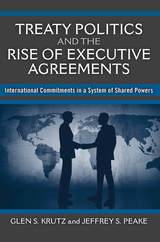 Treaty Politics and the Rise of Executive Agreements: International Commitments in a System of Shared Powers
Glen S. Krutz and Jeffrey S. Peake
University of Michigan Press, 2011 "Krutz and Peake's examination of the increase use of executive agreements offers a valuable lesson in how the president and Congress have responded and adjusted to the growth in the complexity of foreign relations to meet the demands of an ever-increasingly complex and interconnected international community."
---Victoria Farrar-Myers, University of Texas, Arlington "From reading Treaty Politics and the Rise of Executive Agreements, I learned a good deal about a topic that I thought I knew well. This book will be an excellent addition to the literature on the presidency. It will be read and cited by scholars working in this field."
---Benjamin Ginsberg, Johns Hopkins University "Glen Krutz and Jeffrey Peake's Treaty Politics and the Rise of Executive Agreements offers a provocative analysis of a neglected topic. Their theoretical and empirical challenge to the usual explanation for the growth of executive agreements, their careful analysis of the treaty process in the Senate and when that body can be decisive, and their assessment of the House of Representatives' role in the agreement process provide important new scholarship for students of the presidency, Congress, and foreign policy."
---James M. McCormick, Iowa State University In foreign relations, U.S. presidents have exercised a growing independence through the use of executive agreements. The U.S. Constitution specifies that two-thirds of the Senate must ratify a proposed treaty but makes no provision for other forms of international agreements. In 1942 the Supreme Court affirmed the legality of executive agreements, and since World War II, they have outnumbered treaties by more than ten to one. Are presidents trampling the Constitution or seeking to streamline the diplomatic process? Glen S. Krutz and Jeffrey S. Peake argue that the preference for executive agreements is the result of a symbiotic evolution of the executive and the legislative branches and that in order for the United States to survive in a complex, ever-changing global environment and maintain its world power status, it must fulfill international commitments swiftly and confidently. Members of Congress concur that executive agreements allow each branch to function more effectively. At the same time, the House continues to oversee particular policy areas, and presidents still submit the majority of the most significant international commitments to the Senate as treaties. Krutz and Peake conclude that executive agreements represent a mutual adaptation of the executive and the legislature in a system of shared power. Glen S. Krutz is Associate Director of the Carl Albert Center and Professor of Political Science at the University of Oklahoma. Jeffrey S. Peake is Professor and Department Chair, Department of Political Science at Clemson University.
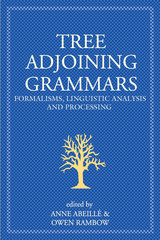 Tree Adjoining Grammars: Formalisms, Linguistic Analysis and Processing
Edited by Anne Abeillé and Owen Rambow
CSLI, 2000 Past research conducted on natural language syntax has occasionally employed the well-known mathematical formalism Context-Free Grammar, defined by Noam Chomsky in 1957. But recent studies have indicated that this approach may not always be ideal in analyzing all types of natural languages. Researchers in theoretical linguistics, psycholinguistics, cognitive science, and in natural language processing have recently converged on a collective insight: formalizing the syntax of words is central to describing, understanding, and analyzing language. This insight has sparked considerable interest in Tree Adjoining Grammar (TAG). Unlike traditional approaches for analyzing natural language syntax, TAG is a lexically-oriented mathematical formalism that can precisely capture the syntactic properties of natural languages such as English, French, and Korean. Tree Adjoining Grammars is the first ever collection of works that discusses the use of the TAG framework in natural language research. The volume begins with an introductory chapter that provides an overview of TAG and key research projects that have utilized the TAG framework in the past. Contributors discuss the formalism itself, its use in analyzing linguistic phenomena, and its use in building natural language processing systems. A glossary and extensive bibliography is included, allowing the volume to be accessible to a broad audience. The selection of works in this volume were presented at the Third International Workshop in Tree Adjoining Grammars and Related Formalisms held in Paris in 1994.
Tree Crops: A Permanent Agriculture
J. Russell Smith; Introduction by Wendell Berry
Island Press, 1987 A complete reference for growing high-yield fruit- and nut-bearing trees.
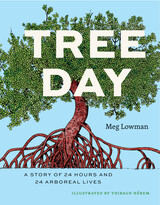 Tree Day: A Story of 24 Hours and 24 Arboreal Lives
Meg Lowman
University of Chicago Press, 2025 An hourly guide that spotlights twenty-four trees as they root, flower, and host diverse forest life.
In this short book, treetop explorer Meg Lowman guides us through a global forest. Each chapter of Tree Day introduces a single tree during a single hour, highlighting twenty-four species from around the world.
In the dark of Yemen’s night, it is too early to see the red sap from which the dragon’s blood tree gets its name. But if we watch closely, we will see nocturnal geckos carry the trees’ pollen in their snouts. Later, in the Pacific Northwest, we climb the world’s tallest species, the coastal redwood. The morning fog is a reminder that redwoods absorb water through their roots and canopies, helping them survive such heights. The sun is already low in the sky on an autumn afternoon. Given the darkness of this New England forest, the sugar maple’s leaves have stopped producing chlorophyll that converts light into energy—and green gives way to vivid crimson foliage. After many hours of boiling, the maple sap makes delicious maple syrup. As the sun sets in Mexico, we observe the origin of another treat, chocolate. The cocoa tree’s flowers sprout along its trunk and branches, allowing easy access for tiny insects like midges that pollinate the tree and start the process of making delicious food for humans, monkeys, bats, and squirrels. By the end of our tree day, we will understand that trees are the silent caretakers of our planet, providing us with medicines, foods, machinery for making fresh water and oxygen, and more.
For each hour, celebrated artist Thibaud Hérem has depicted these trees with gorgeous pen and ink illustrations. Working together to narrate and illustrate these unique moments in time, Lowman and Hérem have created an engaging read that is a perfect way to spend an hour or two—and a true gift for anyone who has ever looked up at a tree in wonder.
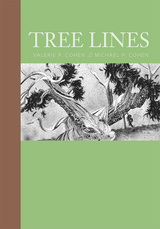 Tree Lines
Valerie P Cohen
University of Nevada Press, 2017 Tree Lines unites striking ink drawings of high-altitude pine trees with poetic vignettes about how people interact with mountain environments. The drawings and text work together to form a direct artistic encounter with timberline conifers. The husband and wife team of Valerie and Michael Cohen employ a unique process whereby she draws in isolation, gives him her drawings, and he then writes whatever he’s inspired to create. Neither offers the other any kind of feedback or instruction. The result is an accessible and deeply engaging work that is also extremely well researched; the Cohens bring a lifetime of scholarship in literature, history, and the environment to this work.
The drawings are black-and-white, pen-and-ink representations of high alpine ecosystems. The prose is stripped bare, abbreviated in an epigrammatic style that is poetic and spontaneous. Trees represented here are the Western Juniper or Sierra Juniper, the Limber, and the Bristlecone Pine—three species of long-lived, slow-growing conifers that grow across the Great Basin. While they represent only a small portion of the vegetative culture high in the western mountains, the Cohens use representation as abstraction as is utilized by writers and artists to convey a unique kind of microcosm of our natural environment. This book compares to such classics as Leopold’s A Sand County Almanac, and Berger’s Ways of Seeing, which open up lines of observation, analysis, and art for a new generation of readers.
Tree of Heaven
James Mckean
University of Iowa Press, 1995 This second book by James McKean displays a large, dignified, and precise talent—McKean is always looking and reaching out to the difficult world, pulling it to him for examination. Although beginning with outward themes of travels and crossings, Tree of Heaven circles in the end to the journeys of the inner life: the struggle to understand, the ability to see, to suffer the trials of illness and death, to survive love and longing, learning when to leave things as they are, when to let go. McKean's accomplished voice is quiet but firm, at times full of wonder, exploring the personal and discovering what salvation there is in rhythm and words.
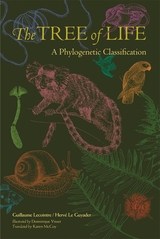 The Tree of Life: A Phylogenetic Classification
Guillaume Lecointre and Hervé Le GuyaderIllustrated by Dominique VissetTranslated by Karen McCoy
Harvard University Press, 2006 Did you know that you are more closely related to a mushroom than to a daisy? That crocodiles are closer to birds than to lizards? That dinosaurs are still among us? That the terms "fish," "reptiles," and "invertebrates" do not indicate scientific groupings? All this is the result of major changes in classification, whose methods have been totally revisited over the last thirty years.
Modern classification, based on phylogeny, no longer places humans at the center of nature. Groups of organisms are no longer defined by their general appearance, but by their different individual characteristics. Phylogeny, therefore, by showing common ancestry, outlines a tree of evolutionary relationships from which one can retrace the history of life.
This book diagrams the tree of life according to the most recent methods of classification. By showing how life forms arose and developed and how they are related, The Tree of Life presents a key to the living world in all its dazzling variety.,
The Tree of Life, Book One: On the Brink of the Precipice, 1939
Chava Rosenfarb
University of Wisconsin Press, 2004 On the Brink of the Precipice, the first volume of the trilogy The Tree of Life, describes the lives of the novel’s ten protagonists in the Lodz Ghetto before the outbreak of World War II. Chava Rosenfarb, herself a survivor of the Lodz Ghetto, Auschwitz, and Bergen-Belsen, draws on her own history to create realistic characters who struggle daily to retain a sense of humanity and dignity despite the physical and psychological effects of ghetto life. Although the novel depicts horrendous experiences, the light of faith in the human spirit shines through this novel’s every page.
Winner of the 1972 J. J. Segal Prize and the 1979 Manger Prize for Yiddish Literature
The Tree of Life, Book Three: The Cattle Cars Are Waiting, 1942–1944
Chava Rosenfarb
University of Wisconsin Press, 2006 The third volume in this powerful trilogy, The Cattle Cars Are Waiting follows the tragic fate of the inhabitants of the ghetto. Chava Rosenfarb, herself a survivor of the Lodz Ghetto, Auschwitz, and Bergen-Belsen, draws on her own history to create characters who struggle daily to retain a sense of humanity and dignity despite the physical and psychological effects of ghetto life. Although the novel depicts horrendous experiences, the light of faith in the human spirit shines through every page. Winner, Georges Bugnet Award for Best Novel, Writers Guild of Alberta
The Tree of Life, Book Two: From the Depths I Call You, 1940–1942
Chava Rosenfarb
University of Wisconsin Press, 2005 This volume describes the lives of the novel’s protagonists in the Lodz Ghetto at the beginning of World War II. Chava Rosenfarb, herself a survivor of the Lodz Ghetto, Auschwitz, and Bergen-Belsen, draws on her own history to create realistic characters who struggle daily to retain a sense of humanity and dignity despite the physical and psychological effects of ghetto life. Although horrendous experiences are depicted, the light of faith in the human spirit shines through this novel’s every page.
 Tree of Origin: What Primate Behavior Can Tell Us about Human Social Evolution
Frans B. M. de Waal
Harvard University Press, 2002 How did we become the linguistic, cultured, and hugely successful apes that we are? Our closest relatives--the other mentally complex and socially skilled primates--offer tantalizing clues. In Tree of Origin nine of the world's top primate experts read these clues and compose the most extensive picture to date of what the behavior of monkeys and apes can tell us about our own evolution as a species.
It has been nearly fifteen years since a single volume addressed the issue of human evolution from a primate perspective, and in that time we have witnessed explosive growth in research on the subject. Tree of Origin gives us the latest news about bonobos, the "make love not war" apes who behave so dramatically unlike chimpanzees. We learn about the tool traditions and social customs that set each ape community apart. We see how DNA analysis is revolutionizing our understanding of paternity, intergroup migration, and reproductive success. And we confront intriguing discoveries about primate hunting behavior, politics, cognition, diet, and the evolution of language and intelligence that challenge claims of human uniqueness in new and subtle ways.
Tree of Origin provides the clearest glimpse yet of the apelike ancestor who left the forest and began the long journey toward modern humanity.
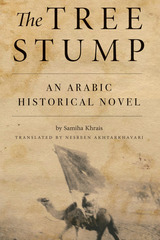 The Tree Stump: An Arabic Historical Novel
Samiha Khrais
Michigan State University Press, 2017 One of the most prominent Arabic novels to document the intricate details of the revolt of the Arabs against the Turks and their collaboration with the English, The Tree Stump brings to life a critical period of history that includes key players such as King Faisal, Odeh Abu Tayeh , and T. E. Lawrence. It places the reader in the heart of that remarkable era with accuracy, authenticity, and an added human dimension that introduces the Arabian Desert people, traditions, and way of life. Author Samiha Khrais weaves tribal customs, religion, politics, and love into a history with characters that actually walked the land, lived on the land, and fought the land’s war of independence with originality, pride, and wisdom. The novel stands witness to the lived experience of many Arabs in the region—experience that can still be seen today. The novel’s style, content, and strong human dimension makes it an exception literary work with regional flavor and global appeal.
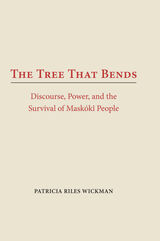 The Tree That Bends: Discourse, Power, and the Survival of Maskoki People
Patricia Riles Wickman
University of Alabama Press, 1999 A new paradigm for the interpretation of southeastern Native American and Spanish colonial history and a new way to view the development of the United States In her compelling and controversial arguments, Wickman rejects the myths that erase Native Americans from Florida through the agency of Spaniards and diseases and make the area an empty frontier awaiting American expansion. Through research on both sides of the Atlantic and extensive oral history interviews among the Seminoles of Florida and Oklahoma, Wickman shatters current theories about the origins of the people encountered by the Spaniards and presents, for the first time ever, the Native American perspective. She describes the genesis of the groups known today as Creek, Seminole, and Miccosukee—the Maskoki peoples—and traces their common Mississippian heritage, affirming their claims to continuous habitation of the Southeast and Florida. Her work exposes the rhetoric of conquest and replaces it with the rhetoric of survival.
An important cross-disciplinary work, The Tree That Bends reveals the flexibility of the Maskoki people and the sociocultural mechanisms that allowed them to survive the pressures introduced at contact. Their world was capable of incorporating the New without destroying the Old, and their descendants not only survive today but also succeed as a discrete culture as a result.
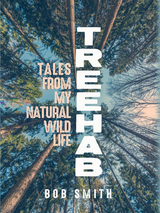 Treehab: Tales from My Natural, Wild Life
Bob Smith
University of Wisconsin Press, 2016 In this bitingly funny and often surprising memoir, award-winning author and groundbreaking comedian Bob Smith offers a meditation on the vitality of the natural world—and an intimate portrait of his own darkly humorous and profoundly authentic response to a life-changing illness.
In Treehab—named after a retreat cabin in rural Ontario—Smith muses how he has “always sought the path less traveled.” He rebuffs his diagnosis of ALS as only an unflappable stand-up comic could (“Lou Gehrig’s Disease? But I don’t even like baseball!”) and explores his complex, fulfilling experience of fatherhood, both before and after the onset of the disease.
Stories of his writing and performing life—punctuated by hilariously cutting jokes that comedians tell only to each other—are interspersed with tales of Smith’s enduring relationship with nature: boyhood sojourns in the woods of upstate New York and adult explorations of the remote Alaskan wilderness; snakes and turtles, rocks and minerals; open sky and forest canopy; God and friendship—all recurring touchstones that inspire him to fight for his survival and for the future of his two children.
Aiming his potent, unflinching wit at global warming, equal rights, sex, dogs, Thoreau, and more, Smith demonstrates here the inimitable insight that has made him a beloved voice of a generation. He reminds us that life is perplexing, beautiful, strange, and entirely worth celebrating.
Trees & Shrubs of the Trans-Pecos and Adjacent Areas
By A. Michael Powell
University of Texas Press, 1997 First published by the Big Bend Natural History Association in 1988 as Trees & Shrubs of Trans-Pecos Texas, this book is the only keyed guide to the more than 400 species of woody plants native to the Trans-Pecos region and adjacent areas in eastern New Mexico and northern Mexico. A. Michael Powell has significantly revised and expanded this edition, including nomenclature changes for 62 genera and new distribution information for 60 genera.
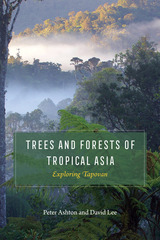 Trees and Forests of Tropical Asia: Exploring Tapovan
Peter Ashton and David Lee
University of Chicago Press, 2022 Informed by decades of researching tropical Asian forests, a comprehensive, up-to-date, and beautifully illustrated synthesis of the natural history of this unique place.
Trees and Forests of Tropical Asia invites readers on an expedition into the leafy, humid, forested landscapes of tropical Asia—the so-called tapovan, a Sanskrit word for the forest where knowledge is attained through tapasya, or inner struggle. Peter Ashton and David Lee, two of the world’s leading scholars on Asian tropical rain forests, reveal the geology and climate that have produced these unique forests, the diversity of species that inhabit them, the means by which rain forest tree species evolve to achieve unique ecological space, and the role of humans in modifying the landscapes over centuries. Following Peter Ashton’s extensive On the Forests of Tropical Asia, the first book to describe the forests of the entire tropical Asian region from India east to New Guinea, this new book provides a more condensed and updated overview of tropical Asian forests written accessibly for students as well as tropical forest biologists, ecologists, and conservation biologists.
 Trees Became Torches: SELECTED POEMS
Edwin Rolfe. Edited by Cary Nelson and Jefferson Hendricks
University of Illinois Press, 1995 "Rolfe's voice is one that many of us feared was buried forever.
. . . He stands in the forefront of an entire 'lost generation' of left-wing
writers who fused artistic craft with irrepressible political commitment."
-- Alan Wald, author of The Responsibility of Intellectuals: Selected
Essays on Marxist Traditions in Cultural Commitment
"[Rolfe's] Spanish Civil War poems may be the best written by an
American writer, and his McCarthy era poems brilliantly counteract the
often apolitical, rather socially aseptic poetry of their time."
-- Reginald Gibbons, editor of TriQuarterly
The radical journalist and poet Edwin Rolfe wrote eloquently of the hardships
of the Great Depression, the experience of war, and McCarthy era witch-hunts.
More than fifty of his best poems--some beautifully lyrical and some devastatingly
satiric--are included in Trees Became Torches. Rolfe was widely
known as the poet laureate of the Abraham Lincoln Battalion, the Americans
who volunteered to help defend the elected Spanish government during the
1936-39 civil war.
 Trees Dream of Water: Selected and New Poems
Leo Romero; Foreword by Joy Harjo
University of Arizona Press, 2025 “The poems in this collection began as a search for a history of my ancestors in a small, isolated valley in northern New Mexico. But no one wrote it down, and I was left to construct a poetic history where there were no written records . . .”
Leo Romero stands as a foundational figure in Latino letters. With six books of poetry and a book of short fiction to his name, Romero’s contribution to the literary canon is profound and enduring.
Bringing together for the first time his new and selected poems, Trees Dream of Water reflects Romero’s journey from youth to maturity as a person and a poet, and his deep connection to New Mexico and its culture. Traversed by memory, myth, and observation of the natural world, these poems explore family, community belonging and conflict, life as an artist, and the cycles of life and death. This lyrical anthology includes accompanying essays to illuminate Romero’s life and work for longtime admirers and new readers alike.
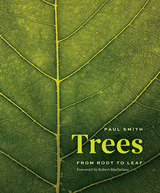 Trees: From Root to Leaf
Paul Smith
University of Chicago Press, 2022 Trees seen like never before—a world expert presents a stunning compendium, illuminating science, conservation, and art. Trees provoke deep affection, spirituality, and creativity. They cover about a third of the world’s land and play a crucial role in our environmental systems—influencing the water, carbon, and nutrient cycles and the global climate. This puts trees at the forefront of research into mitigating our climate emergency; we cannot understate their importance in shaping our daily lives and our planet’s future. In these lavish pages, ecologist Paul Smith celebrates all that trees have inspired across nearly every human culture throughout history. Generously illustrated with over 450 images and organized according to tree life cycle—from seeds and leaves to wood, flowers, and fruit—this book celebrates the great diversity and beauty of the 60,000 tree species that inhabit our planet. Surprising photography and infographics will inspire readers, illustrating intricate bark and leaf patterns, intertwined ecosystems, colorful flower displays, archaic wooden wheels, and timber houses. In this lavishly illustrated book, Smith presents the science, art, and culture of trees. As we discover the fundamental and fragile nature of trees and their interdependence, we more deeply understand the forest without losing sight of the magnificent trees.
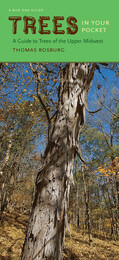 Trees in Your Pocket: A Guide to Trees of the Upper Midwest
Thomas Rosburg
University of Iowa Press, 2012 Valued for their lumber, their shade, and the beauty of their flowers and foliage as well as the nuts that nourish wildlife and humans alike, trees play important economic, ecological, and aesthetic roles in our lives. From honey and black locusts to white and chinkapin oaks to yellow and river birches, Trees in Your Pocket gives us identification and natural history information for about forty prominent deciduous species found in the Upper Midwest states of Minnesota, Wisconsin, Illinois, Iowa, and Missouri. Botanist Tom Rosburg provides diagnostic color photographs of leaves, acorns and other fruits, and bark along with descriptions of leaves, fruits, and measurements of blades. The composition, arrangement, shape, and margin of leaves are most important for tree identification. Fruits can help confirm identification of species with similar leaves. The bark of a tree can be very helpful for identifying some species; as a tree ages, older bark (lower on the tree) can be quite different from younger bark (higher and on branches). In addition to these essential markers, Rosburg gives information about the range, habitat—savannas, moist forests, dry slopes, sandy soils, and so on—life-span, and tolerance of shade, fire, drought, and flood. Each state in this region maintains a Big Tree program that honors the largest individual tree of each species. Champion trees are determined by adding together measurements of trunk circumference, height, and canopy spread. Rosburg identifies the trees with the largest diameter and the tallest trees among the champion trees in the Upper Midwest by their county and state. Together his superb photographs and key information make this guide the perfect companion for enjoying the diversity of trees in all kinds of environments.
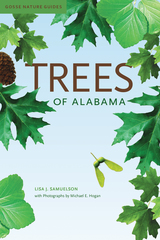 Trees of Alabama
Lisa J. Samuelson, with Photographs by Michael E. Hogan
University of Alabama Press, 2020 An easy-to-use guide to the most common trees in the state
From the understory flowering dogwood presenting its showy array of white bracts in spring, to the stately, towering baldcypress anchoring swampland with their reddish buttresses; from aromatic groves of Atlantic white-cedar that grow in coastal bogs to the upland rarity of the fire-dependent montane longleaf pine, Alabama is blessed with a staggering diversity of tree species. Trees of Alabama offers an accessible guide to the most notable species occurring widely in the state, forming its renewable forest resources and underpinning its rich green blanket of natural beauty.
Lisa J. Samuelson provides a user-friendly identification guide featuring straightforward descriptions and vivid photographs of more than 140 common species of trees. The text explains the habitat and ecology of each species, including its forest associates, human and wildlife uses, common names, and the derivation of its botanical name. With more than 800 full-color photographs illustrating the general form and habitat of each, plus the distinguishing characteristics of its buds, leaves, flowers, fruit, and bark, readers will be able to identify trees quickly. Colored distribution maps detail the range and occurrence of each species grouped by county, and a quick guide highlights key features at a glance.
This book also features a map of forest types, chapters on basic tree biology and terminology (with illustrative line drawings), a spotlight on the plethora of oak species in the state, and a comprehensive index. This is an invaluable resource for biologists, foresters, and educators and a great reference for outdoorspeople and nature enthusiasts in Alabama and throughout the southeastern United States.
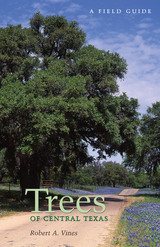 Trees of Central Texas
By Robert A. Vines
University of Texas Press, 1984 A comprehensive and compact field guide, Trees of Central Texas introduces 186 species of tree life in Central Texas, an area roughly the region of the Edwards Plateau and bordered by the Balcones Escarpment on the south and east, the Pecos River on the west, and the Texas Plains and the Llano Uplift on the north. From the hardy oaks and rugged mesquites to the graceful willows, cottonwoods, and pecans, the tree life of Central Texas varies as much as the vast and changing land that hosts it. Full descriptions and superb illustrations of all the native and naturalized trees of the region as well as fascinating bits of history and lore make this an essential guide to the wealth of tree life in Central Texas. Drawn from Robert A. Vines' monumental Trees, Shrubs, and Woody Vines of the Southwest (University of Texas Press), Trees of Central Texas combines the essential detail of the larger work with the ease and convenience of a field guide.
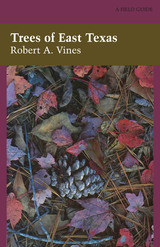 Trees of East Texas
By Robert A. Vines
University of Texas Press, 1977 This comprehensive and compact field guide covers the richest plant-life region in the state—the Upper Gulf Coast Prairie, the Post Oak Savannah, and the Pineywoods of east Texas. Eastern, northern, Gulf coast, and western Texas trees occur together in the Big Thicket area of the Pineywoods, where abundant rainfall and mild temperatures also make possible much tropical growth. Trees of East Texas is drawn from Robert A. Vines' monumental Trees, Shrubs, and Woody Vines of the Southwest (University of Texas Press, 1960). Without sacrificing the essential detail of the original work, this guide has been designed to travel info the field for on-the-spot identification. Meant to be carried and consulted, Trees of East Texas is conveniently organized, and virtually every description is accompanied by a finely executed illustration. This book contains new and updated information, and every native and naturalized tree in the area is identified. In addition to the technical descriptions, the author provides, in his "Remarks" sections, common names and fascinating bits of history and lore on each tree cited.
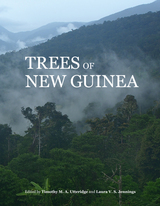 Trees of New Guinea
Edited by Timothy M. A. Utteridge and Laura V. S. Jennings
Royal Botanic Gardens, Kew, 2021 A botanical companion to the world’s most floristically diverse island: New Guinea.
New Guinea is the most floristically diverse island in the world, home to nearly 5,000 tree species alone. Trees of New Guinea details each of the 693 plant genera with arborescent members found in New Guinea, covering the entire region including the West Papua and Papua Provinces of Indonesia, Papua New Guinea, and the surrounding islands such as New Britain, New Ireland, and Bougainville. The book follows contemporary classifications and is richly illustrated with line drawings and color photographs throughout. Each group has a family description and key to the New Guinea tree genera, followed by a description of each genus, with notes on taxonomy, distribution, ecology, and diagnostic characters. Trees of New Guinea—winner of the Council on Botanical and Horticultural Libraries Literature’s 2022 Award for Excellence in Botany—is an essential companion for anyone studying or working in the region, including botanists, conservation workers, ecologists, and zoologists.
Trees of North Texas
By Robert A. Vines
University of Texas Press, 1982 This comprehensive and compact volume is a field guide to all the native and naturalized trees of the north Texas zone, including the Blackland Prairies, the Cross Timbers region, and both the Rolling and High Plains. Here too is detailed information on the many varieties of trees introduced into the Dallas-Fort Worth region over the twentieth century. Drawn from Robert A. Vines' monumental Trees, Shrubs, and Woody Vines of the Southwest (University of Texas Press, 1960), the field guide contains full descriptions of every tree in the area. Its convenient organization makes Trees of North Texas ideal to take into the field for on-the-spot identification, and virtually every description is accompanied by a finely executed illustration. Fascinating bits of history and lore enliven the descriptions throughout.
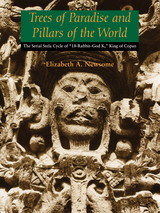 Trees of Paradise and Pillars of the World: The Serial Stelae Cycle of "18-Rabbit–God K," King of Copan
By Elizabeth A. Newsome
University of Texas Press, 2001 Assemblies of rectangular stone pillars, or stelae, fill the plazas and courts of ancient Maya cities throughout the lowlands of southern Mexico, Guatemala, Belize, and western Honduras. Mute testimony to state rituals that linked the king's power to rule with the rhythms and renewal of time, the stelae document the ritual acts of rulers who sacrificed, danced, and experienced visionary ecstasy in connection with celebrations marking the end of major calendrical cycles. The kings' portraits are carved in relief on the main surfaces of the stones, deifying them as incarnations of the mythical trees of life. Based on a thorough analysis of the imagery and inscriptions of seven stelae erected in the Great Plaza at Copan, Honduras, by the Classic Period ruler "18-Rabbit-God K," this ambitious study argues that stelae were erected not only to support a ruler's temporal claims to power but more importantly to express the fundamental connection in Maya worldview between rulership and the cosmology inherent in their vision of cyclical time. After an overview of the archaeology and history of Copan and the reign and monuments of "18-Rabbit-God K," Elizabeth Newsome interprets the iconography and inscriptions on the stelae, illustrating the way they fulfilled a coordinated vision of the king's ceremonial role in Copan's period-ending rites. She also links their imagery to key Maya concepts about the origin of the universe, expressed in the cosmologies and mythic lore of ancient and living Maya peoples.
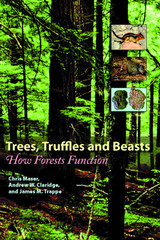 Trees, Truffles, and Beasts: How Forests Function
Maser, Chris
Rutgers University Press, 2008 In today's world of specialization, people are attempting to protect the Earth's fragile state by swapping limousines for hybrids and pesticide-laced foods for organic produce. At other times, environmental awareness is translated into public relations gimmicks or trendy commodities. Moreover, simplistic policies, like single-species protection or planting ten trees for every tree cut down, are touted as bureaucratic or industrial panaceas.
Because today's decisions are tomorrow's consequences, every small effort makes a difference, but a broader understanding of our environmental problems is necessary to the development of sustainable ecosystem policies. In Trees, Truffles, and Beasts, Chris Maser, Andrew W. Claridge, and James M. Trappe make a compelling case that we must first understand the complexity and interdependency of species and habitats from the microscopic level to the gigantic. Comparing forests in the Pacific Northwestern United States and Southeastern mainland of Australia, the authors show how easily observable speciesùtrees and mammalsùare part of a complicated infrastructure that includes fungi, lichens, and organisms invisible to the naked eye, such as microbes.
Eminently readable, this important book shows that forests are far more complicated than most of us might think, which means simplistic policies will not save them. Understanding the biophysical intricacies of our life-support systems just might.
Trees, Why Do you Wait?: America's Changing Rural Culture
Richard Critchfield
Island Press, 1991 Richard Critchfield, author of the best-selling books Villages and An American Looks at Britain, examines the inescapable link between the decline of America's rural roots and the decay of our cities. Trees, Why Do You Wait? is a moving oral history chronicling the changes taking place in rural America. Through it, we meet real people of the heartland and feel the suffering and the strength in their relationship to the land.
 Trekking across America: An Up-Close Look at a Once-Popular Pastime
Lyell D. Jr. Henry
University of Iowa Press, 2024 For several decades following the end of the Civil War, the most popular sport in the United States was walking. Professional pedestrians often covered 500 miles or more for up to six grueling days and nights in pursuit of large money prizes. Walking was also a favorite amateur sport; newspapers often noted a “pedestrian mania” or “walking fever” that only began to give way in the mid-1880s to fast-rising crazes for baseball, bicycling, and roller skating.
As competitive walking faded, a new kind of spectacle walking, which had also begun in the late 1860s, came to full flower. Between 1890 and 1930, hundreds of men, women, even children and entire families were on the nation’s roads and railroad tracks trekking between widely separated points, sometimes moving in unusual ways such as on roller skates or by walking barefooted, backward, on stilts, or while rolling a hoop. To finance their attention-seeking journeys, many sold souvenir postcards. The public usually found these performers entertaining, but public officials and newspaper editors often denounced them as nuisances or frauds. Tapping vintage postcards and old newspaper articles, this is the first book to bring back to view this once-familiar feature of American life.
Trembling Air: Poems
Michelle Boisseau
University of Arkansas Press, 2003 In these poems, Michelle Boisseau troubles sound into music and light into color. She renders the physics of absence and the deceptions of presence: a garage full of haunted tools, the ordinary and odd lives embodied in medieval paintings, the voice of a father traveling on radio waves. The poems’ contemplative, rigorous intelligence affirms pleasure in the fallen world, picking out the golden thread in a dark tapestry. Moving through us in waves of light and sound, the words and trappings of the material world brim here with spiritual force and resonate with the power of things poised on the brink of revelation: trembling the air.
Tremors
Cammy Thomas
Four Way Books, 2021 Thomas’s short, musical poems make stops in the terrains of childhood, difficult and somewhat violent; middle life, with parents breaking down and children moving away into their own lives; and later life when memory falters but passion does not.
|
|
